
Home » Travel Guides » Poland » 25 Best Things to Do in Warsaw (Poland)

25 Best Things to Do in Warsaw (Poland)
It is not hyperbole to say that Warsaw is a city that has risen from the rubble. In 1945 85% of the city was irretrievably destroyed. But you could now walk the streets of the Old Town without comprehending the carnage that took place during the German invasion of 1939, the Warsaw Ghetto Uprising of 1943 and the general Warsaw Uprising a year later.
The human impact is harder to mend, and Warsaw has museums and monuments that give unflinching accounts of one of the darkest periods in European History. But there are also memories of the splendour of the Polish-Lithuanian Commonwealth of the Early Modern Age, when Warsaw was the capital of Europe’s largest empire. To see it, take the Royal Route, which threads through royal properties like Łazienki Park, a little world of palaces and pavilions in the middle of the city.
Let’s explore the best things to do in Warsaw :
1. Old Town

When you tour a historic city centre you’re normally out for genuine, untouched architecture and monuments.
But after Warsaw’s experiences in the 20th century, the magic of this quarter is in the detailed and faithful reconstruction carried out up to 1962. After almost nine tenths of the city was wiped out, the Old Town’s rebirth was an incredible feat that has earned it Old Town UNESCO World Heritage Status.
As you pick your way along alleys and passageways, past guildhalls, churches and burgher houses you’d never imagine that this was all just a pile of debris 70 years ago.
A couple of sights that we haven’t included on the list below are Canon Square, a triangular plaza enclosed by tenements that once houses canons of the Warsaw Chapter, and St John’s Archcathedral, holding the tomb of Stanisław II Augustus, the last King of Poland.
Available tour : Warsaw Old Town 1.5-Hour Segway Tour
2. Royal Route

It happens that nearly all of Warsaw’s historic landmarks are on a single axis beginning at the Castle Square and continuing south for 15 kilometres or so before arriving at Wilanów Palace.
On this line are churches, parks, palaces, academic institutions and plush townhouses.
The three residences that give the route its “royal” title are the Royal Castle at the top, Łazienki Palace in its stunning eponymous park, and Wilanów Palace at the southern terminus.
All three are absolutely essential, resonating with the wealth and might of the Polish-Lithuanian Commonwealth of the Renaissance and Baroque periods.
3. Łazienki Park

Warsaw’s largest park is an anchor on the Royal Route and is an excursion of choice for families and couples on the weekend.
The park started out as the royal baths (Łazienki translates to “baths”) and was enriched in the 18th century by a grand plan during the reign of King Stanisław II Augustus.
In these 76 leafy hectares are palaces, pavilions, two orangeries, an amphitheatre, a planetarium, follies, promenades, water features and monuments of national standing.
Hopping from one villa to the next, marvelling at the sumptuous Łazienki Palace, pottering around four museums or just relaxing in the greenery; a whole day could float by here in no time.
Maybe the most prestigious of the monuments is for the composer Frédéric Chopin, designed in 1907 in the Art Nouveau style, but delayed by the First World War and erected in 1926.
4. Old Town Market Place

Up to the creation of Stanisław II Augustus’ New Town at the end of the 18th century, this square was the epicentre of commercial life in Warsaw.
It is the most historic part of the Old Town and is enveloped by tall Renaissance and Baroque merchants’ houses in a spectrum of colours.
All of these buildings are post-war replicas of what came before, as the square was first bombed by the Luftwaffe and then blown up by the Germans at the end of the Warsaw Uprising in 1944. Immediately after the war the square was rebuilt as it had been, including the bizarre but charming vertical extensions that cap some of the houses.
The mermaid figure on the fountain in the centre holds special meaning for Warsaw, while in summer you can park up at a restaurant table and watch the city going about its day.
5. POLIN Museum of the History of Polish Jews

Seven years in the making, this museum fully opened in 2014 and documents the millennium-long history of the Jews in Poland.
POLIN is at the northern part of the former Warsaw ghetto in Muranów, and was designed by Finnish architect Rainer Mahlamäki.
In eight galleries, the core exhibition uses a mixture of genuine artefacts, reconstructions and interactive displays to explain how Poland became home for Europe’s largest Jewish community.
You can see a prayer book from 1272 with an early sentence written in Yiddish and find out about the golden age of religious tolerance in the 16th and 17th centuries.
Later comes the Holocaust, and in the gloom are stories about the heroic efforts of the Oyneg Shabbos group to archive the truth about the Warsaw ghetto.
Suggested tour : Warsaw Polin Museum Guided Tour
6. Royal Castle

At the southern entrance to the Old Town you’ll be met by the 90-metre facade of the Mannerist and Baroque castle, the seat of the Polish monarchs for hundreds of years.
The castle has come through an eventful 700 years involving two demolitions, one by the Swedes in the mid-17th century and another by the Germans in the Second World War.
Since the last reconstruction in the 1980s the castle has been a museum, where you can view the apartments of the 16th-century King Sigismund II Augustus, and visit the House of Parliament, the fountain-head of Polish democracy and where amendments made to the Polish-Lithuanian constitution ushered in unprecedented religious tolerance.
There’s also a collection of paintings from the 16th to the 18th century by masters like Rembrandt, van Dyck, Joos van Cleve and Gainsborough.
Book online : Tour of the Royal Castle in Warsaw
7. Castle Square

When Poland’s capital moved from Kraków to Warsaw in 1596 the square beside the castle became the cornerstone of the largest Empire in Renaissance Europe.
The man who brought about this switch was Sigismund III Vasa, who is commemorated by a bronze statue atop an 8.5-metre column.
This was first raised in 1644, but was toppled by the Germans in 1944 and its original red marble was replaced with granite.
There are still fragments of the marble column by the castle walls.
Some events that shook Poland have taken place here, like a bloody riot during the period of Martial Law in 1982, a massacre by the Russians during an uprising in 1861 and a speech by Bill Clinton welcoming Poland into NATO in 1997. Whether it’s a rally or concert there’s often something going on at Castle Square in summer.
8. Warsaw Uprising Museum

This museum of the Warsaw Uprising of August to October 1944 is in the converted former tramway power station in the Wola district.
On entering you can use pre-War telephone receivers to listen to the memories of participants in the uprising.
Among the many clever installations is the Kino palladium, a cinema showing the footage collected by the insurgents and screened at the Warsaw Palladium during the uprising.
There are also replicas of the sewers that the fighters used to get around, while ‘before and after’ photographs of the city bring home the ruthlessness of the German backlash.
9. Copernicus Science Centre

Poland’s top science museum opened in 2010 and has more than 400 interactive exhibits across six zones, each tackling a different field, from the Roots of Civilisation to the Lightzone, investigating the nature of light.
The World in Motion for instance has an earthquake simulator to try out as well as a moving model that showing a human skeleton on a bicycle.
At the Humans and the Environment zone you can find out about urban ecosystems, contruction technology.
There are also webcams beaming footage directly from a falcon’s nest at the Palace of Culture and Science, and the gorilla enclosure at the Warsaw Zoo.
The centre also has a state-of-the-art planetarium with a 3D sound system, screening shows about the cosmos, but also nature and human cultures.
10. Palace of Culture and Science

Whatever your opinion on this enormous building, it is practically ever-present in Warsaw.
At 237 metres the Palace of Culture and Science is the tallest building in Poland, and on its 42 floors are four theatres, a multi-screen cinema, two museums, the 3,000-seater Congress Hall, government offices, academic institutions and private companies.
Taking cues from Art Deco skyscrapers and Polish Historicism, this immense Stalinist complex was a ‘gift from the Soviet Union to the people of Poland’ in 1955, and that’s just one of the reasons it evokes mixed feelings.
If an international event is taking place in Warsaw there’s a good chance it will go down at the Congress Hall, while there’s an observation terrace on the 30th floor open 10:00-20:00 for the ultimate panorama of the city.
11. Łazienki Palace

On the artificial island in the lake at Łazienki Park is the sublime Classical palace conceived in the 18th century for King Stanisław II Augustus.
The property is a conversion of a Baroque bathing pavilion for Count Stanisław Herakliusz Lubomirski from the century before, and has kept some of the architecture from that first building.
The north facade has a portico at the shore of the lake, while the main entrance is in a recess with powerful Corinthian columns, while the roof is hemmed by a balustrade carrying statues of mythological figures.
The ground floor has lavishly decorated salons (The Solomon Room is a stand-out), and the Lower Gallery, has paintings by Jacob Jordaens, Rembrandt and Rubens.
Upstairs is the Upper Gallery, as well as the King’s splendid cabinet and bedchambers.
Included in this tour : Warsaw Half–Day Highlights Tour
12. Wilanów Palace

The palace at the southern end of the Royal Route came through the Second World War without a scratch.
So Wilanów Palace is a rare glimpse of the majesty of the Polish-Lithuanian Commonwealth before Poland was annexed by Prussia and Russia in the late-18th century.
This palace was intended as a summer escape for King Jan III Sobieski towards the end of the 17th century, and has all the hallmarks of Baroque palace architecture, including a parterre with two terraces boasting topiaries, broderie and statues symbolising love.
The exterior is laden with medallions, busts, statues and other Baroque ornamentation, while interior decor abounds with stuccowork, striking trompe-l’œil frescoes and chinoiserie.
High points are the sumptuous White Hall, traced by mirrors, the King’s Library, the King’s Bedroom and the North Gallery, flanked by statues and with magnificent ceiling frescoes.
13. Krakowskie Przedmieście

The most prestigious street in Warsaw makes its way southwards at the beginning of the Royal Route from near the Castle Square.
You’ll see palaces, dignified monuments and eminent Polish institutions like the Polish Academy of Sciences, Warsaw University and the Presidential Palace.
Across from the entrance to Bednarska Street is Warsaw’s second oldest standing monument, the Madonna of Passau.
This dates from 1683 and is a votive offering in thanks for King Jan III Sobieski’s role in the defeat of the Turks at the Battle of Vienna, in which he led the largest cavalry charge in the history of warfare.
14. National Museum

Warsaw’s biggest museum is also one of the largest in Poland and has a huge assortment of historical artefacts from many places and eras.
The collection of antiquities is noteworthy, made up of some 11,000 Egyptian, Greek and Roman pieces.
Also set aside an hour or two to see everything in the Faras Gallery.
This is furnished with Nubian early Christian frescoes, friezes and architectural elements brought here from the Egyptian-Sudanese border before the construction of the Aswan High Dam flooded the valley.
In the collection of Polish Medieval art from the 14th and 15th centuries are works produced for churches and cathedrals, including devotional paintings, altarpieces and sculptures.
And there’s also lots of art from the Early Modern Age and 19th century, by well-known names like Lucas Cranach the Elder, Brueghel the Elder, Rembrandt, Courbet and Renoir.
15. St Anne’s Church

One of the oldest landmarks in the city, St Anne’s Church on Krakowskie Przedmieście was founded in 1454. In the 17th century the church had to be rebuilt no fewer than four times, until receiving its final Neoclassical facade in 1788. In the niches between the columns and pilasters are statues of the Four Evangelists below a massive pediment.
The interior has kept hold of its theatrical Baroque design from a little earlier, and has spectacular frescoes on its barrel vault and has a nave edged by Corinthian pilasters with gilded capitals.
There are also regular organ recitals at St Anne’s, well worth catching.
16. Taras Widokowy na Stare Miasto (Viewing Platform in the Old Town)

St Anne’s Church has a stand alone bell tower, which will provide you with another vantage point over the city.
In fact, this tower may even be better than the Palace of Culture and Science, as it’s planted on the edge of the Old Town and has regal Baroque architecture.
If you can brave the 147 steps you’ll be rewarded by a bird’s eye view of the Castle, Castle Square, the Old Town to the north and Krakowskie Przedmieście to the south.
17. Tomb of the Unknown Soldier

In Piłsudski Square, the largest in Warsaw, is a monument for unidentified soldiers who have died fighting for Poland.
The tomb dates to 1925, and contains the body of a soldier who fell in the Battle of Lemberg of 1918-1919 between Poland and the West Ukrainian People’s Republic.
The monument housing the tomb is a fragment (three arches) from the arcade that once belonged to the Saxon Palace, demolished after the Warsaw Uprising.
Under the central arch is the tomb and eternal flame, watched by the Representative Honour Guard Battalion of the Polish Armed Forces.
At the stroke of every hour 365 days a year the guard is changed.
The monument and square are the focus of ceremonies for the Polish Armed Forces Day every 15 August.
18. Jewish Ghetto Memorial

By the Museum of the History of the Polish Jews is a monument to the Warsaw Ghetto Uprising of 1943. On the square below the wall is a circular plaque inscribed with the message: ” Those who fell in the unprecedented heroic struggle for the Dignity and Freedom of the Jewish people, for Free Poland, for the liberation of man – Polish Jews”, in Polish, Yiddish and Hebrew.
This was unveiled in 1946 and is encased in red sandstone to symbolise the bloodshed.
The wall behind came later, in 1948, designed by Natan Rapaport and intended to resemble Jerusalem’s Western Wall and the wall of the Warsaw Ghetto.
On the eastern side of the monument a bronze bas-relief depicts Jewish children, women and elderly being driven by German soldiers.
On the west side the monument shows the uprising of April 1943 with a relief titled “Fight”.
Recommended tour : 3-Hour Tour of Jewish Warsaw
19. Okopowa Street Jewish Cemetery

At 33 hectares this Jewish burial ground, dating back to 1806, is one of the largest in the world.
There are over 250,000 marked graves at Okopawa Street Cemetery, as well as several mass graves for those who were killed during the Warsaw Ghetto.
Nature has taken over large swathes of the site, which, along with the Art Nouveau and Historicist monuments, makes the cemetery equal parts beautiful and poignant.
Something interesting about this place is that it was drawn up for Jewish people of all affiliations, so there are allocated areas known as “Quarters” for military burials, Orthodox burials (for men, women and holy scriptures), reform Judaism and children.
After the Second World War a small corner of the cemetery was reopened for Warsaw’s returning Jewish population.
20. Zachęta

At Plac Małachowskiego is a solemn gallery built in 1900 and dedicated to modern and contemporary Polish art.
Since its foundation in 1860 the Society for the Encouragement of Fine Arts has had the job of promoting fine art in Poland.
In its early years some of the nation’s most celebrated painters like Jan Matejko and Wojciech Gerson staged exhibitions Zachęta.
And in the same vein, it remains a shortcut to Poland’s art scene via temporary exhibitions for up-and-coming talent and established names like Katarzyna Kozyra and Krzysztof Wodiczko.
In the permanent collection are pieces by leading post-war artists like the painter and set-designer Tadeusz Kantor and the Surrealist Jewish sculptor Alina Szapocznikow.
21. Nowy Świat Street

Also on the Royal Route, this one-kilometre artery leads southwards from Krakowskie Przedmieście down to Three Crosses Square.
Nowy Świat Street’s origins lie in the 16th century when it was first used by the upper class to reach their properties in the countryside south of the old town.
As Warsaw grew, the city’s wealthier and aristocratic residents built homes along the street.
And by Napoleonic times these were remodelled from half-timbered buildings into fine Neoclassical mansions and villas.
The thoroughfare has cafes, upmarket shops and international retailers like Sephora by day, and lots of nightspots with international clientele when the sun goes down.
22. Copernicus Monument

The monument for the trailblazing Renaissance astronomer and mathematician stands proud in front of the Polish Academy of Sciences at Stazsic Palace.
The work shows Copernicus with a compass and armillary sphere and was fashioned by Bertel Thorvaldsen, maybe the leading sculptor in Europe of the day.
It was presented to the public in 1830 and had an uneventful first century until the Second World War.
Not long after entering the city in 1939 the German authorities replaced the Latin and Polish inscriptions with a one in the German language, leading to a tit-for-tat campaign between the Polish resistance and the occupiers.
After the uprising in 1944 it was removed to the city of Nysa to be melted down, but by then the German army was in retreat and the statue could be rescued and returned to its rightful place.
23. Holy Cross Church

Another of the head-turning sights on Krakowskie Przedmieście, the Holy Cross Church is a Baroque monument built in the first half of the 18th century to a design by the royal court architect Józef Szymon Bellotti.
The church was badly damaged in the Warsaw Uprising and was later blown up by the German army in 1945. And when it was rebuilt right after the war the design was simplified and didn’t include the frescoes and polychrome statues that came before.
But there’s still a very good reason to pay a visit: In accordance with his will, Frédéric Chopin’s heart was brought to this church by his sister in an urn, and embedded in a pillar in one of the chapels.
24. Warsaw University Library Garden

A few steps back from the Vistula River, Warsaw University’s library is strange to behold from ground level: There’s a long and austere stone facade and a blue scaffold-like porch that could be from the Pompidou Centre.
But up the exterior stairway is one of the largest roof gardens in Europe.
Open from March to November, this one-hectare space is a little dreamland of fountains, streams, pergolas, arbours and lawns, while the library’s windows and skylights add a touch of the surreal.
This is all the work of landscape architect Irena Bajersaka and opened in 2002. The city views are also fantastic, encompassing the Vistula, the recent PGE National Stadium and the Copernicus Centre.
25. Saxon Garden

When Saxon Garden off Piłsudski Square opened its gates to the public in 1727 it became one of the first public parks in the World.
It had been landscaped in the 17th century for the Saxon Palace, which was lost in the Second World War, along with the Rococo Brühl Palace that also backed onto the park.
In its first century Saxon Garden was a Baroque parterre in the style of Versailles, but has been an English landscape park since the 19th century.
Seek out the park’s sandstone allegorical sculptures, fashioned in the mid-18th century.
Twenty remain from an initial 70, and you can try to work out what each one symbolises (Intellect, Justice, Astronomy, Painting and Poetry are all pretty easy to decipher).
25 Best Things to Do in Warsaw (Poland):
- Royal Route
- Łazienki Park
- Old Town Market Place
- POLIN Museum of the History of Polish Jews
- Royal Castle
- Castle Square
- Warsaw Uprising Museum
- Copernicus Science Centre
- Palace of Culture and Science
- Łazienki Palace
- Wilanów Palace
- Krakowskie Przedmieście
- National Museum
- St Anne's Church
- Taras Widokowy na Stare Miasto (Viewing Platform in the Old Town)
- Tomb of the Unknown Soldier
- Jewish Ghetto Memorial
- Okopowa Street Jewish Cemetery
- Nowy Świat Street
- Copernicus Monument
- Holy Cross Church
- Warsaw University Library Garden
- Saxon Garden
Warsaw Travel Guide
Courtesy of jacek_kadaj | Getty Images

9 Best Things To Do in Warsaw
Updated January 11, 2024
If you're not a history and culture buff, consider vacationing elsewhere. Poland's capital city is filled with educational attractions, most of which are museums. Some (like the POLIN Museum of the History of Polish Jews and the Warsaw
- All Things To Do

Old Town (Stare Miasto) Old Town (Stare Miasto) free
Warsaw's central Old Town neighborhood is one of the city's most popular areas and a UNESCO World Heritage Site. This historic district, which was rebuilt after bombings from World War II destroyed most of it, is filled with restaurants, art galleries, shops and cafes housed in structures designed to replicate the region's former 14th- to 18th-century buildings. Old Town is also where attractions like The Royal Castle in Warsaw - Museum and the King Zygmunt III Waza Column, among other landmarks, reside.
Travelers love Old Town's lively atmosphere and charming buildings, adding that the neighborhood is a prime spot for shopping, people-watching and getting your caffeine fix. However, the area is often packed with tourists, so expect higher prices at the restaurants lining the square. If you don't want to rub elbows with other visitors, consider arriving early (before 10 a.m.).

Lazienki Królewskie Museum (Muzeum Lazienki Królewskie) Lazienki Królewskie Museum (Muzeum Lazienki Królewskie)
The 188-acre Lazienki Królewskie Museum is one of Warsaw's most scenic locales. Here, you can go for a leisurely stroll through gardens, explore former palaces, admire various works of art or even catch a free piano concert (by the attraction's Frédéric Chopin monument). You'll also find amenities like a restaurant, gift shops and an amphitheater on-site.
Recent travelers raved about the Lazienki Królewskie Museum, citing its "lovely park" and "impressive" palaces – especially the Palace on the Isle – as highlights. However, several cautioned that the property can get crowded on weekends, so claim your spot early if you plan on attending one of the free piano concerts, which take place at noon and 4 p.m. every Sunday from May through September.

POLIN Museum of the History of Polish Jews (POLIN Muzeum Historii Zydów Polskich) POLIN Museum of the History of Polish Jews (POLIN Muzeum Historii Zydów Polskich)
Though several Warsaw sights (think: the Warsaw Uprising Museum and the Warsaw Uprising Monument ) pay homage to Polish Jews who lost their lives during World War II, one of the city's best attractions for learning about the country's Jewish population is the POLIN Museum of the History of Polish Jews. Inside, travelers will see collections about Poland's earliest Jews, the Holocaust and more. Temporary exhibits that focus on everything from the meaning of blood in Jewish culture to the Jewish community's impact on popular music are occasionally offered as well.
According to previous visitors, no trip to Poland would be complete without checking out the POLIN Museum. Many said that this attraction's main exhibit is "superb" and "in-depth," although some felt overwhelmed at times by the amount of information provided. Others appreciated the property's design and layout but wished it didn't take hours to get through.

Popular Tours

From Warsaw Auschwitz and Krakow one day tour by train with pick up and drop off
(134 reviews)
from $ 164.32

Warsaw Food Tasting Tour with Delicious Poland
(142 reviews)
from $ 93.59

Guided Tour to Auschwitz-Birkenau from Warsaw
(38 reviews)
from $ 148.00

The Royal Castle in Warsaw - Museum (Zamek Krolewski w Warszawie - Muzeum) The Royal Castle in Warsaw - Museum (Zamek Krolewski w Warszawie - Muzeum)
One of Old Town 's most recognizable buildings is The Royal Castle in Warsaw - Museum. This former royal residence and administrative center, which was bombed during World War II and reconstructed in the '70s and '80s, now houses an impressive collection of Oriental rugs, coins and paintings (including two by Rembrandt). Travelers can also tour the former apartments of Polish royals like King Stanislaus Augustus and Prince Joseph Poniatowski.
Past visitors described this castle as "excellent" and "surprisingly awesome," adding that its refurbishment is so well-done that the structure looks original. Additionally, many appreciated the property's less crowded atmosphere and low entry fees, and some suggest paying an extra 5 Polish zloty (or about $1.50) to rent an audio guide.

Warsaw Uprising Monument (Pomnik Powstania Warszawskiego) Warsaw Uprising Monument (Pomnik Powstania Warszawskiego) free
Monuments and memorials can be found throughout Warsaw, but one of the city’s most memorable is the Warsaw Uprising Monument. This 33-foot-tall bronze sculpture was created to commemorate the thousands of Poles who fought against Nazi Germany (which occupied the region during World War II). And the sculpture’s location is just as meaningful as the monument. The site once featured an entrance to a canal that was used by Polish fighters to escape from the Germans. As such, one part of the sculpture depicts fighters crawling out from underneath a bridge, while the other shows them heading into the canal.
Recent visitors enjoyed checking out this attraction, calling it impressive and very moving. However, a few said that the information provided at the monument is not enough to gain a full understanding of what occurred during the Warsaw Uprising, so they suggest visiting the Warsaw Uprising Museum or doing some research before you arrive. Others also recommend saving time to admire the architecture at the adjacent Supreme Court of Poland.

Krakow Suburb Street (Krakowskie Przedmiescie) Krakow Suburb Street (Krakowskie Przedmiescie) free
One of Warsaw's most popular thoroughfares is Krakowskie Przedmiescie, or Krakow Suburb Street. This street was once the start of a route that connected Warsaw with Kraków (hence the name). Now, the road connects Zamkowy Place in Old Town to Nowy Swiat’s (New World Street's) shops and restaurants. It is also known for its abundance of sights, including Czapski Palace (where Polish composer Frédéric Chopin once lived), the 17th-century Presidential Palace and monuments for notable Polish figures like Adam Mickiewicz and Nicolaus Copernicus.
Although one visitor described the street's restaurants as "a bit expensive" and "not as good" as other Warsaw eateries, many highly recommended taking a leisurely stroll here. But remember to wear comfortable shoes, since this road is more than a half-mile long.

Warsaw Uprising Museum (Muzeum Powstania Warszawskiego) Warsaw Uprising Museum (Muzeum Powstania Warszawskiego)
To gain a better understanding of how Poland gained independence, visit the Warsaw Uprising Museum. This attraction, which sits in a former tram power station in the Wola district, is home to nearly 1,000 exhibits that touch on the country's occupation by Nazi Germany and the post-war years. The museum also features Freedom Park, where a memorial with the names of more than 10,000 insurgents who died during the Warsaw Uprising is located.
Past visitors said this museum as a "must-see" for history buffs. Many were impressed with its interactive, kid-friendly exhibits but cautioned that the property can get crowded and hot inside, no matter when you visit. For temporary respite from the attraction's hordes of tourists, consider grabbing a snack at the cafe. Some travelers also suggest renting an audio guide for 10 Polish zloty (about $3) to help you better navigate the museum's confusing layout.

Museum of King Jan III's Palace at Wilanów (Muzeum Palacu Króla Jana III w Wilanowie) Museum of King Jan III's Palace at Wilanów (Muzeum Palacu Króla Jana III w Wilanowie)
Warsaw is home to many historic structures (think: The Royal Castle in Warsaw - Museum and Old Town ), but only a few buildings are exactly as they were before World War II, and this museum is one of them. The former palace of King John Sobieski III, a baroque-style property built in 1677, now welcomes visitors to explore its royal apartments, chapel, library and galleries. And surrounding the museum are manicured gardens filled with rose bushes, lemon trees, tulip bulbs and other colorful plants.
Visitors describe the Museum of King Jan III's Palace at Wilanów as a "pretty palace" with "beautiful and great art." Many also rave about the property's gardens, though a few say some of the palace's rooms could do with fewer paintings. Nature enthusiasts should consider visiting in spring when the museum's flowers are in bloom.

Chopin Concerts everyday at the Fryderyk Concert Hall
(157 reviews)
from $ 23.40

Bialowieza National Park Small Group Tour from Warsaw with Lunch included
(8 reviews)
from $ 324.30

Private Tour: Warsaw City Sightseeing by Retro Fiat
(369 reviews)
from $ 75.63

Copernicus Science Centre (Centrum Nauki Kopernik) Copernicus Science Centre (Centrum Nauki Kopernik)
Named for Polish astronomer Nicolaus Copernicus, the Copernicus Science Centre is where budding scientists can learn more about topics like electricity, light and engineering. In addition to hands-on activities, 20-minute workshops that focus on everything from building a fire without modern equipment to writing hieroglyphs are provided daily. The museum also features a rooftop garden, a theater, a planetarium and a park with additional interactive exhibits.
Families will enjoy visiting this science museum. Various gadgets and experiments throughout the center entertain and educate children of all ages, but the property fills up fast (and occasionally sells out of tickets before closing for the day), so visitors recommend arriving early or buying passes in advance on the museum's ticket page (which is in Polish). Also, travelers who want to visit the Buzzz! gallery will need to pick up a timed ticket when purchasing museum passes. If you're not traveling with kids, many reviewers suggest you skip this attraction.

Explore More of Warsaw

Best Hotels

When To Visit
If you make a purchase from our site, we may earn a commission. This does not affect the quality or independence of our editorial content.
Recommended
The 50 Best Hotels in the USA 2024
Christina Maggitas February 6, 2024

The 32 Most Famous Landmarks in the World
Gwen Pratesi|Timothy J. Forster February 1, 2024

9 Top All-Inclusive Resorts in Florida for 2024
Gwen Pratesi|Amanda Norcross January 5, 2024

24 Top All-Inclusive Resorts in the U.S. for 2024
Erin Evans January 4, 2024

26 Top Adults-Only All-Inclusive Resorts for 2024
Zach Watson December 28, 2023

Solo Vacations: The 36 Best Places to Travel Alone in 2024
Lyn Mettler|Erin Vasta December 22, 2023

26 Cheap Beach Vacations for Travelers on a Budget
Kyle McCarthy|Sharael Kolberg December 4, 2023

The 50 Most Beautiful White Sand Beaches in the World
Holly Johnson December 1, 2023

The 26 Best Zoos in the U.S.
Rachael Hood November 16, 2023

44 Cheap Tropical Vacations That Feel Expensive
Holly Johnson|Alissa Grisler November 10, 2023


Touropia Travel Experts
Discover the World
17 Top Attractions & Things to do in Warsaw
It has taken a while for Warsaw to get back on its feet after the devastating effects of World War II. However, the transformation is now complete.
Nestled along the banks of the Vistula River, Poland’s capital city is one of the most dynamic in Europe. Its charming old town – a UNESCO World Heritage site – features quaint cobblestone streets that accommodate beautiful medieval architecture and lively market squares.
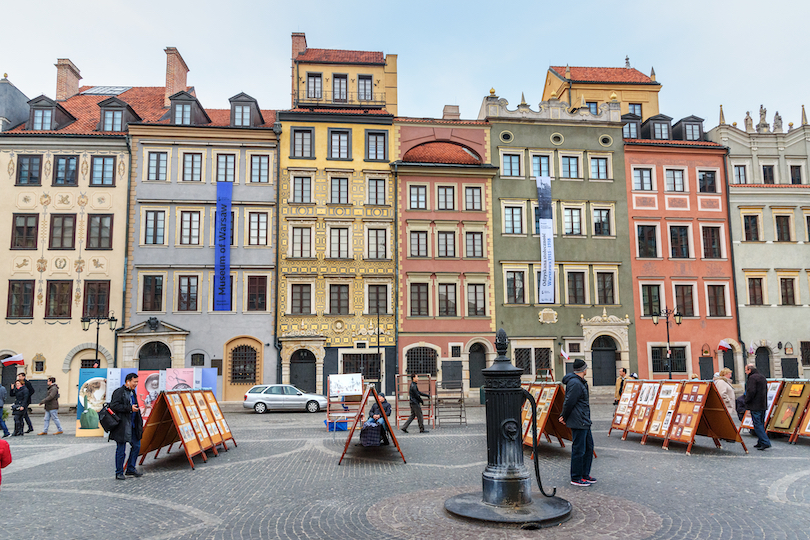
However, there are so many more things to do in Warsaw than just its historic past. It also has a thriving art scene, diverse culinary offerings (with many foreign influences), and plenty of bustling neighborhoods that champion modernity.
In short, Warsaw is a fascinating melting pot of creativity, innovation and resilience that will blow your mind. The best way to experience Warsaw is to embrace it with open arms.
17. Warsaw Barbican
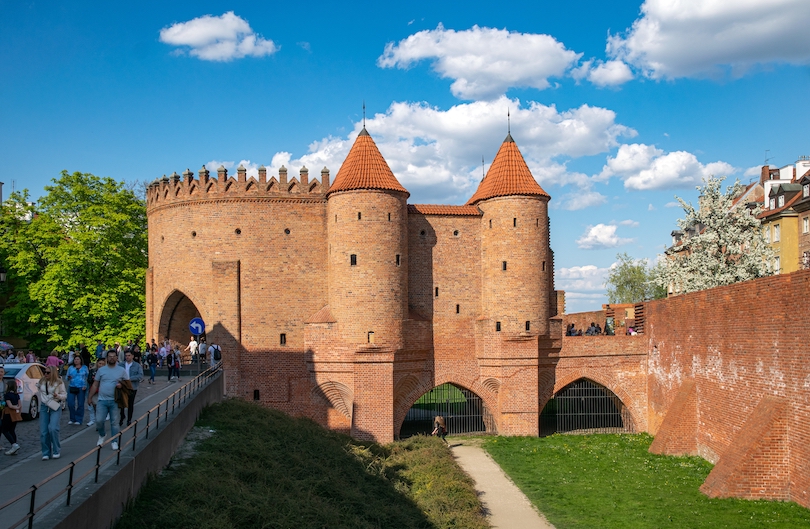
One of your first ports of call in Poland’s capital should be The Warsaw Barbican.
Built in the 16th century, this impressive defensive structure formed part of the fortifications surrounding Warsaw’s Old Town. It comprises thick walls and a series of watchtowers, that remain one of Europe’s last remaining preserved examples of such military architecture.
The structure also features turrets and a distinctive red-brick facade, which showcases Gothic and Renaissance architectural elements. It can be reached by traversing the iconic bridge that leads to it.
Inside the Barbican is a museum with exhibits that detail its history and significance. It provides a good insight into the city’s resilience and enduring spirit.
16. St Anne’s Church
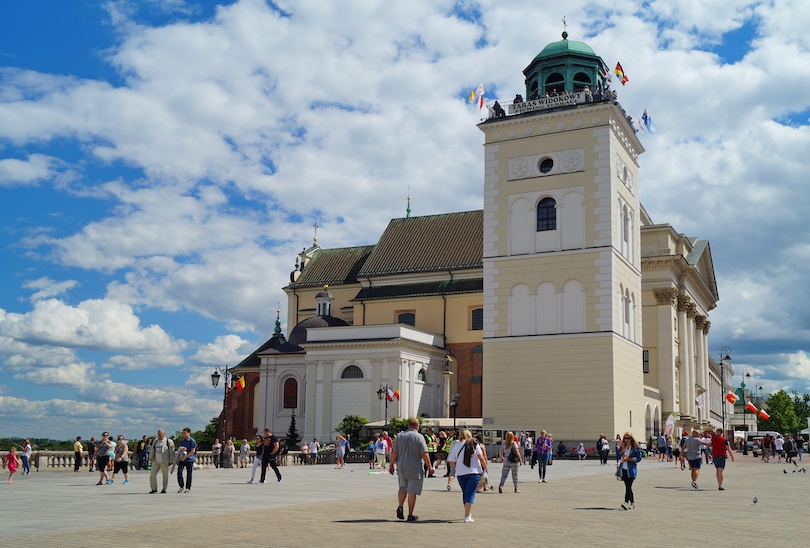
Poland is one of the world’s most religious countries and it houses several centuries-old cathedrals and churches. One of the best of them is St. Anne’s Church.
Founded in the 15th century, the church incorporates both Baroque and Gothic designs. It also features a striking facade that instantly captivates with intricate sculptures, reliefs and other ornate details.
If you like the outside of the church, you should find its interior just as compelling. The remarkable altarpiece and its intricately carved wooden decorations are just two of the features that dominate its layout. Come as soon as it opens to appreciate them at the quietest time.
Moreover, it’s worth climbing to the top of the church’s tower. From there, you’ll get superb panoramic views of Warsaw’s skyline – which you can take plenty of beautiful photos of.
15. Zlote Tarasy
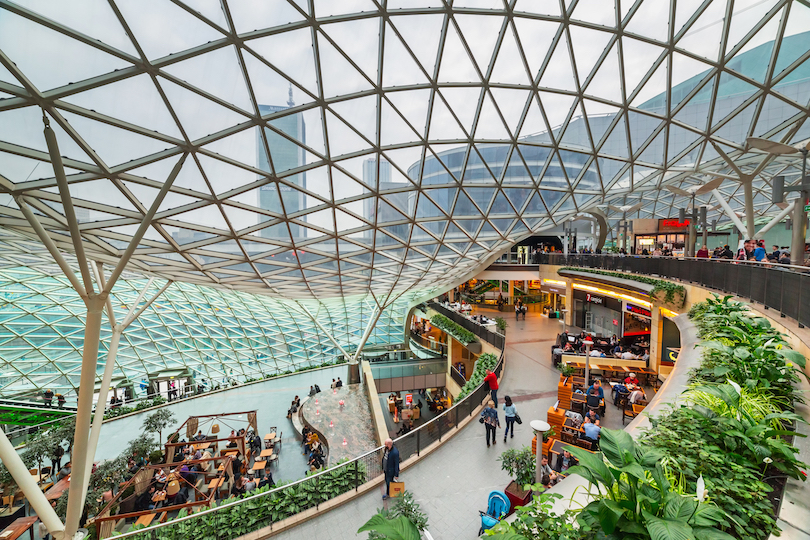
Złote Tarasy is one of Warsaw’s premier complexes for shopping and entertainment. So, if you fancy some retail therapy or want to watch a performance of note, this is the place to come.
Opened in 2007, this architectural marvel is renowned for its undulating glass roof, which is reminiscent of sea waves. It integrates seamlessly with the surrounding urban landscape and accommodates various shops, restaurants and entertainment venues. It also hosts a multi-screen cinema and a fitness center for those who fancy a workout.
As it is near the Warsaw Central Station, the Złote Tarasy is easily accessible. Its design, which features a mix of contemporary and innovative materials, reflects Warsaw’s dynamic spirit of renewal.
14. Chopin Monument
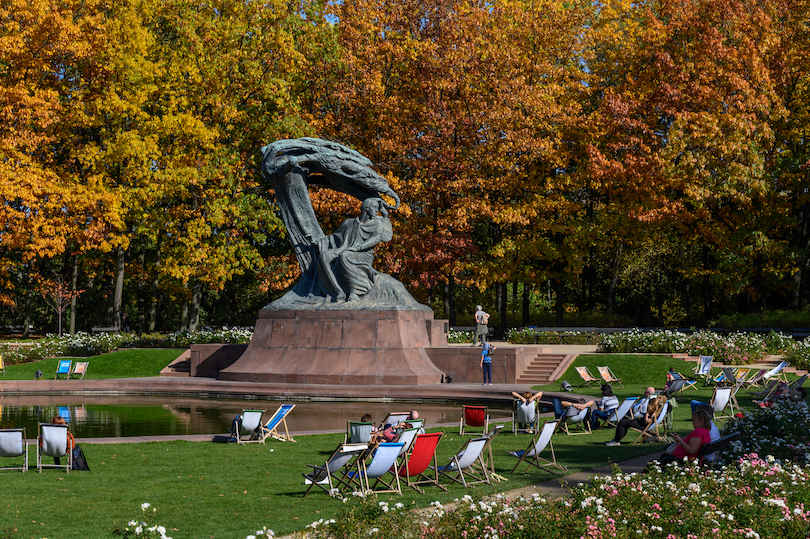
One of Poland’s most famous sons is the composer Frédéric Chopin. If you are a fan of his classical music or happen to be in the lush surroundings of Łazienki Park, it’s worth checking out the Chopin Monument.
This poignant tribute takes the form of a bronze statue that captures Chopin in a contemplative pose. It was sculpted by Wacław Szymanowski and first unveiled to the public in 1926. Surrounding the sculpture is a circular stone bench where you can sit and enjoy the serenity of his music. If you happen to do this around sunset, it is a magical experience.
Having survived the ravages of World War II, the monument has become an endearing symbol of Warsaw’s cultural identity and resilience. In the summer, regular open-air concerts are held here.
13. Castle Square
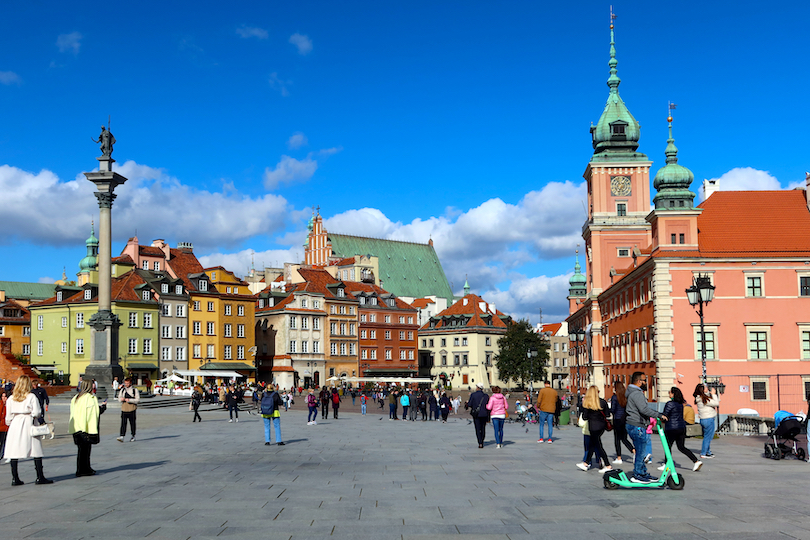
Situated right in front of the Royal Castle is Castle Square. Locally known as Plac Zamkowy it serves as a starting point for exploring the historic Old Town. At the same time, it is a popular meeting place for locals and tourists.
Surrounded by colorful townhouses, the square dates back to the 17th century. Although it was heavily damaged during World War II, both the square and the castle have been painstakingly reconstructed.
Overall, the square is a vibrant hub of charming cobblestone streets, buzzy cafes and interesting souvenir shops, which makes it a pleasant place to explore. At the center of it is Sigismund’s Column, a prominent landmark that pays homage to King Sigismund III Vasa.
12. Warsaw Uprising Monument
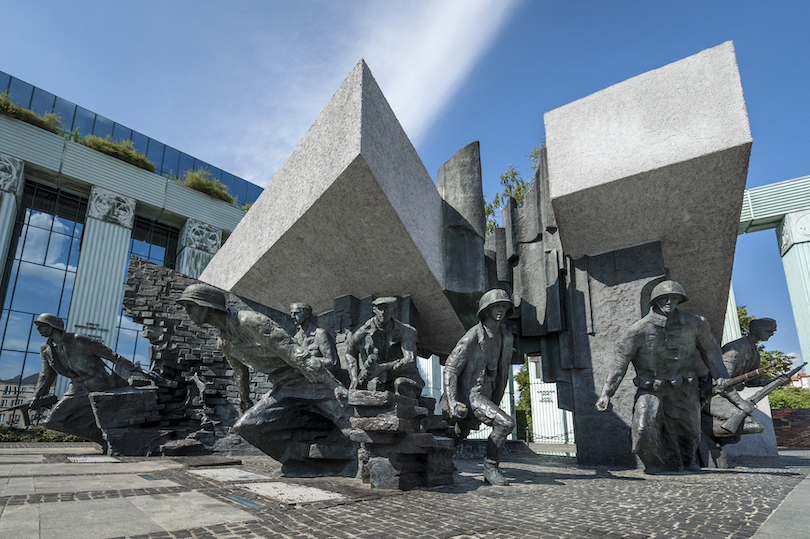
Another intriguing monument to see during your time in the city is the Warsaw Uprising Monument. It provides a solemn tribute to the resilience and sacrifice that the Polish people made during the Warsaw Uprising of 1944.
The bronze memorial was unveiled in 1989 on the 45th anniversary of the uprising. It was created by Wincenty Kućma and honors the brave men and women who fought against Nazi occupation. To see it, you’ll have to make your way to the southern end of Krasinski Square.
The memorial site also includes an underground museum that provides more information about the finer points of the uprising. Whilst there, visitors can witness the stark reality of wartime struggles and pay respects to those who endured unimaginable hardships.
11. Chopin Museum
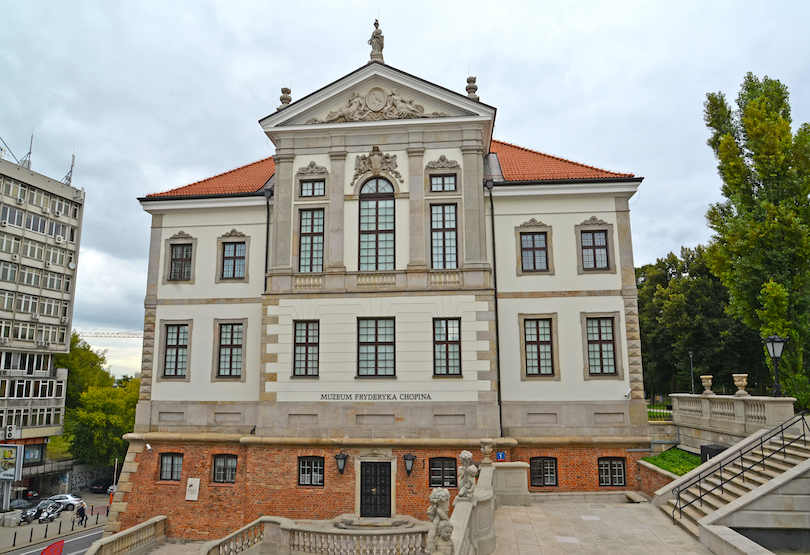
As well as the Chopin Monument, it is worth checking out The Chopin Museum if you are a fan of classical music.
This brilliantly thought-out and well-maintained museum takes you on a captivating journey through the life and works of this genius composer. It is housed in the Ostrogski Palace and opened its doors in 2010 after an extensive renovation.
The museum features interactive exhibits that provide an immersive experience to visitors. They allow them to explore Chopin’s world through multimedia displays, original manuscripts and even his personal belongings.
Showcasing the composer’s life from childhood to his international acclaim, the museum offers a profound insight into his creative process and the cultural context of his time.
Thanks to innovative audio-visual installations and touch-sensitive screens, you should get a really good understanding of the man and his music.
10. Krakowskie Przedmieście
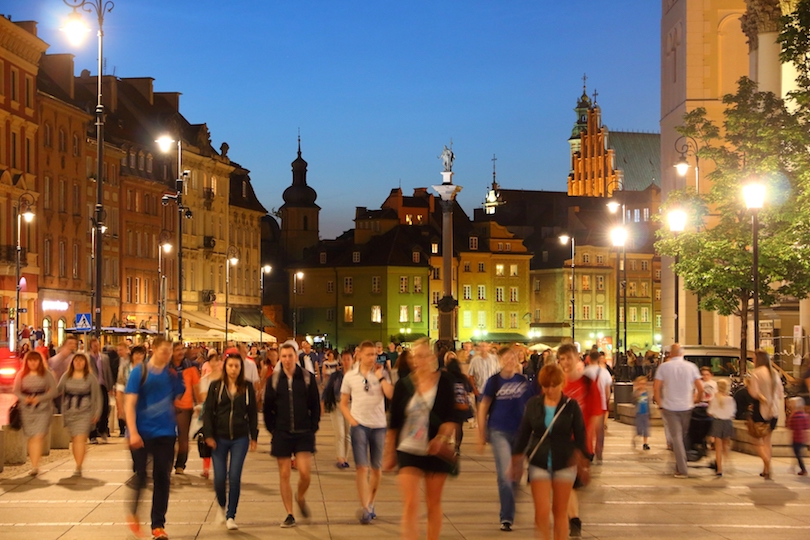
Connecting the historic Old Town with Wilanów Palace, Krakowskie Przedmieście forms part of the northern section of the famous ‘Royal Route’. It is renowned for its regal history and incredible architecture, including a parade of aristocratic residences, palaces, churches and elegant townhouses that exude a timeless charm.
For centuries, this grand boulevard has been a focal point of Warsaw’s cultural and social life and you get a real sense of this as you traverse the street. Notable landmarks like the Presidential Palace, the University of Warsaw and St. Anne’s Church can all be easily visited. Don’t be surprised if you spend a lot of quality sightseeing time here.
9. Copernicus Science Centre
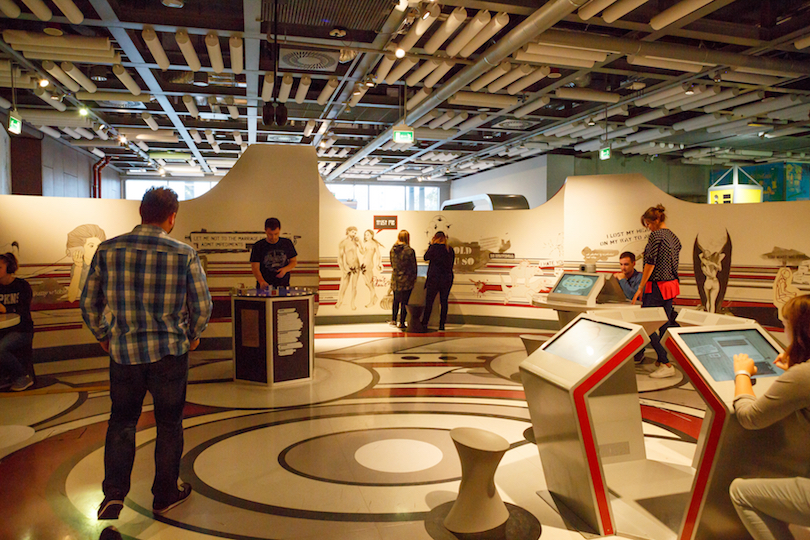
If you are into science, you’ll want to visit The Copernicus Science Center. This cutting-edge institution is named after the renowned astronomer Nicolaus Copernicus and is dedicated to promoting scientific curiosity and education.
The center boasts modern architecture that features a distinctive spherical structure. It also houses more than 450 interactive exhibits that span various scientific disciplines.
Wandering through the center, visitors can engage in hands-on experiments, explore the wonders of physics, biology and technology and participate in live demonstrations. The center is particularly family-friendly and encourages visitors of all ages to discover the joy of learning through play.
The planetarium and robotic theater are two must-visit destinations at the center.
8. POLIN Museum of the History of Polish Jews
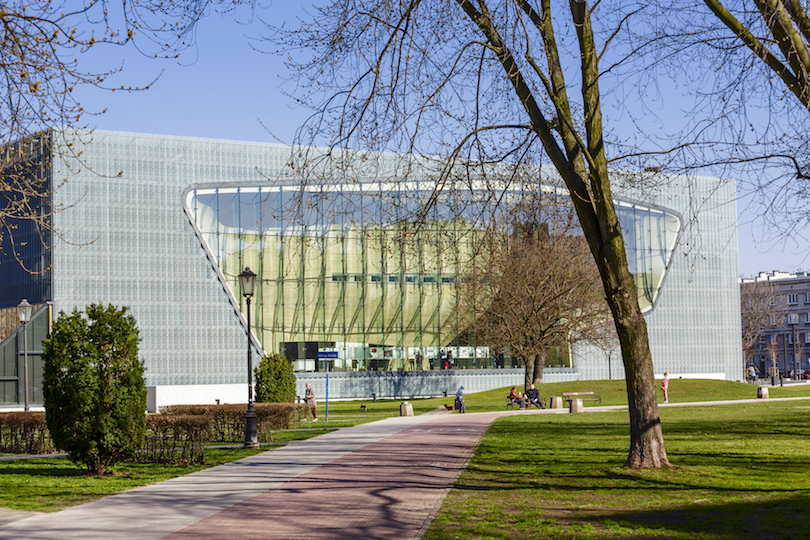
One of the most fascinating attractions in Warsaw is The POLIN Museum of the History of Polish Jews.
Located on the site of the former Warsaw Ghetto, the institution is the first and only one of its kind in the country. It focuses on honoring the memory of the community created by Jews in Poland. It opened in 2013 and is notable for its unique design, which resembles an open book that symbolizes a dialogue between past and present.
Once inside the museum, you’ll find immersive exhibitions that trace the history of Polish Jews from medieval times to the present day. They highlight the contributions, struggles and cultural richness these people brought.
Overall, the multimedia displays, artifacts and interactive installations provide a comprehensive and emotionally evocative experience for the visitor. The museum also hosts cultural events, lectures, and workshops regularly throughout the year.
7. Palace of Culture and Science
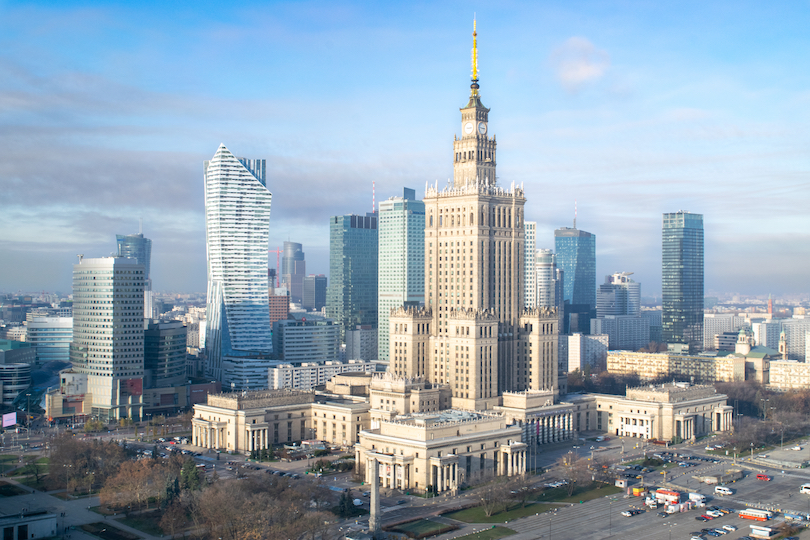
Dominating the skyline in Warsaw is the Palace of Culture and Science, which just happens to be the second tallest building in the country.
Completed in 1955 the structure was designed by Soviet architect Lev Rudnev, who blended various architectural styles, including Socialist Realism. Its design was inspired by the high-rise Art Deco buildings of America and historical Polish architecture.
It was previously known as ‘Joseph Stalin’s Palace of Culture and Science’, however, this name was later dropped during the time of destalinization.
Today, it houses various cultural institutions, theaters, museums and conference halls which you can visit. Tourists can also ascend to its panoramic terrace to enjoy breathtaking views of Warsaw.
6. Warsaw Uprising Museum
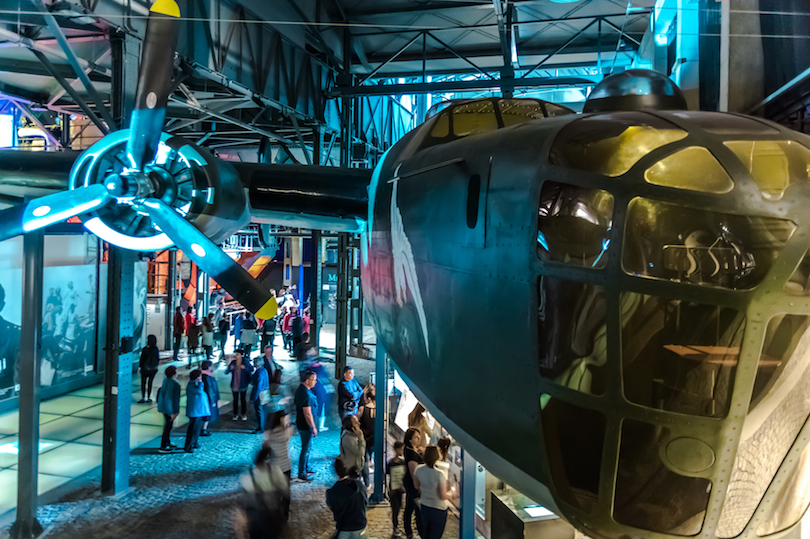
If you know your World War II history, you will understand how important the Warsaw Uprising Museum will be to visit. If you don’t, then that is all the more reason to go there.
As its name implies, the museum pays a poignant tribute to the heroic spirit of the Polish resistance during the Warsaw Uprising of 1944. It is housed in a former tram power station and features exhibits that depict the daily life, struggles, and sacrifices of the insurgents.
Through multimedia displays, personal testimonies, and a replica of the underground city where the resistance operated, you’ll gain a good understanding of their experiences.
Visitors can explore an extensive collection of artifacts, including weapons, documents and photographs. At the same time, a reconstructed B-24 Liberator bomber aircraft is a notable highlight.
5. Wilanow Palace
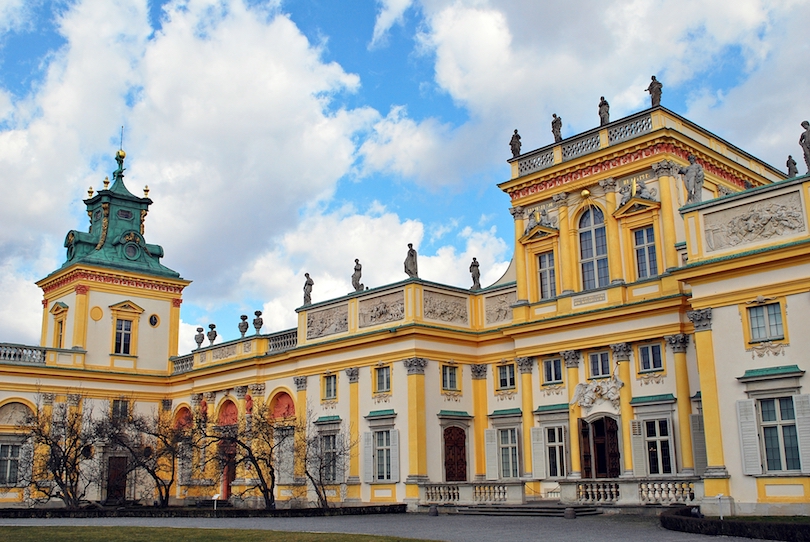
Nestled in the Wilanów district of Warsaw resides one of the country’s most significant historical buildings – Wilanów Palace.
Commissioned by King John III Sobieski in the late 17th century, the palace served as a royal residence and embodied the splendor of Poland’s golden age. It is beautifully set among stunning gardens and parks replete with fountains, sculptures and manicured lawns that are an attraction in themselves.
What makes Wilanów Palace immediately stand out is its seamless blend of Baroque, Rococo and Neoclassical architectural styles. You’ll want to snap plenty of photos from different angles to capture its true beauty.
Once inside, you’ll see an impressive collection of art, furnishings and period artifacts that offer a glimpse into the opulent lifestyle of Polish royalty.
4. Nowy Swiat
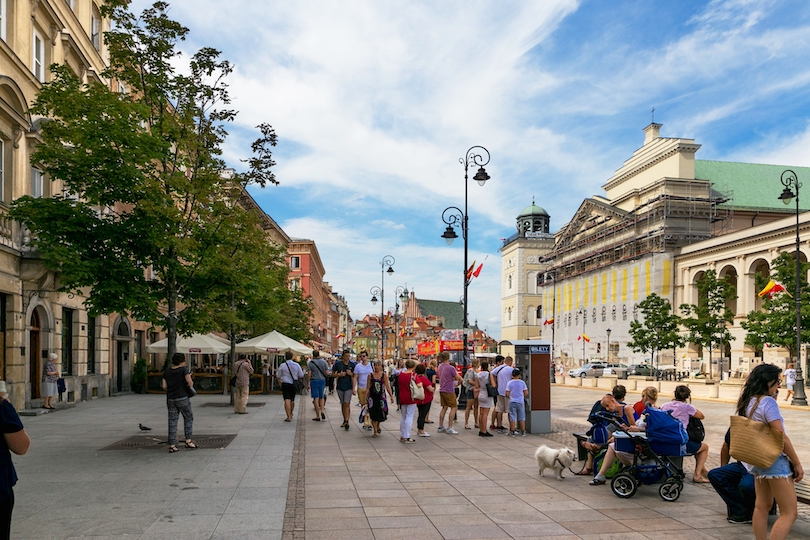
Dating back to the 17th century Nowy Świat is one of the main thoroughfares in Warsaw. Its name translates to ‘New World Street’ in English and it connects Castle Square with Charles de Gaulle Roundabout.
Noted for its historic buildings, boutique shops and inviting cafes, Nowy Świat boasts a cosmopolitan atmosphere. It also provides a picturesque route to navigate your way through the heart of the city.
Surviving wars and countless reconstructions, the street possesses an architectural diversity that features styles from different periods. It also has many restaurants that provide excellent opportunities to try local delicacies like Kopytka (dumplings) and Gulasz (stew). In addition, you’ll find plenty of shops that will enable you to do a bit of retail therapy.
3. Royal Castle
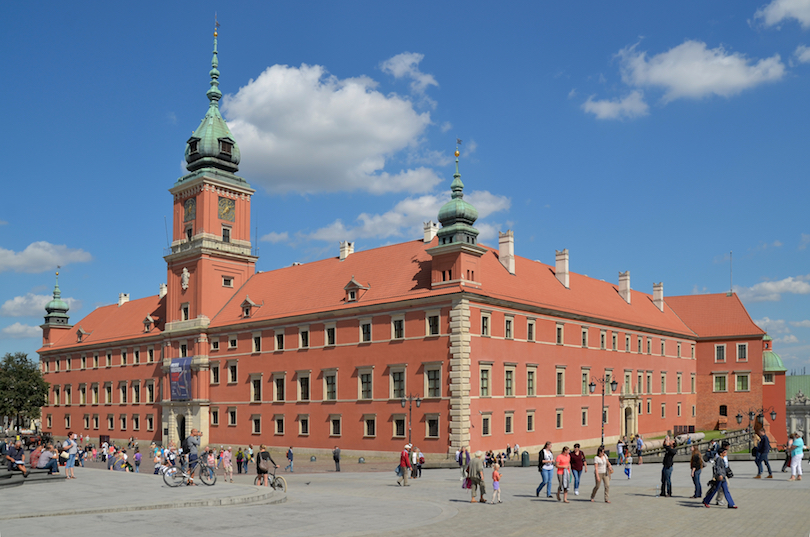
Perched atop Castle Square in the heart of the Old Town is Warsaw’s famous Royal Castle. Originally built in the 14th century, it stands as a symbol of Poland’s regal heritage and resilience.
Over the years it has witnessed centuries of Polish history, serving as the residence of monarchs and as a political center. Unfortunately, it was severely damaged during World War II. However, it has been meticulously restored to its former glory, thanks to reconstruction efforts.
Tourists can explore opulent chambers, like the Great Apartment and the Throne Room, which are adorned with period furnishings and artwork. They can also enjoy the castle’s impressive collection of paintings, sculptures and royal memorabilia that relate the story of the city’s cultural legacy.
2. Lazienki Park
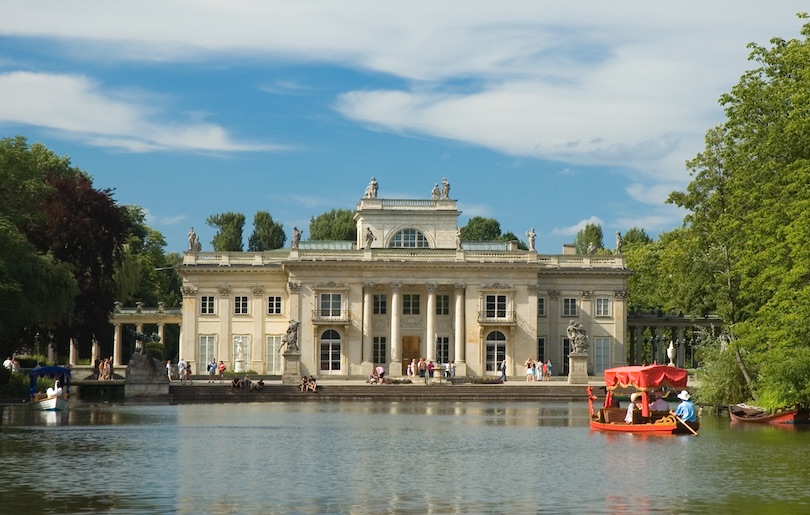
Warsaw doesn’t just have splendid architecture, it also accommodates beautiful greenspace too. One of the finest examples is Łazienki Park, which resides in the Downtown district, just off of Ujazdów Avenue.
Also known as ‘Royal Baths Park’, it is the largest park in the city and is celebrated for its scenic beauty and cultural significance. It was originally designed in the 17th century and later transformed into a summer residence for King Stanisław August Poniatowski.
The park encompasses the neoclassical Palace on the Isle, a picturesque amphitheater and charming pavilions scattered amidst lush landscapes. It also hosts outdoor concerts, cultural events and the annual Chopin Concerts – which take place at the foot of the monument which resides within it.
1. Old Town Market Square
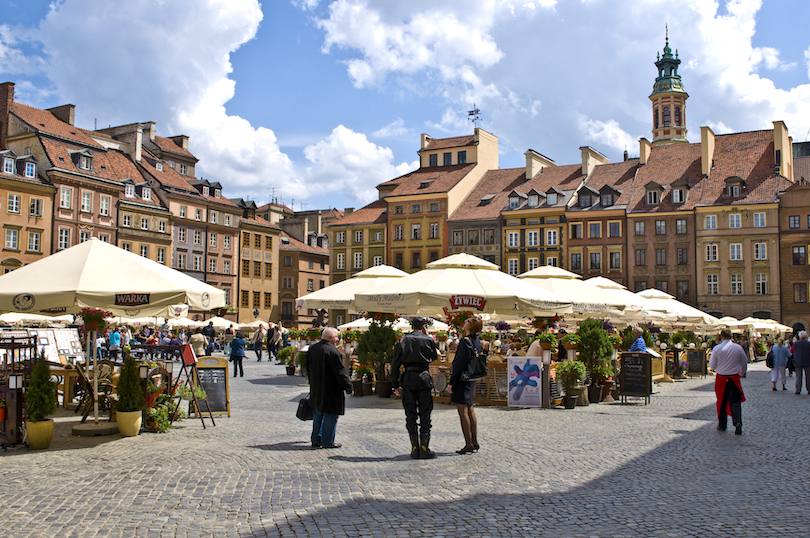
For most visitors to Warsaw, the Old Town Market Square (Rynek Starego Miasta) is somewhere they will spend quite a bit of time.
This remarkable square bristles with charm, historical and cultural significance. Originally it was constructed in the 13th century, but much of the city was destroyed during World War II. However, the area has been so well restored it’s almost impossible to tell it was previously damaged.
The square is surrounded by colorful townhouses and boasts a lively ambiance with outdoor cafes, restaurants and various street performers. It also features the imposing Warsaw Mermaid statue and is home to landmarks like the Adam Mickiewicz Museum and the Historical Museum of Warsaw.
While the square is buzzy all day, it is worth heading down there in the evening, as that is when things really liven up.
Best Time to Visit Warsaw
Straddling the Vistula River, Poland’s capital Warsaw enjoys a continental climate with cold, cloudy winters and relatively warm, sunny summers. May to September is the most popular time to visit when temperatures average from 18 to 24°C (64 to 75°F).
While July and August are the busiest, most expensive months, there are lots of fun events like the Warsaw Summer Jazz Days and Chopin Summer Concerts to attend. The whole city has a lovely vibe with its numerous parks and green spaces looking their best.
Either side of summer, Warsaw is still very pleasant to visit though huge crowds still throng about the center. As October sees the prestigious Warsaw Film Festival take place, it is only in the much-colder November that the city finally falls quiet.
December, however, immediately sees a return to business as people flock here for its cozy, traditional Christmas market – one of the biggest and best in Poland. The city then slumbers until spring when the fresh flowers make its river and parks very pretty to walk about again.
Where to Stay in Warsaw
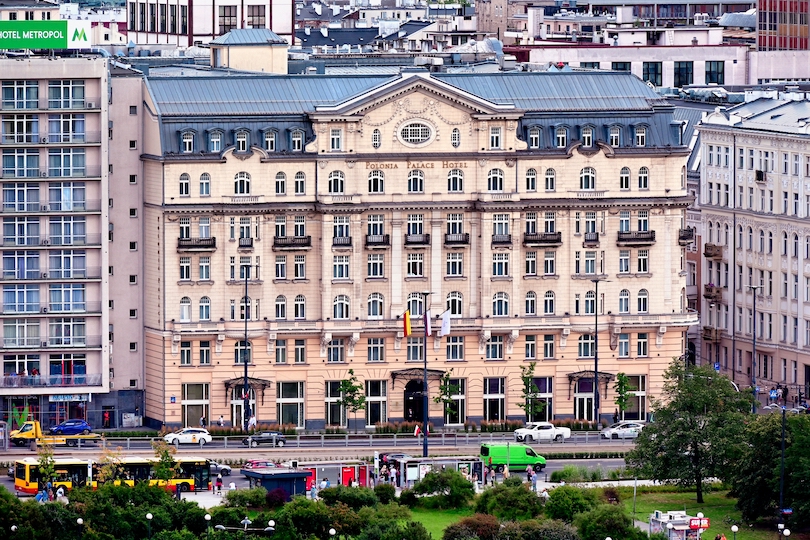
When it comes to finding somewhere to stay in Warsaw, there are plenty of options available to you.
But if it is your first time in the city, you should base yourself in Śródmieście, or more specifically the Old Town. This area is the heart of Warsaw and you’ll be close to lots of art galleries, theaters, museums, restaurants, shops and some of the city’s main attractions.
The historic Hotel Polonia Palace is a terrific accommodation choice in this area. It is located directly opposite the Palace of Culture and Science and features an excellent restaurant that serves European and Polish cuisine. It also has comfortable rooms and a nice lobby bar to relax and unwind.
Not far from the Hotel Polonia Palace is the Hotel Metropol . This budget option is just a 5-minute walk from the Palace of Culture and Science. It is known for its superb breakfasts and dinners which you can get from the on-site Metro Jazz Bar & Bistro Restaurant. It also has rooms with ensuite bathrooms.
How to get there
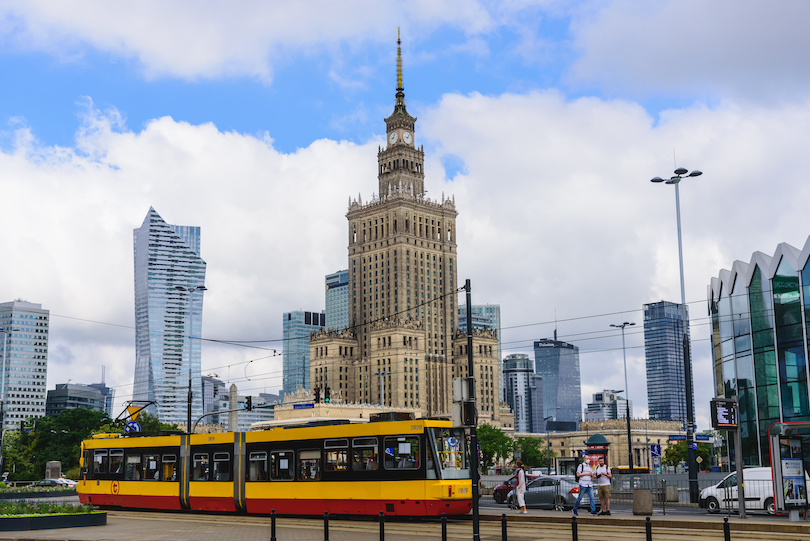
Like most capital cities in Europe, Warsaw is a relatively easy destination to get to via air and rail.
Warsaw Chopin Airport is the primary international gateway to fly into. It is situated about 10 km southwest of the city center and receives multiple flights a day from Europe, the USA and Asia.
American Airlines, British Airways, Lufthansa and Qatar Airways are some of the many airlines that fly there. Additionally, for budget carriers like Easyjet and Ryanair, Modlin Airport is another point of entry – about 40 kilometers north of Warsaw.
If you would prefer not to fly, the city is well-connected by an extensive train network. Warszawa Centralna (Warsaw Central Station) serves as the major hub for domestic and international rail travel.
Map of Tourist Attractions in Warsaw
Share this post:
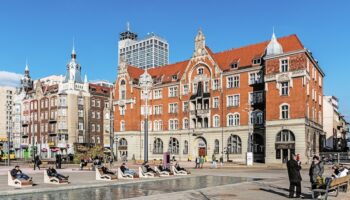
17 Best Things to do in Katowice, Poland
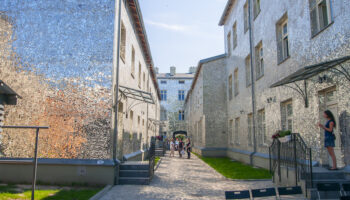
16 Fun Things to Do in Lodz, Poland
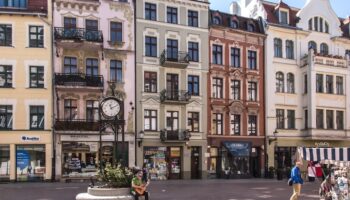
14 Best Things to Do in Torun, Poland
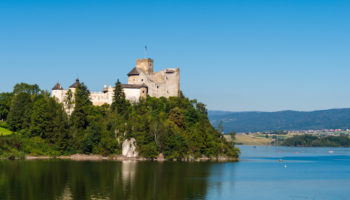
16 Most Beautiful Castles in Poland

16 Most Beautiful Regions in Poland
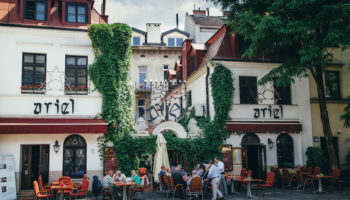
Where to Stay in Krakow: Best Neighborhoods & Hotels
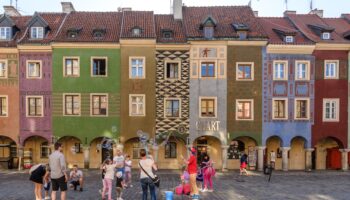
17 Best Things to Do in Poznan, Poland
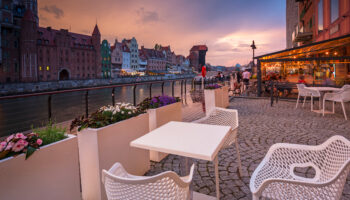
17 Fun Things to Do in Gdansk, Poland
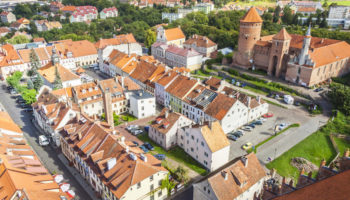
14 Stunning Small Towns in Poland

17 Top Attractions & Things to do in Poland
Reader interactions.
December 15, 2019 at 4:43 am
What bout Warsaw and its nightlife? I’ve been to Warsaw twice and it was the most crazy time in my life! I can recommend you mazowiecka street and new orleans in the centre!
Leave a Reply Cancel reply
Your email address will not be published. Required fields are marked *
This site uses Akismet to reduce spam. Learn how your comment data is processed .
Must-see attractions in Warsaw
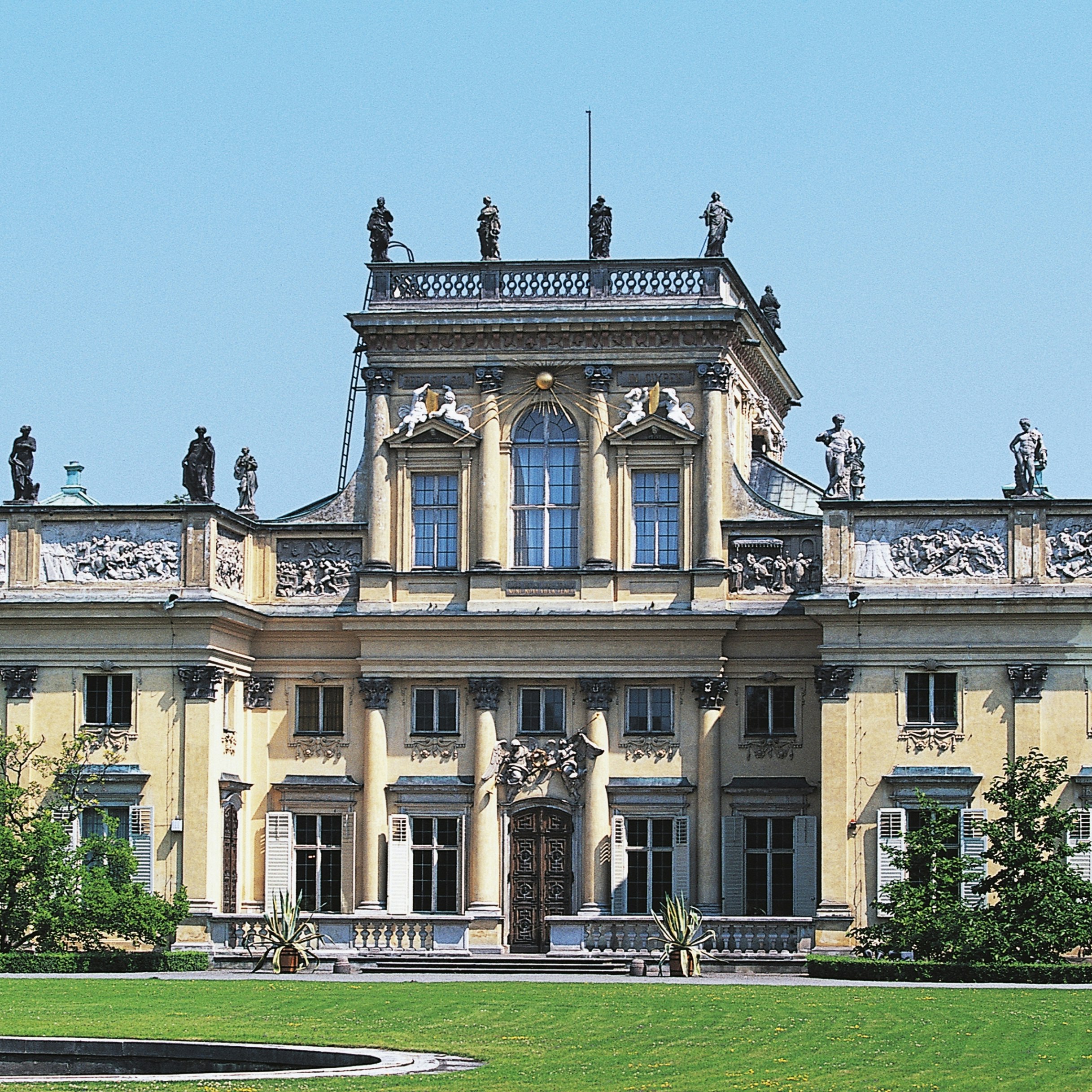
Wilanów Palace
Warsaw’s top palace, 10km south of the city centre, was commissioned by King Jan III Sobieski in 1677. It has changed hands several times over the…
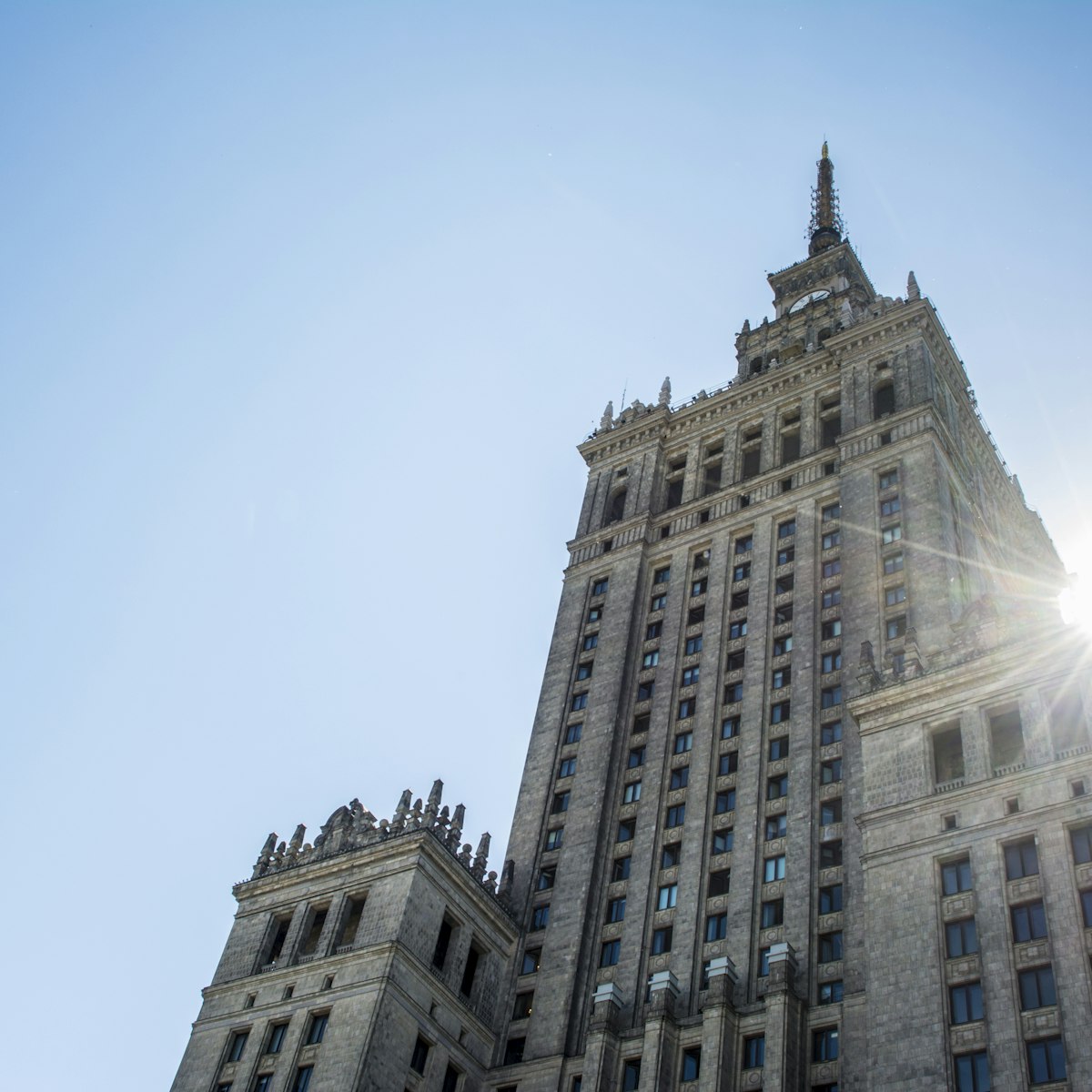
Palace of Culture & Science
For over 60 years this socialist realist palace has dominated central Warsaw. A ‘gift of friendship’ from the Soviet Union, it was completed in 1955 and…
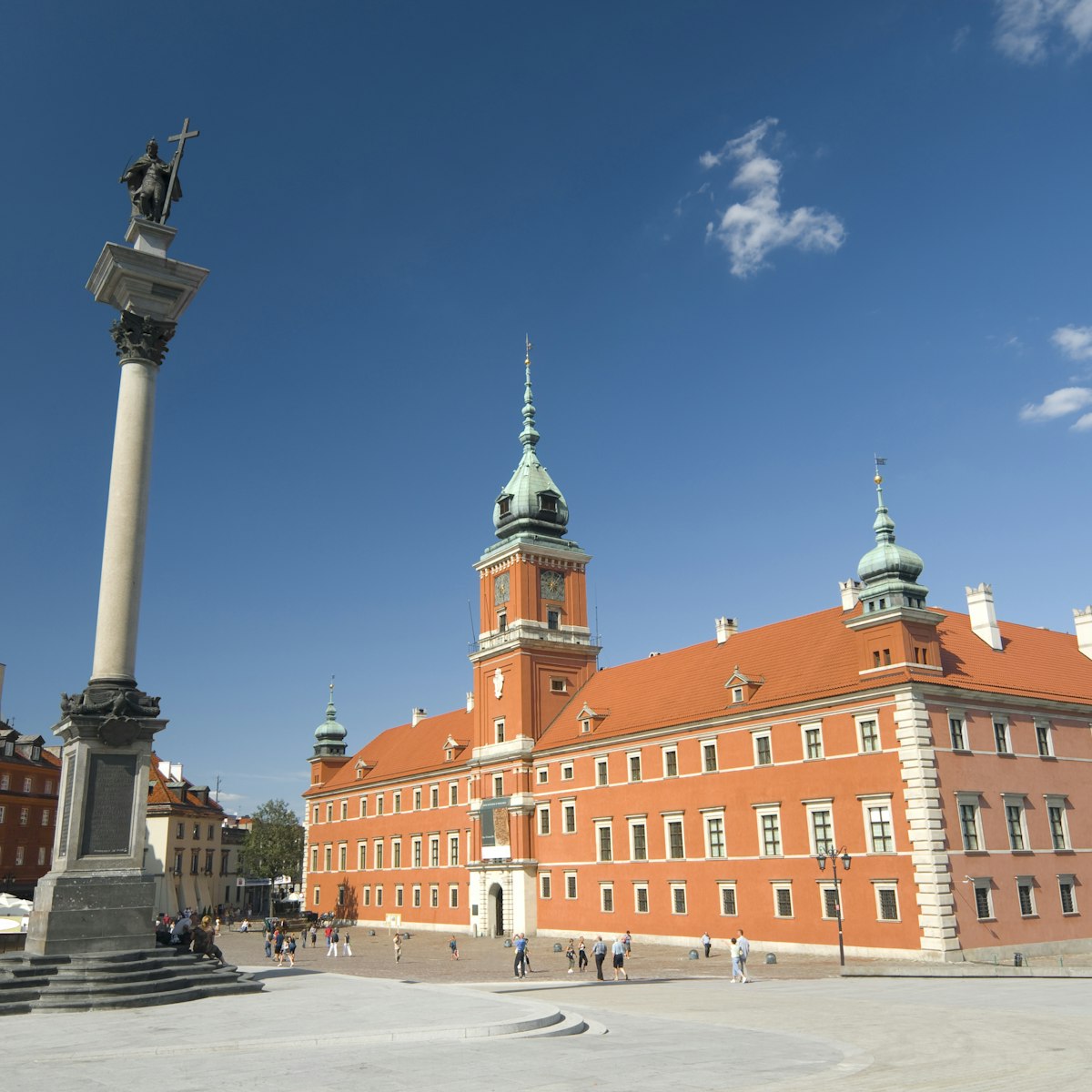
Royal Castle
This remarkable copy of the original castle blown up by the Germans in WWII is filled with authentic period furniture and original works of art…
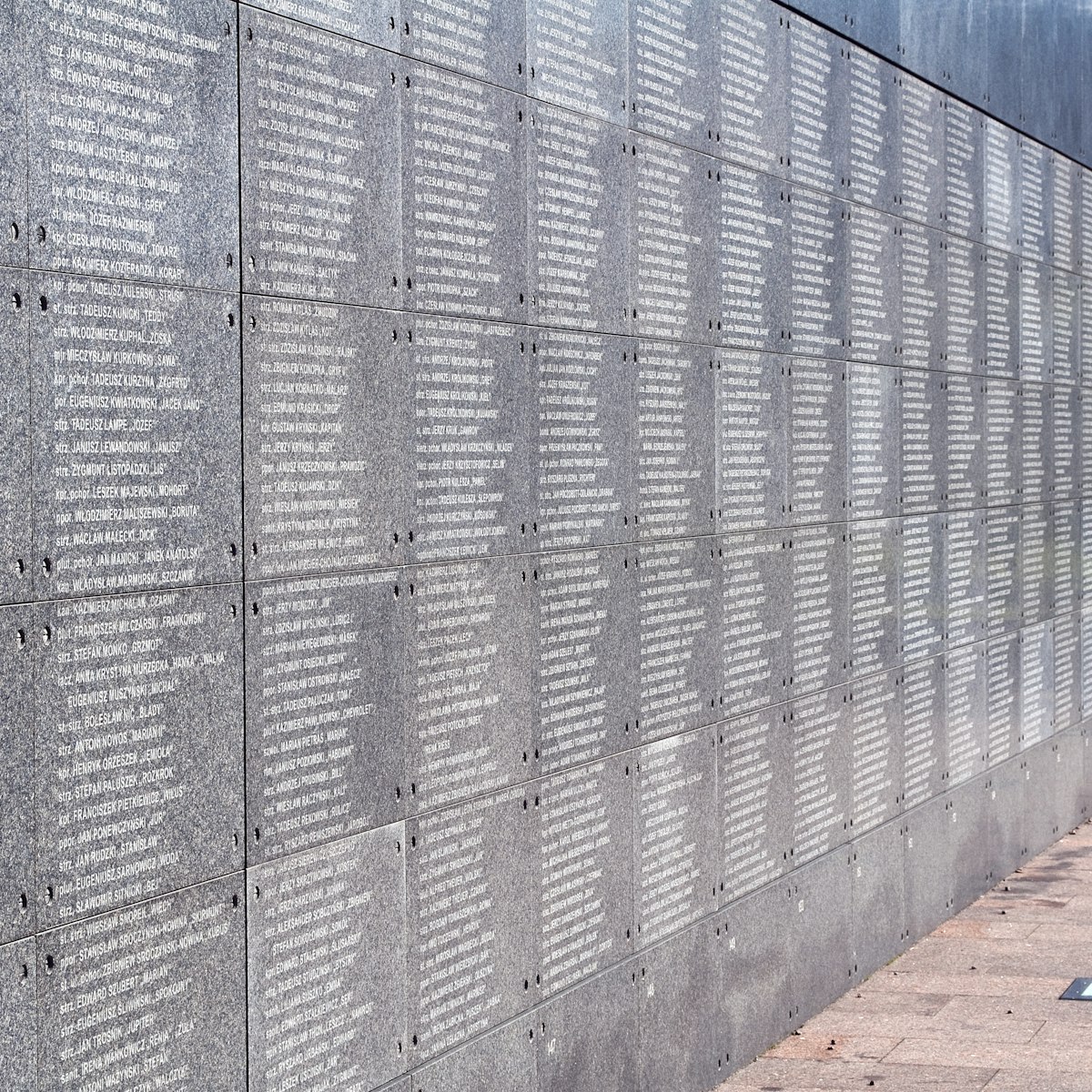
Warsaw Rising Museum
This exceptional museum, housed in a former tram power station and its surrounding grounds, traces the history of the city's heroic but doomed uprising…
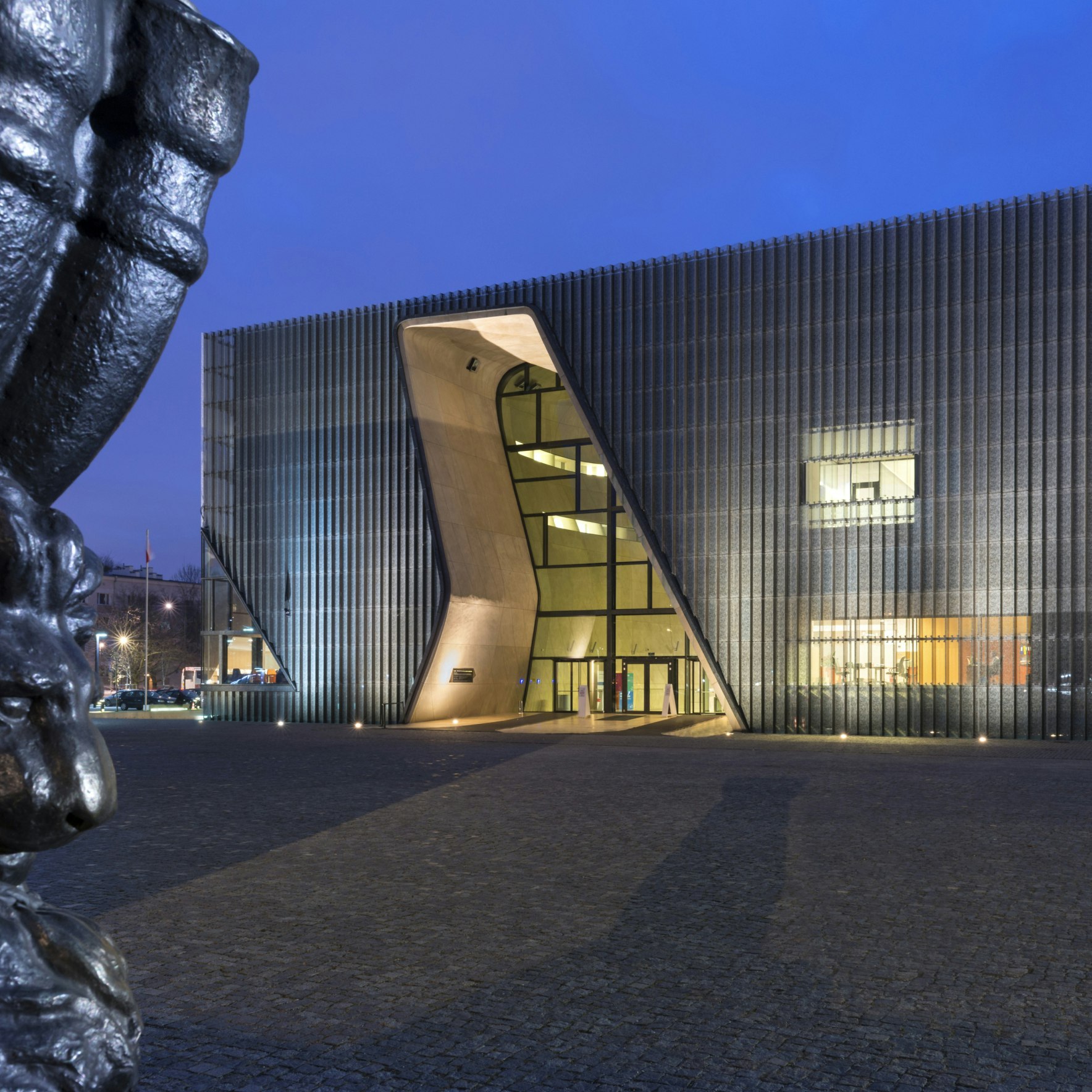
POLIN Museum of the History of Polish Jews
Housed in one of Warsaw's best examples of contemporary architecture, this award-winning museum documents 1000 years of Jewish history in Poland. The…

Copernicus Science Centre
The fully interactive, push-the-buttons-and-see-what-happens Copernicus Science Centre pulls off that tricky feat of being both hugely fun and educational…
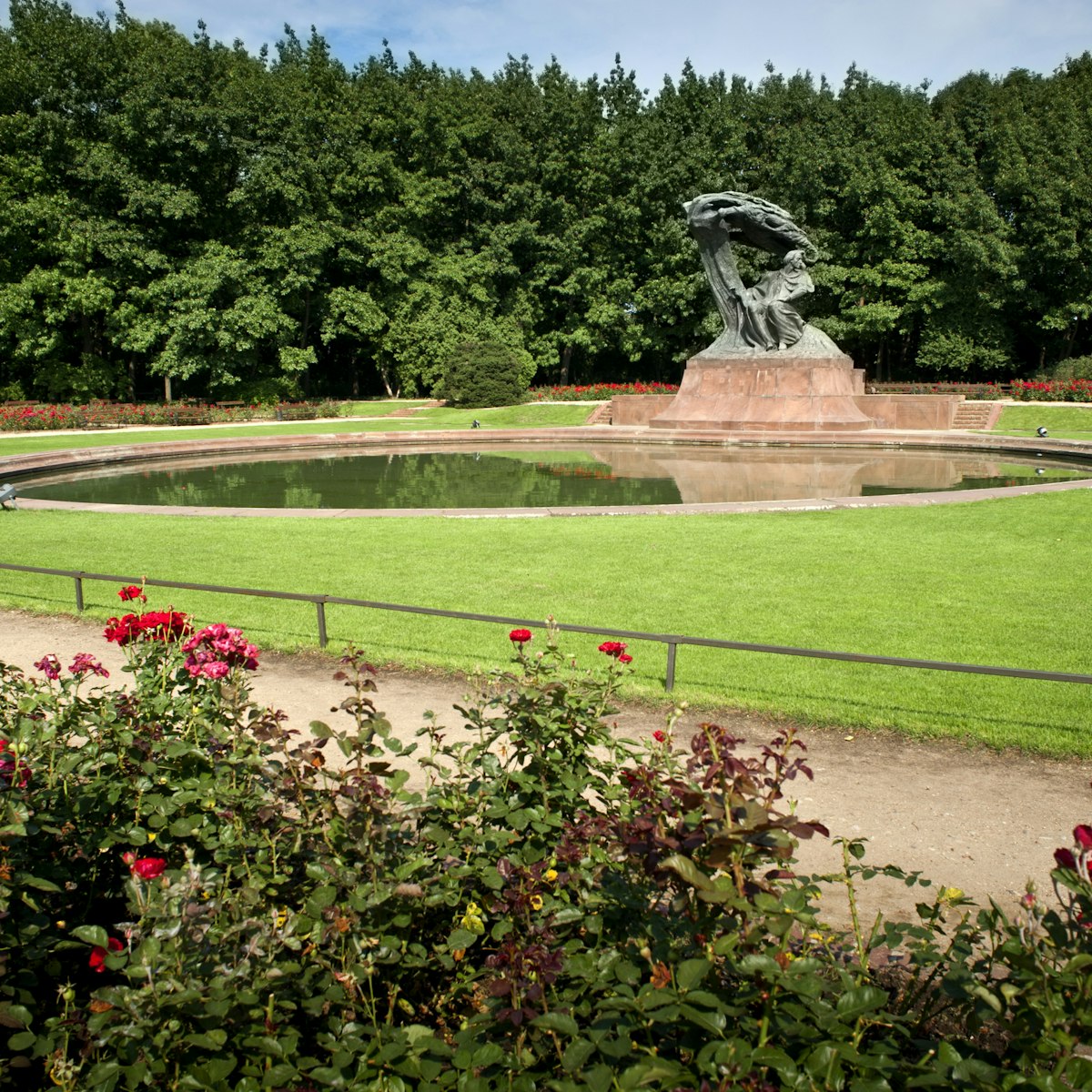
Łazienki Park
Pronounced wah-zhen-kee, this beautiful park includes manicured gardens, an ornamental lake, wooded glades and strutting peacocks. Once a hunting ground,…
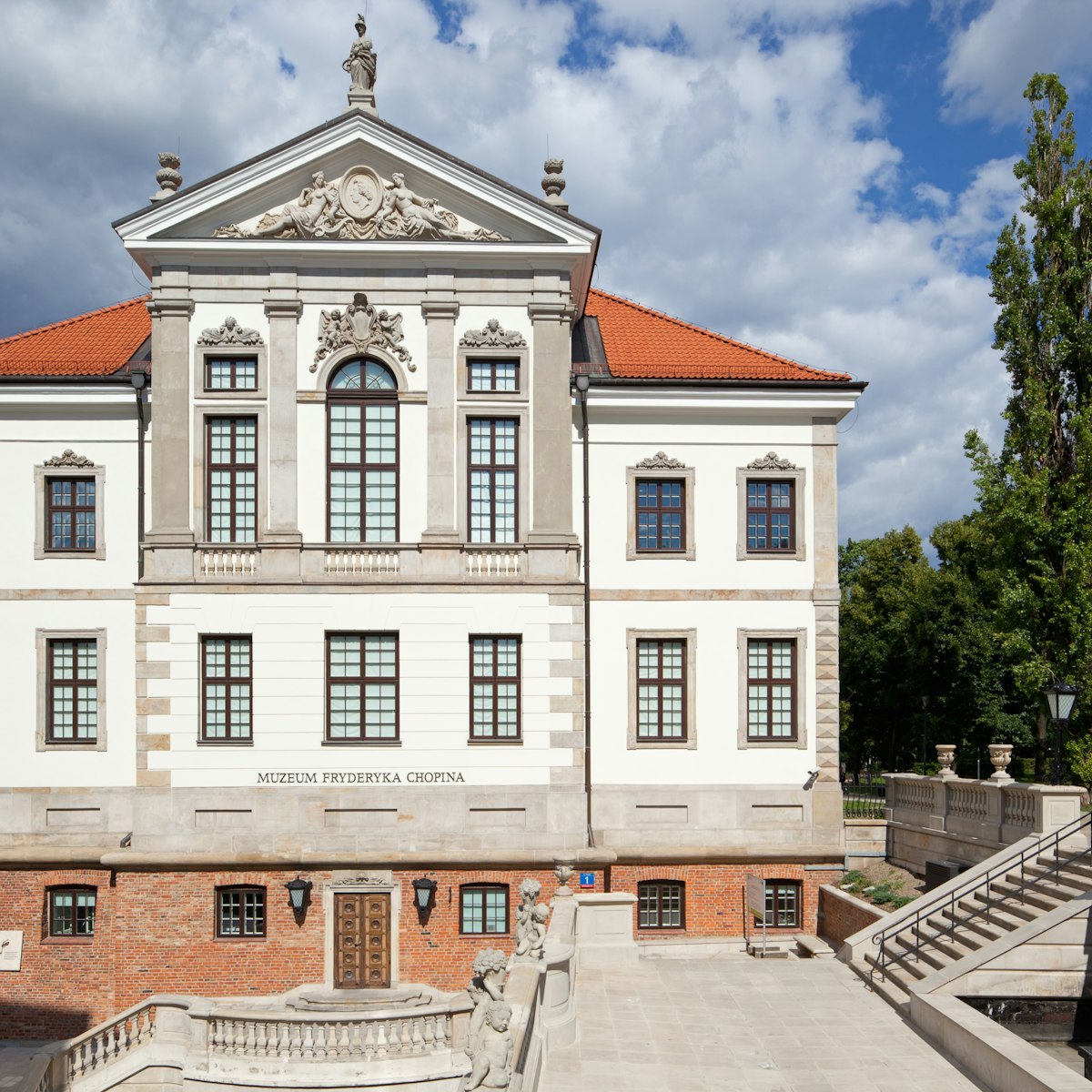
Fryderyk Chopin Museum
This multimedia museum within the baroque Ostrogski Palace showcases the work of Poland’s most famous composer. You’re encouraged to take your time…
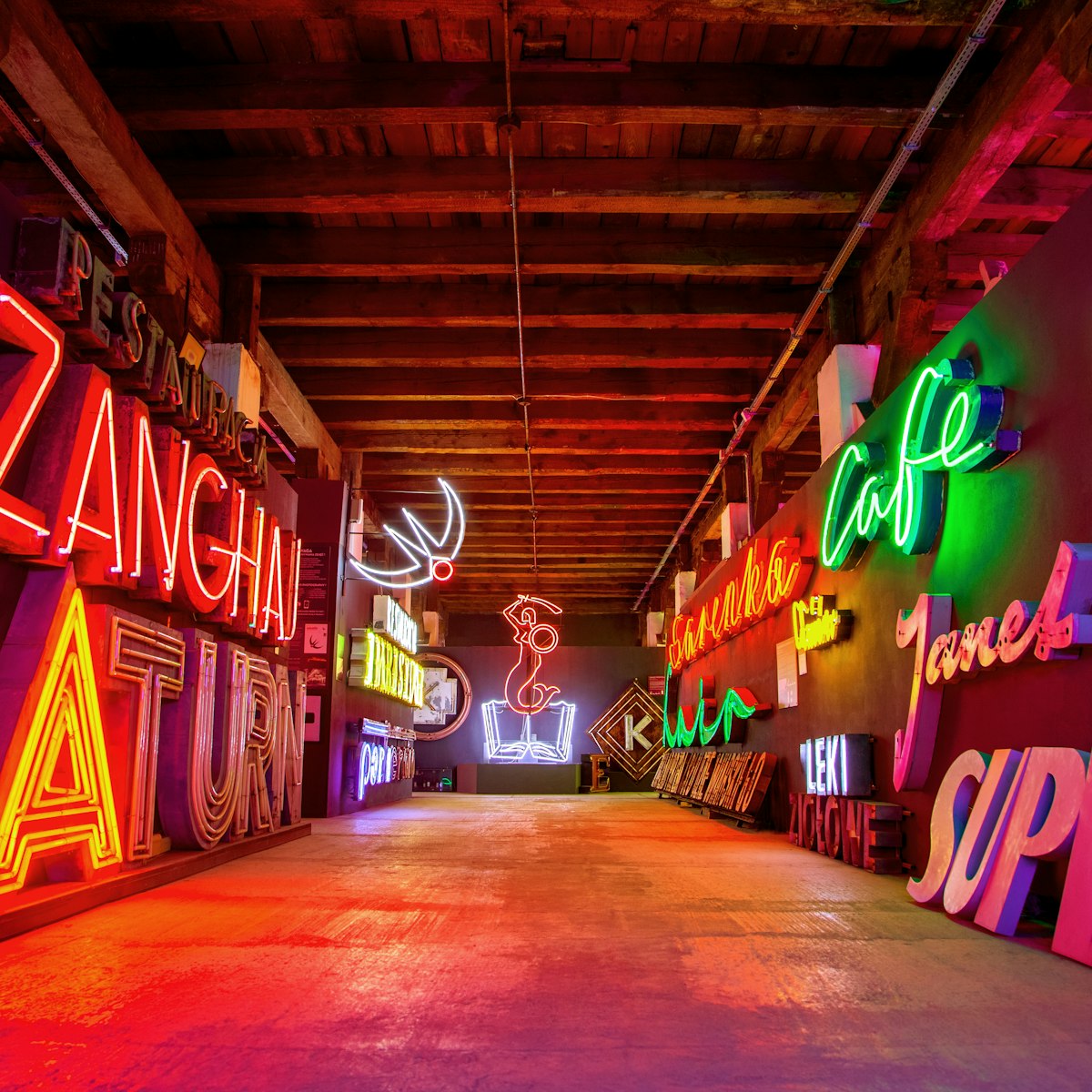
Neon Museum
Situated within the Soho Factory complex of old industrial buildings housing designers and artists, this museum is devoted to the preservation of the…
Museum of Warsaw
Occupying 11 tenement houses on the north side of the Old Town Sq, this superb museum tells Warsaw's dramatic history in innovative ways. Start with the…
Praga Museum of Warsaw
Occupying three tenement buildings spanning the 18th and 19th centuries, this museum does a fantastic job of covering Praga's rich and varied history. It…
National Museum
Drawing on a collection of some 830,000 works of art, both local and international, this is Poland's largest museum. It will come as a revelation for…
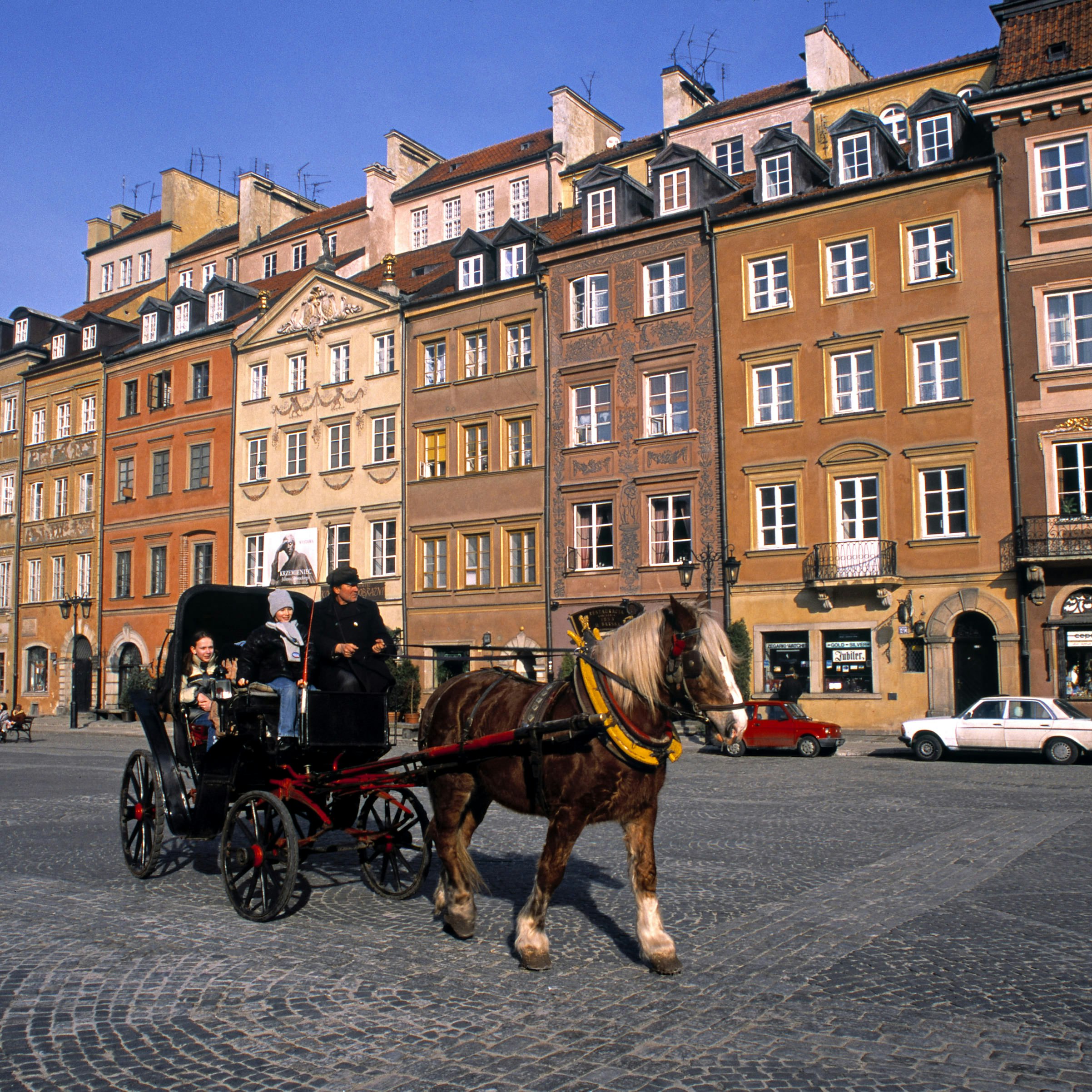
Old Town Square
For those with an eye for historic buildings this is Warsaw's loveliest square, not to mention its oldest having been established at the turn of the 13th…

Wilanów Park
This splendid 45-hectare park adjoins Wilanów Palace and contains a variety of landscaping. The central part comprises a manicured, two-level baroque…
Jewish Cemetery
Founded in 1806, Warsaw's main Jewish Cemetery covering 33.4 hectares contains more than 150,000 tombstones, the largest and most beautiful collection of…
Żabińskis' Villa
The incredible true life story of how zoo director Jan Żabiński and his wife Antonia helped save over 70 Jews during WWII has become famous through the…
Palace on the Isle
Łazienki Park's centrepiece is a delightful neoclassical palace, the former residence of King Stanisław August Poniatowski, which stands on an island in…
Warsaw Zoological Gardens
Established in 1928, this well-managed zoo is home to some 3000 animals representing 500 species from across the world, including bears, wolves,…
Jewish Historical Institute
Just behind a blue skyscraper (which stands on the location of the Great Synagogue destroyed by the Germans), JHI houses a library and exhibitions related…
Monument to the Warsaw Rising
One of Warsaw’s most important landmarks, this dynamic bronze tableau depicts Armia Krajowa (AK; Home Army) fighters emerging ghostlike from the shattered…
Poster Museum
Polish poster art is outstanding and this museum's collection numbers over 36,000, with an additional 26,000 artistic, advertising and propaganda prints…
Heavens of Copernicus Planetarium
You may well find yourself wanting to make multiple visits to this far from average planetarium. A packed repertoire of films is projected across a 16m…
National Stadium
This prominent landmark on the east bank of the Vistula was constructed for the Euro 2012 football championships on the site of a communist-era stadium…
Katyn Museum
This sombre museum is devoted not only to the massacre of Polish military officers in the forests of Katyn in 1940, but also all Polish victims of Soviet…
Bródno Jewish Cemetery
Having suffered great damage during WWII and almost total destruction during Poland's communist years, this historic graveyard, where Jews have been…
Królikarnia
A serene escape from the city is this park and Palladian palace (known as the 'Rabbit House') that showcases the National Museum's collection of works by…
Railway Museum
Occupying the former premises of Warszawa Główna, the city's main train station until the opening of Warszawa Centralna in 1975, this open-air museum is a…
Fotoplastikon
Photography enthusiasts will be thrilled by this late-19th-century contraption. Reputedly the last working example of its kind in Europe, it consists of a…
Tomb of the Unknown Soldier
Dedicated to the unknown soldiers who have given their lives for Poland, this military memorial occupies the last remnant of the Saxon Palace that stood…
Ghetto Heroes Monument
Look closely and you see there are actually two monuments here commemorating the thousands who lost their lives in the ill-fated Warsaw Ghetto Uprising of…
David Bowie Mural
Following the singer's death in 2016, cultural organisation Stacja Muranów crowdfunded for the creation of this fab mural of Bowie, depicted in his iconic…
Saxon Garden
Covering 15.5 hectares, this splendid garden, founded in the late 17th century, became Warsaw’s first public park in 1727. Initially modelled on…
Church of the Holy Cross
Of Warsaw's many impressive churches, this is the one most visitors want to see – not so much to admire the fine baroque altarpieces that miraculously…
Powązki Cemetery
Warsaw's most prestigious cemetery covers 43 hectares and contains the graves of well over a million souls. Illustrious Poles from all walks of life are…
Pawiak Prison Museum
During WWII the prison that once stood here was used by the Gestapo – that's the time period that the displays in this grimly fascinating museum focus on…
Warsaw University Library
The stunning copper-clad building that houses the university library was awarded top prize by the Association of Polish Architects in 2000. The main…
Open Jazdów
A pleasant spot to hang out is this charming wooded enclave in the heart of Warsaw. The colony of some 20-odd Finnish wooden cottages have been here since…
St Anne's Church
Marking the start of the Royal Way, this is arguably Warsaw's most ornate church. It escaped major damage during WWII, which explains why it sports an…
One of Warsaw's most pleasant residential areas, Żoliborz derives its name from joli bord, French for 'beautiful embankment'. During Russian Imperial rule…
Old Orangery
This elegant structure, completed in 1788, once sheltered exotic trees in winter. It now houses a gallery featuring an impressive selection of sculpture…
More destinations you need to see
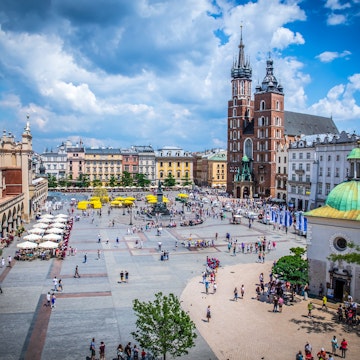
Awesome, you're subscribed!
Thanks for subscribing! Look out for your first newsletter in your inbox soon!
The best things in life are free.
Sign up for our email to enjoy your city without spending a thing (as well as some options when you’re feeling flush).
Déjà vu! We already have this email. Try another?
By entering your email address you agree to our Terms of Use and Privacy Policy and consent to receive emails from Time Out about news, events, offers and partner promotions.
Love the mag?
Our newsletter hand-delivers the best bits to your inbox. Sign up to unlock our digital magazines and also receive the latest news, events, offers and partner promotions.
- Los Angeles
Get us in your inbox
🙌 Awesome, you're subscribed!

The 13 best things to do in Warsaw
The best things to do in Warsaw include food halls, forts filled with art, bars dedicated to Depeche Mode and more

Poland ’s sprawling capital has a chequered history, including brutal Medieval warfare and occupation during World War II—and you can explore all that and more when tackling each one of the best things to do in Warsaw. This is reflected in the city's architecture, from Gothic churches to tall Soviet skyscrapers. Cooler than the more touristy Krakow , Warsaw has undergone a major foodie revival in recent years and has also developed a thriving art scene in the warehouses littered throughout the city. Budget airlines offer direct flights here for as little as £35 return— and, as it's Eastern Europe, you can expect to actually come home with leftover spending money despite living like a king while in town.
Done something on this list and loved it? Share it with the hashtag #TimeOutDoList and tag @TimeOutEverywhere.
Find out more about how Time Out selects the very best things to do all over the world .
An email you’ll actually love
Best things to do in Warsaw

1. Praski Park
What is it? A large park in the east of the city, dating back to the nineteenth century.
Why go? On first glance, this might seem like a regular park. But there's a surprising difference. Real life brown bears have been living on the concrete island of Praski Park (which is also called Praga Park) since 1945. There are currently three beasts living there – Tatra, Mała and Sabina – but although they look cuddly, don't be lured into the enclosure for a bear hug. People have been mauled in the past.

2. Muzeum Neonów
What is it? A gallery showcasing a large collection of neon signs dating from 1950 to the 1970s.
Why go? Located in trendy artists' hub the Soho Factory, in the east (of course) of Warsaw, this Instagram-friendly warehouse is packed full of neon advertising signs from the shops, bars and restaurants of Cold War-era Warsaw that were saved and restored following the collapse of the Soviet Union.

3. Hala Koszyki
What is it? A giant indoor complex comprising of 18 restaurants and several street food stalls.
Why go? This Art Nouveau market was refurbished and reopened two years ago as a gastronomic paradise. You can eat a meal in one of the numerous restaurants that serve up anything from Italian to Hawaiian cuisine or buy fresh produce and prepare dinner at home. With martinis for just £3.50 it would be rude to not stop off at the bar.

4. Beirut Hummus & Music Bar
What is it? Grazing plates and colourful cocktails are the order of the day at this neighbourhood bar.
Why go? Middle-Eastern food is very popular in Poland, and there are loads of kebab shops around the city. If you're looking for somewhere a bit more lively, Beirut Hummus & Music bar is a local favourite, where you can share platters of hummus, falafel and halloumi burgers while listening to indie hits from the 2000s.

5. Kraken Rum Bar
What is it? Just next door to Beirut is Kraken Rum Bar, another small establishment where you can try Polish rum.
Why go? This dive joint specialises in rum, of course – and a must-try is the spirit made especially for the bar by the brewers at Artezan, Poland's smallest brewery. Kraken also serves up seafood at bargain prices. You can get a seafood platter and a cocktail for £9 here, which is surely some sort of record.

6. Klub Hydrozagadka
What is it? This small nightclub in an arch hosts regular gigs by local bands and 1980s electronica nights.
Why go? Two things are exceptionally popular in Poland: getting trashed on vodka and dancing to 80s’ synth dinosaurs Depeche Mode. Luckily, you can do both these things at the same time at Klub Hydrozagadka, a trendy joint where locals party the night away in quirky warehouse surroundings.

7. Bar Bambino
What is it? A traditional Warsaw 'milk bar' where you can sample traditional Polish cuisines, such as perogies, stodgy dumplings filled with fillings such as meat and spinach.
Why go? Milk bars have a bit of a misleading name – they aren't the ones you'd find Alex and his droogs from ‘A Clockwork Orange’ plotting their wicked ways in, they're actually low-priced cafeterias selling dairy-based Polish food. Bambino is known as being the best. If you don't speak Polish it's worth asking for the English-speaking menus they keep behind the counter.

8. Bazar na Kole
What is it? Bazar na Kole is a flea market open Saturdays and Sundays from 6am to 3pm, where it's rumoured you can literally buy anything.
Why go? Whether you're looking for old photographs, interesting furniture, traditional Polish handicrafts or vintage clothing and bags, you won't be disappointed by the bargains on offer at this bi-weekly market. Even if you're not planning to part with cash, a stroll in the fresh air rummaging through the stalls will cure you of your vodka hangover in no time.

9. Chopin's Heart
What is it? The heart of famous Polish composer Frédéric Chopin, interred away from his body in a monument inside Warsaw's Holy Cross Church.
Why go? Chopin died in Paris in 1849. Before his death he made the gruesome request that his heart be taken from his corpse and sent back to his home country. His sister Ludwika complied, smuggling it back to Warsaw in cognac before it was interred in this city centre church. The monument became a rallying point for nationalists during the German occupation and was even stolen by the Nazis before being returned after the war.

10. Galeria Forty/Forty
What is it? A hidden art gallery in an abandoned Warsaw fort.
Why go? This spot can be tricky to find – but it is well worth it when you do. The walls of this abandoned fort, dating back to the 1880s, are open 24/7, and are covered in images, text and installed art by Polish artists. Works created by those invited to the project are mixed with graffiti spontaneously added by uninvited artists, giving it an unusual appearance.

11. Gestapo HQ (Mausoleum of Struggle and Martyrdom)
What is it? The former headquarters of the Gestapo when the Nazis occupied Poland, this is now a poignant memorial to the thousands of Poles who passed through its doors to be interrogated and tortured.
Why go? Now a Polish government building, this was the scene of war crimes undertaken by the German secret police during the 1940s. After the war ended, it was decided that the jails where people were held should remain untouched, in tribute to the brave souls who were taken there. It is a harrowing look at not-too-distant-history.

12. Keret House
What is it? The narrowest house in the world, this art installation is meant to represent elements of Warsaw's history.
Why go? This unusual structure was conceived by renowned Polish architect Jakub Szczesny, and is now open for ticketed tours inside. Be warned, however, it is a very tight squeeze, measuring at just over 3ft at its thinnest point and almost 5ft at its thickest. The house is named after an Israeli writer of Polish descent, Etgar Keret, who was invited by Szczesny to live there.

13. Bubbles
What is it? Boozing in Warsaw is not all vodka, as this popular bar specialising in fizz proves.
Why go? A short walk away from the Gothic Old Town, this restaurant and bar has a vast selection of champagne and prosecco, with prices starting from a mere £1.50 a glass. There's also an interesting – and cheap – menu to compliment your drinks, including raclette, caviar, blinis, and beef tartare. Proof you can live a champagne lifestyle on a lemonade budget after all.
[image] [title]
Discover Time Out original video
- Press office
- Investor relations
- Work for Time Out
- Editorial guidelines
- Privacy notice
- Do not sell my information
- Cookie policy
- Accessibility statement
- Terms of use
- Modern slavery statement
- Manage cookies
- Advertising
- Time Out Market

Warsaw is a city full of attractions. You will find the atmospheric Old Town, magnificent royal palaces, museums that tell the history of Warsaw and Poland, and the bustling boulevards on the Vistula. Discover the capital’s biggest attractions.

Warsaw - Official Tourist Website
© warsaw tourism office.
- Privacy policy
- Accessibility declaration
About Cookies
Privacy overview.

40+ Incredibly Cool Things to Do in Warsaw, Poland
I admit it, I didn’t know what to expect from Warsaw. On the one hand, I remembered it as grey and boring from one day on a bad high school trip years ago; on the other hand, I read about so many amazing places and cool things to do in Warsaw while I was planning my trip.
I’m happy to say that Warsaw is worth visiting , and I think it is a remarkable destination for a city break (you can enjoy it in 2-3 days, but I recommend spending 4 days here), though you can also add it to a longer Central Europe itinerary .
Surprisingly, it’s also an amazing winter break in Europe and a girls’ trip destination ! From museums and historical monuments to bustling modern streets and trendy cafes , this historic city has it all.
It also made me want to visit other cities in Poland like Wroclaw, Gdansk, and Poznan (a total visit-worthy hidden gem ). To help you make the most of your time in this lovely place, here is my epic Warsaw bucket list.
* This post may contain affiliate links from which I earn a commission (for more info, read my disclosure ). As an Amazon Associate, I earn from qualifying purchases.
* I try to keep the information on this blog as updated as possible, but I still recommend consulting the latest prices, opening hours, and other details on the official website of each site, hotel, and tour, as well as checking the updated public transport routes and timetables.

My favorite carb in Warsaw: Pierogi and potato pancakes at Zapiecek (on Nowy Świat 64, although it has several locations).
Planning a last-minute trip? Check out: Highly-rated accommodations in Warsaw: 1. Warsaw City Center Rooms (budget) 2. Warsaw Heritage Apartment (mid-range) 3. MONDRIAN Luxury Suites UNESCO Old Town (luxury)
Top experiences in Warsaw: 1. Polish dumpling cooking class (with vegetarian and vegan options) 2. Chopin concert in the Royal Castle with a glass of wine 3. Polish food tour
Top day tours from Warsaw: 1. Auschwitz-Birkenau tour with lunch 2. Treblinka day tour 3. Wolf’s Lair day tour
Table of Contents
Cool Things to Do in Warsaw for History and Culture Lovers
Take some unique free tours.
There’s no shortage of fascinating free walking tours to take in Warsaw, including:
- Free tour of the old town , a UNESCO site
- Jewish history of Warsaw free tour (one of my favorites!)
- Free tour of the intriguing Praga district (another experience I loved)
- Communist Warsaw free tour
- WWII free tour
Visit the Wilanow Palace and Gardens
Being one of the few famous landmarks in Warsaw that have survived WWII, you can understand the importance of the Wilanow Palace.
This royal palace was built in the 17th century for King John Sobieski the 3rd, and with every new owner, it was enlarged and redecorated.
Apart from its beautiful yellow front facade and art-packed interiors, the palace also has impressive wide gardens and a lake. I recommend getting there right when it opens so that you can take some pictures before the crowded hours.
If you’re visiting Poland in winter or fall, you can also enjoy the Royal Garden of Light , an event in which the complex is magically decorated with thousands of twinkling lights forming unique displays.
Opening hours and prices: Consult them here . Notice that on Thursdays there’s free admission for a limited number of entries.
If you want to explore the palace with a guide, book a private guided tour here .
Getting there: Buses 116, 180, and 519 go from the city center to the palace.

See Sigismund’s Column and Castle Square
Sigismund’s Column is one of the most important monuments in Warsaw as King Sigismund Vasa the 3rd was the one to move Poland’s capital from Krakow to Warsaw.
The memorial stands in the historic Castle Square, which is one of the most famous squares in the city.
The square has gone through some difficult times throughout Polish history, and during WWII, it was destroyed. Nowadays, it is reconstructed and surrounded by beautiful townhouses.
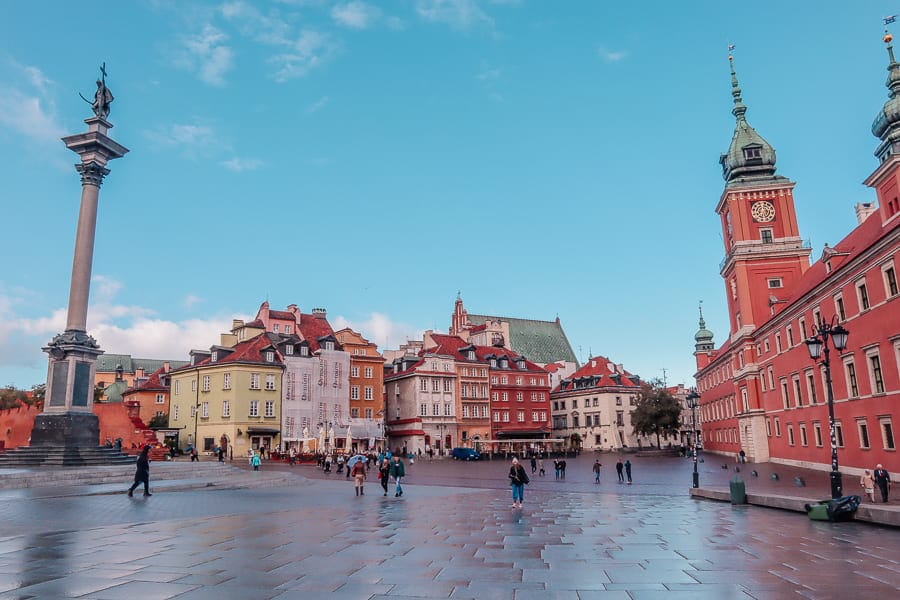
Tour the Royal Castle
If there’s one thing you cannot miss when you’re in Castle Square, it’s the Royal Castle, which used to be the official residence of the Polich monarchs.
After a long and challenging history including reconstruction after WWII, it is now listed as a UNESCO World Heritage Site (as a part of the historic center), making it a Warsaw must-see.
Apart from its gorgeous facades, you can visit the museum inside it, which includes its luxurious rooms and art galleries. Consult prices and opening hours here (note that on Wednesdays, you can enter the castle for free).
You can also book a guided tour of the Royal Castle. Extra tip: The castle also hosts Chopin concerts , which you can book here.

Enjoy the Views From St. Anne’s Church’s Bell Tower
Located near the Royal Castle, head to St. Anne’s Church for some scenic views of Castle Square. If you’re up for the challenge, climb over 145 stairs to get to the bell tower’s balcony and admire the colorful scenery.
The church itself dates back to the 15th century and is one of the few buildings that weren’t completely destroyed during WWII.
Wander Through the Old Town
Fun fact about Poland : It’s home to 17 UNESCO World Heritage Sites, and the Historic Centre of Warsaw is one of them. The Polish capital’s Old Town (Stare Miasto) was reconstructed after WWII while trying to resemble its previous architectural look.
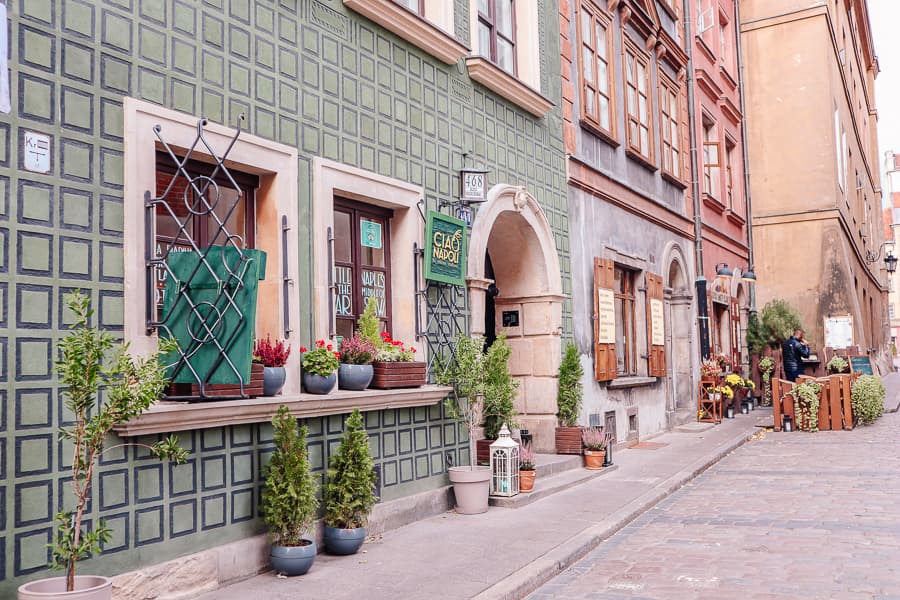
The main thing to see in the Old Town is the Old Town Market Place, one of the most beautiful squares I’ve ever seen.
Each building in the square has a different color and unique embellishments, and with the medieval architecture, the entire area boasts an irresistible charm.
Also, in the square and the colorful streets surrounding it, you’ll find many restaurants, cafes, and shops. Although the area is not that big, take your time and explore this magical piece of history.
To learn more about Warsaw’s Old Town, take a FREE walking tour or book this highly-rated segway tour !

Feel the Powers of the Wishing Bell
Dating back to the 17th century, this bronze bell statue is located in Canon Square in the Old Town. If you want to feel its magical powers and make a wish, I’ve read a few versions of what you need to do.
The basic one says to think about your wish and circle the bell. The second version says that you also need to touch it as you go around it.
My favorite, of course, is the one that states that you need to touch it and jump around it on one leg. If you are looking for unusual things to do in this city, there you have it.
Admire the Warsaw Barbican
Dating back to the 16th century and restored after WWII, the Warsaw Barbican is one of the few remains of the city’s system of fortifications.
Today it’s more of a tourist attraction in Warsaw, but since it looks like it belongs in a fairytale, I’m okay with that.

Visit the Chopin Museum
By Rai from A Rai of Light
The Chopin Museum is an opportunity to get a taste of the life of Poland’s most famous composer, Frédéric Chopin.
This multimedia museum (located within the Ostrogski Palace) houses the collection of Chopin’s work, some of his belongings, his piano, and even a handful of old photographs and letters.
Although lacking organization and information is often presented without context, the museum has a range of interactive activities to better understand his life, work, and travels.
What I particularly enjoyed was the listening room where you can sit and listen to Chopin’s masterpieces.
Consult prices and opening hours here (note that it offers free admission on Wednesdays.
To learn even more about the famous composer, take a guided Chopin tour (that also includes a visit to the museum).
Admire the Krasinski Palace
Also known as the Palace of the Commonwealth, this 17th-century Baroque palace is a non-touristy place in the heart of Warsaw.
The Krasinski Palace’s front facade, along with the surrounding gardens and park, make it a wonderful photo spot in the city.
Tour the Palace on the Isle (Lazienki Palace)
Another landmark from the 17th century that survived WWII is the Palace on the Isle in the famous Lazienki Park. The uses this building has had over the years are a bathing pavilion, a royal summer residence, and barracks.
Nowadays, it is one of the top things to see in Warsaw, and you can either visit the museum inside it or just admire its exterior. Consult prices and opening hours here .

Walk the Royal Route
The Royal Route is a famous route in Warsaw that connects three former royal residences: Royal Castle, Palace on the Isle, and Wilanow Palace.
It includes some of the places I’ve mentioned, but the full route covers 11 km and passes alongside a variety of streets, museums, palaces, and churches. For more info about the full route, read here.
See the Miniature Park at śWiętokrzyski Park
If you like miniatures and architecture, this is the place for you. The goal of this museum is to showcase some of Warsaw’s important buildings that were not restored after the war.
I expected the museum to be a bit bigger, but I still think that the concept is cool and essential to the city’s historic preservation.

Visit the National Museum in Warsaw
Boasting a collection of about 830,000 works of Polish and foreign art, the National Museum in Warsaw is one of the largest and oldest art museums in Poland.
From paintings to sculptures to photographs, there’s so much to see in this impressive museum. Consult opening hours and prices here.
Take a Free Tour of the Praga District
You might not expect this from Warsaw, but it’s home to some spectacular street and urban art. Most of it can be found in the Praga district which is on the other side of the city’s river.
I took this free walking tour to learn about the local street art scene and Praga, and it was extremely interesting because this district was curious and unusual.
I love seeing the alternative side of a city, and Praga ticked that box for me.

Explore More of Praga
As I’ve mentioned, Praga is one of the most intriguing places to see in Warsaw. But did you know that during WWII, 80% of Warsaw was destroyed, but only 20% of Praga was destroyed?
One of the most interesting things about the tour I talked about was seeing the contrast between modern pastel residential buildings and authentic pre-war architecture that has survived.
Old buildings with bullet holes in them alongside new colorful townhouses are not a usual thing to see, so I recommend exploring more of this fascinating area.

Visit the Warsaw Uprising Museum
By Kami from My Wanderlust
Warsaw Uprising Museum is one of the most interesting museums in Warsaw and a must-visit. It’s dedicated to the 1944 Warsaw Uprising, a tragic 63-day event during WWII.
It was one of the most important events in the history of Warsaw when the local people tried to fight the Nazi occupant. The fall of the Uprising led to the total destruction of the city.
You can learn all about the Warsaw Uprising, the events leading to it, and the exact course at the museum.
It’s a very interactive and interesting place, and even if you are not an expert in Polish history, you will surely enjoy your visit. You should also go to the lookout towers that offer nice views of the neighborhood.
Address : Grzybowska 79. Consult prices and opening hours here (free to visit on Mondays).
Visit the Palace of Culture and Science
The Palace of Culture and Science is one of the top sights in Warsaw and a prominent Polish landmark that you can see from many spots in the city.
It is the tallest building in Warsaw and is home to museums, libraries, theatres, and the main tourist information office (and many other cultural facilities).
Besides its impressive exterior, you can buy a ticket to take the lift and see the views of the city from above (or take a guided tour that includes access to the terrace ).

Take a Free Jewish History Walking Tour
I have visited many cities that had a connection to my Jewish heritage (mostly in Spain but also in other countries).
However, a lot of Warsaw’s Jewish history is obviously much more famous and closer to our present time. That’s why taking a walking tour seemed like a must-try free activity in Warsaw .
I took a free walking tour that included several points of interest in Warsaw like the Nozyk Synagogue, the area where the bridge between the Small Ghetto and the Large Ghetto had stood, and the Ghetto Heroes Monument.
The tour talked about centuries of Polish Jewish history (not only the Holocaust), so it was even more informative and intriguing than I had expected.
Get all the details of this free Jewish history walking tour and reserve your spot . You can also book a private Warsaw Ghetto walking tour.

Head to Mila 18
Mila 18 was the address of the main bunker of the Jewish resistance force in the Warsaw Ghetto. During WWII, a few weeks after the Warsaw Ghetto Uprising had started, the bunker was found by the Germans.
Instead of surrendering, the 300 people who were in the bunker decided to end their lives so they could die as heroes and not as victims.
Today, there is a small monument and a commemorative stone in Mila 18, and personally, I think everyone should visit it.
A big part of traveling is getting to know local history and other cultures, and it’s not always happy or easy to deal with. But we need to learn about these things anyway, so we can honor others and step outside of our own bubbles.

Visit the Polin Museum of the History of Polish Jews
The POLIN Museum is located where the Warsaw Ghetto used to be, and it showcases the whole history of Jews in Poland.
It is one of the largest museums of Jewish history in Europe, containing eight galleries, each dedicated to a different historical era. It is the last stop of the free walking tour I mentioned, so you can visit it right after.
Skip the lines, and get your ticket to the POLIN Museum in advance , or visit for free on Thursdays.
Take a Free Warsaw in Wwii Tour
80% of Warsaw was completely destroyed during WWII, and much like many other cities in Europe, it is inconceivable what happened here in these six years.
So if you want to dive into that time in history and learn more about Warsaw during WWII, take this free tour .

Wander the Open-Air Tibetan Gallery
Situated in the Wola district, this unique urban art gallery, Galeria Tybetańska, started taking shape after the Dalai Lama visited Warsaw.
It is filled with paintings showcasing the Tibetan struggle to get autonomy from China and is an unusual colorful corner in the city.
Photograph Some Cathedrals
I was pleasantly surprised when I saw some of Warsaw’s religious buildings like St. Florian’s Cathedral, Metropolitan Cathedral of Saint Mary Magdalene, and St. John’s Cathedral. If you love architecture, I’m sure you’ll appreciate them as well.

Take a Free Communism Walking Tour
With how modern Warsaw seems today, it’s easy to forget that up until 30 years ago, there was still a communist regime in Poland.
If you want to know what it was like to live under communist rule, hear some intriguing urban legends , and see a few landmarks connected to that time, this tour is for you.
Visit the Neon Museum
Another thing to do in Praga is to visit the Neon Museum. It is dedicated to the preservation of the neon signs of the communist era in Poland.
Here you can see different neon signs from that time that were saved from destruction and learn about their history. Consult prices and opening hours here.
To be honest, it sounds good on paper and looks super cool in the photos, but I thought it would be bigger and a bit more impressive.

Want to see more of Poland? Check out this incredible Krakow itinerary !
Best Things to Do in Warsaw for Foodies
Eat pierogi.
When visiting Poland, eating pierogi is a must! These dumplings from Central and Eastern Europe are filled with all kinds of savory or sweet fillings and served with some toppings like onions.
The famous Polish restaurant Zapiecek (which has several locations in Warsaw) offers a large variety of pierogi, and I highly recommend eating there.
In some cases, the famous establishments are overrated, but I loved the food at Zapiecek so much! With perfect flavors, many vegetarian options, and even sweet pierogi for dessert, I would gladly go back there for one more bite.
Eat at a Milk Bar
Milk bars are traditional Polish diners serving hearty Polish food at ridiculously low prices.
They were first founded in the late 19th century and served only dishes made from dairy, but today, they serve all types of local traditional food.
I tried Rusalka (Florianska 14) in Praga, and it was the perfect comfort food lunch.

Eat Potato Pancakes
Also served as both savory and sweet, potato pancakes are another great Eastern European delight you need to try.
At Zapiecek, I ate them with cream and mushroom sauce, but you can find them in cafes or even some ice cream shops served with berries and whipped cream.
Eat Some Paczki (Polish Donuts)
I didn’t expect to see so many bakeries and patisseries in Warsaw, and one thing that stood out was Polish donuts. They are impossible to miss and are served in almost every bakery and cafe.
Indulge in Hot Chocolate at E. Wedel
I am a total sucker for hot chocolate, and E. Wedel (Szpitalna 8) could not have been a more perfect place to savor a cup.
E. Wedel is actually a well-known company that produces high-quality chocolates and sweet snacks, but they also have chocolate lounges in cities like Warsaw and Krakow.
Apart from the neverending menu (which is impossible to choose from), the cafe itself looks like a palace and is absolutely beautiful!
I would happily go back for another cup of their perfect thick hot chocolate and enticing elegant atmosphere.

Explore Warsaw’s Indoor Food Markets
Warsaw is home to a few indoor markets, including Hala Mirowska (a more traditional market), Hala Gwardii, and Hala Koszyki (which are both quite trendy).
Their buildings are worth visiting just for the architecture, but while you’re there, have a little stroll and grab a bite.
Other Fun Places to Visit in Warsaw
Lazienki park.
After mentioning its most famous monument, it’s impossible not to write about Lazienki Park itself. It is the largest park in Warsaw and is just a beautiful place where you can easily spend a few hours.
The park houses many other monuments like the Chopin statue (on Sundays during the spring and summer, you can enjoy a free Chopin concert near it), but the main ones that also require a ticket are the Palace on the Isle, the Old Orangery, and the Royal Theatre.
Consult their prices and opening hours here .
University of Warsaw Botanic Gardens
Located in the northern part of Lazienki Park, the botanical gardens are a feast for the eyes.
At first sight, it seems like another pretty garden, but after only a few minutes it becomes so much more. With so many different species, some parts look like a colorful house garden, and some look like a giant forest.
It is quite a big place, so don’t rush it and take your time while exploring this stunning site. See prices and opening hours here .

Copernicus Science Center
By Karolina from Lazy Travel Blog
The largest science center in Poland, the Copernicus Science Centre in Warsaw is a place that you should not miss.
Whether you are a full-on geek, a kid-at-heart, or someone who’s never been interested in science, the museum’s stunning exhibits will give you a good show with their concerts and laser shows.
A perfect place to go if you are on a family or a romantic trip to Warsaw , Copernicus Science Centre is a space where curiosity and love of learning are cultivated with its exhibits and experiments.
Consult prices and opening hours here .
Pinball Museum
If you’re looking for quirky attractions in Warsaw, head to the Interactive Pinball Museum, where you can be a kid again and enjoy more than 80 pinball and arcade machines.
For a fixed one-day entrance fee, you can play as many times as you want without having to use any coins/chips to turn on the machines. Browse the latest opening hours and prices.
University Library Gardens
These gardens on the University of Warsaw Library roof are one of the most beautiful places in Warsaw. The gardens include two sections – the lower part and the upper part where each has different characteristics.
In the gardens, you’ll see ponds, granite sculptures, and many varieties of vegetation, all combined in a mesmerizing decor.
Although the upper part is only open from April to October, the lower part is open all year round. Plus, the entrance is free !
Address: Dobra 56/66.
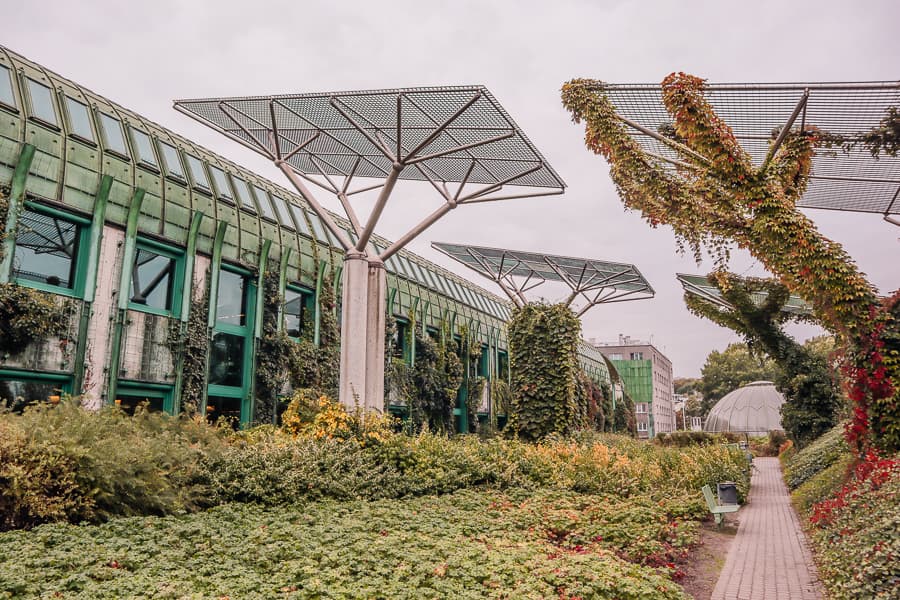
Saxon Garden
One of the most famous parks in Warsaw, the Saxon Garden (Ogród Saski) is an unmissable place in the Polish capital.
Dating back to the 17th century (when the royal Saxon Palace was standing next to it), it’s the oldest public park in Warsaw and one of the first in the world.
While some parts of it are prettier than others, it is a nice place for a stroll, and it’s also home to the famous Tomb of the Unknown Soldier, a monument dedicated to unidentified fallen soldiers.
The Presidential Palace
Originally built in the 17th century, the Presidential Palace is, as the name suggests, the official residence of Poland’s president.
Though it’s not open to the public, you can admire it on the outside while you stroll along Krakowskie Przedmieście street.
Nowy Swiat Street
Nowy Swiat is one of the main streets in Warsaw. After being almost completely destroyed in WWII, it is now fully reconstructed.
It’s a great area to stroll around since it’s packed with restaurants, cafes, shops, beautiful buildings, and an inviting atmosphere.
Enjoy a Night Out at Pawilony
If you’re looking for fun things to do in Warsaw at night, this is a great one. Pawilony or The Nowy Swiat Pavilions are a group of 25 small bars and pubs located right next to each other.
This unique area offers all kinds of bars (cocktail, shot bars, craft beer pubs, etc.) and a good atmosphere, making it popular all week long.
Website: pawilonynowyswiat.pl/en/ .
You might also love:
- 4 days in Vienna
- Free museums in Vienna
- Beautiful European squares
Did you like this post? Pin it for later using the share icon on the right bottom corner!
About Or Amir
Hey, I'm Or! I'm a passionate traveler with a severe coffee, chocolate, and pastry addiction (or any other carb for that matter). I'm always planning my next trip to Spain, Italy, or any other country in Europe, and my goal is to help you make the most of each destination.
17 thoughts on “40+ Incredibly Cool Things to Do in Warsaw, Poland”
It is best about Warsaw I have ever read I am Warsaw citizen for over thirty years and I still don’t know some of these places I am very experienced travelled so I can compare Warsaw to many capitals in the world And I know I live in great very quick changing city Thank you very much for great advertisement of Warsaw I am impressed
Thank you, Robert! That means a lot. I’m curious to know what places you didn’t about!
Great article! I loved Warsaw so very much. Old Town, Wilanow Palace, The Warsaw Zoo, and a street art tour of the Praga district were some of the highlights from my trip. Not to mention the food. I loved the milk bars and delicious pierogi!
Thank you! It really is a great destination!
Thanks for the great guide. I recently spent a week in Warsaw and fell in love with the city. From Wilanow Palace to E. Wedel, the city is one of my favorites in Europe.
I’m glad this was helpful! It’s a wonderful city to explore.
Warsaw is now on my bucket travel list for when we can get back on traveling, thanks for sharing your knowledge with us!
You’re welcome, Valentina! I’m sure you’ll love it 🙂
Such a helpful guide to Warsaw! I’ve only been to Krakow but would love to visit Poland again, the food was so good. I never visited a Milk bar but I need to try it.
Thank you! Poland is worth exploring and you’re right about the food 🙂
Amazing post! I only had about 2 days in Warsaw and didn’t get to see near enough of it. But loved the Old Town area and ate some amazing pierogies!
Thanks so much! Pierogis are paradise 🙂 2 days are definitely not enough – I was surprised too by all the things you can do in Warsaw 🙂
wow, very informative. Thank you so much. Your article has helped me a lot for my plan to Warsaw this july.
I’m happy you find it helpful! Enjoy your trip to Warsaw and let me know if you have any questions 🙂
*Your emil address will not be published. By using this form you agree with the storage and handling of your data by this website
Leave a Comment Cancel reply
Save my name, email, and website in this browser for the next time I comment.
Hi, I'm Or!
I'm a passionate traveler obsessed with traveling in Europe and discovering hidden gems in each place I visit. For me, it's not about ticking destinations off the bucket list but experiencing each one of them to the fullest. Read more about me and my story.


31 Best Things to Do in Warsaw, Poland | 2024 (with Photos)

James A. Smith - Chief Editor
Last Updated: January 4, 2024
Hey! How’s it going? I’m James, an avid traveler and enthusiast of exploring different cultures. In this article, I'll guide you through an incredible journey in Warsaw, Poland, sharing my personal recommendations to make your trip unforgettable.

Warsaw, the capital city of Poland, is a vibrant metropolis that offers visitors a fascinating blend of old and new.
While the city is best known for its rich culture and history, Jewish heritage, and reconstructed Old Town, there are also many unique and fun things to do in Warsaw.
Whether you're interested in exploring the local food scene, discovering the city's street art, or experiencing the nightlife, Warsaw has something for everyone.
In this article, we'll take a closer look at the best things to do in Warsaw , so you can make the most of your visit to this exciting city.
Most Recommended Thing to Do
Warsaw Uprising Museum
Top Choice Hotel
InterContinental Warsaw.
Our Top Choice Restaurant
San Restaurant
Our Top Choice Bar for Nightlife
Level 27 Sky Bar
Best Time to Visit
Summer for festivals, winter for magical Christmas markets.
Average Temperature
The average temperature in Warsaw, Poland is moderate.
Transportation Options
Metro, trams, buses, taxis, bicycles, scooters, rideshares, walking.
Average Cost ($, $$, $$$)
My Top Recommendation
When visiting Warsaw, Poland, I highly recommend taking a leisurely stroll through the picturesque Old Town. The charming cobblestone streets, colorful buildings, and historic landmarks make for a truly enchanting experience.
For a more immersive cultural experience, be sure to visit the POLIN Museum of the History of Polish Jews. This captivating museum tells the story of the vibrant Jewish community that once flourished in Warsaw, providing a deeper understanding of the city's rich history and heritage.
What You'll Need to Bring
- Money/Credit cards
- Suitable clothing for the weather
- Comfortable walking shoes
- Travel adapter
- Travel guidebook
- Maps or navigation app
- Toiletries and medication
- Camera or smartphone for capturing memories
- Travel insurance
What Not to Miss
- The historic Old Town: Stroll through the charming cobblestone streets, admire the colorful buildings, and visit the iconic Royal Castle.
- Wilanów Palace: Explore this magnificent Baroque palace and its stunning gardens which showcase the rich history and grandeur of Warsaw.
- Warsaw Uprising Museum: Learn about the heroic Warsaw Uprising during World War II through fascinating exhibits and immersive displays.
- Lazienki Park: Take a leisurely walk in this picturesque park, home to a stunning palace on the water, beautifully manicured gardens, and even a resident peacock.
- POLIN Museum of the History of Polish Jews: Discover the rich history and cultural heritage of Polish Jews at this award-winning museum.
What to Avoid
- Crowded tourist areas
- Scams and pickpocketing
- Demonstrations or political protests
- Unlicensed taxis or overly expensive taxi fares
- Street vendors selling counterfeit goods
Table of Contents

1. Explore the Old Town
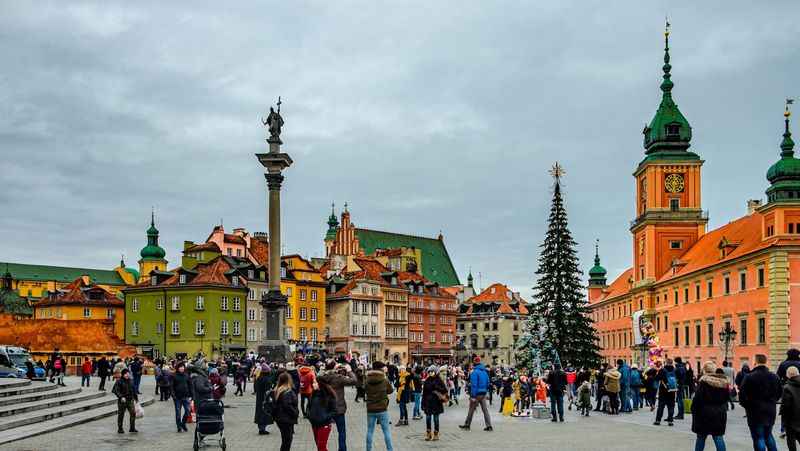
The Old Town in Warsaw is a picturesque area that is steeped in history and culture.
It was almost completely destroyed during the Second World War but has since been restored to its former glory, earning it a place on the UNESCO World Heritage List .
Visitors can explore the cobblestone streets, stunning architecture, and historic landmarks, such as the Royal Castle and the Old Town Market Square.
The vibrant atmosphere of the Old Town, combined with its rich history and stunning architecture, make it a must-visit destination for anyone looking to experience the unique charm and character of Warsaw.
2. Visit the Royal Castle and Castle Walls
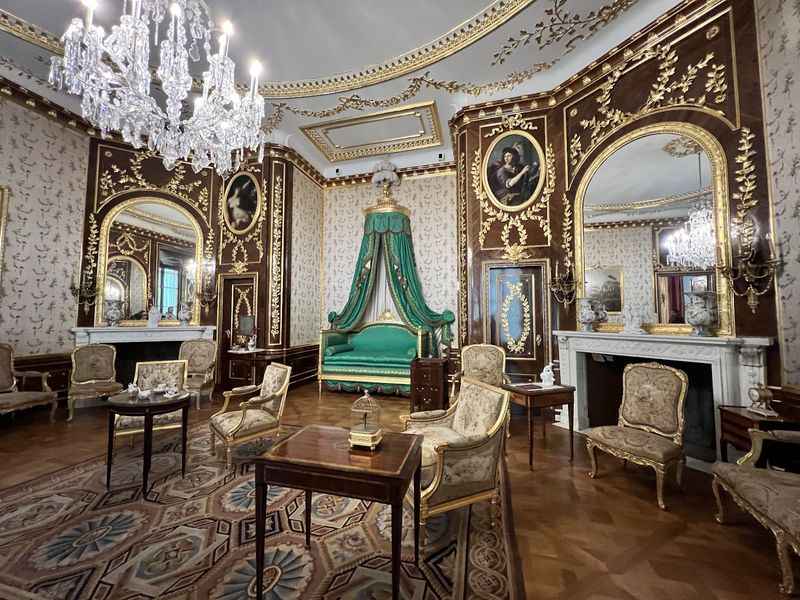
The Royal Castle served as the official residence of the Polish monarchs and a center of political life for centuries.
The castle was almost completely destroyed during World War II but was reconstructed in the 1970s and is now a protected UNESCO World Heritage Site .
Nearby, visitors can explore the Castle Walls , which were built in the 14th century and served as a defensive fortification for the city.
Today, the walls offer panoramic views of Warsaw's historic Old Town and the Vistula River.
3. Walk the Royal Route
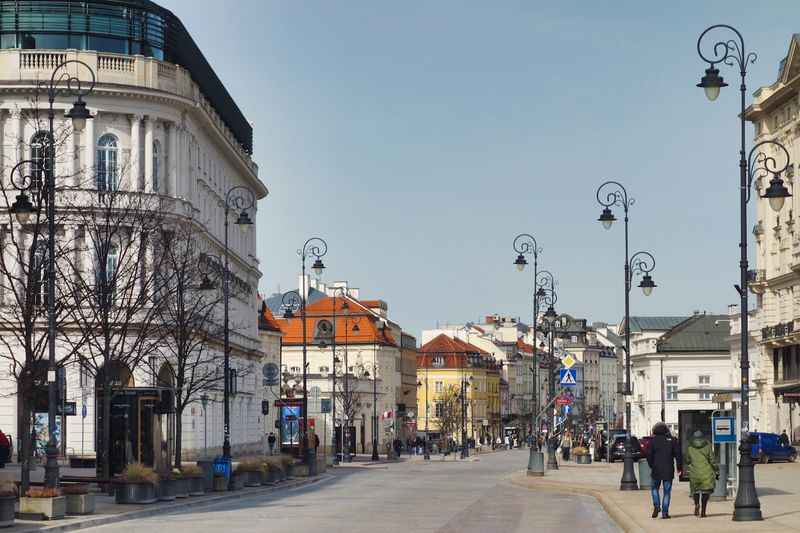
Once the ceremonial path of the Polish monarchs, the Royal Route is lined with some of Warsaw's most beautiful and significant landmarks.
This 11-kilometer-long street was almost completely destroyed during World War II, but it has since been rebuilt and restored to its former glory.
Walking the Royal Route to the Presidential Palace offers visitors a glimpse into the city's rich royal heritage.
Along the way, visitors can also stop at charming cafes, boutique shops, and historic landmarks, such as the Warsaw Barbican and the Church of the Holy Cross.
4. Spend some time at Castle Square
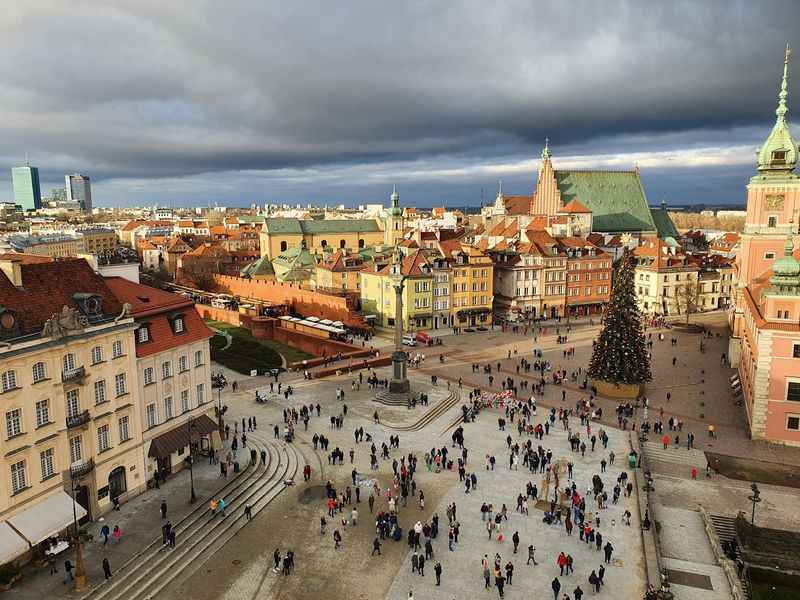
Castle Square is one of the most picturesque and historic places in Warsaw.
It is home to the iconic Royal Castle and is surrounded by colorful buildings and charming cafes. Visitors can explore the castle and its surrounding grounds and learn about the fascinating history of the Polish monarchy.
The square is also a hub of activity, with numerous events and festivals held throughout the year, including outdoor concerts, art shows, and street performances.
Visitors can also relax and people-watch at one of the many cafes or restaurants lining the square. A visit to Castle Square is a must for anyone interested in Polish history, culture, and architecture, and offers a unique opportunity to experience the vibrant and dynamic energy of Warsaw.
5. Visit the POLIN Museum of the History of Polish Jews
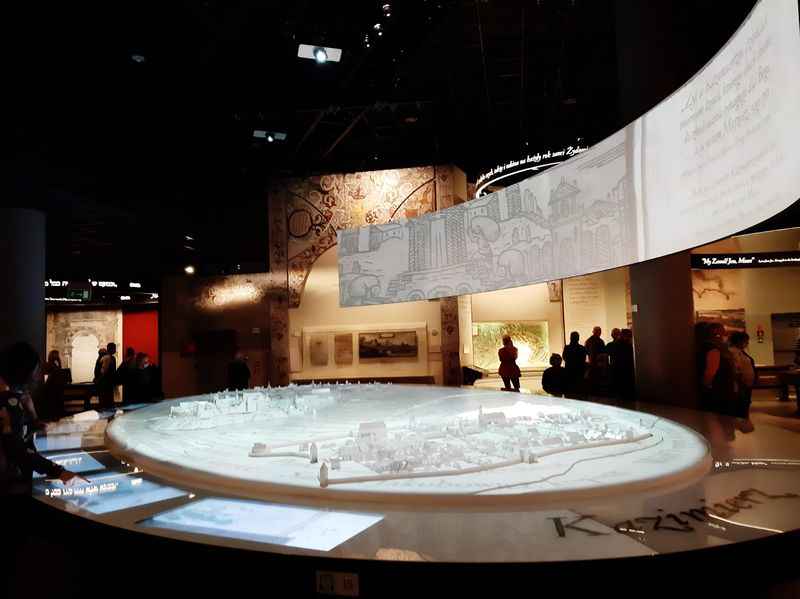
The POLIN Museum of the History of Polish Jews , located in the heart of the former Warsaw Ghetto, houses eight galleries that tell the story of the Jewish community in Poland from its beginnings to the present day. This is arguably one of the most important things to do in Warsaw.
It explores the rich and complex history of Polish Jews, including the tragic events of the Holocaust and the Warsaw Ghetto Uprising.
The museum features interactive exhibits and multimedia installations, making it an immersive and engaging experience. For anyone interested in Jewish culture or social justice, a visit to the POLIN Museum is a must.
6. Enjoy some experiments at the Copernicus Science Center
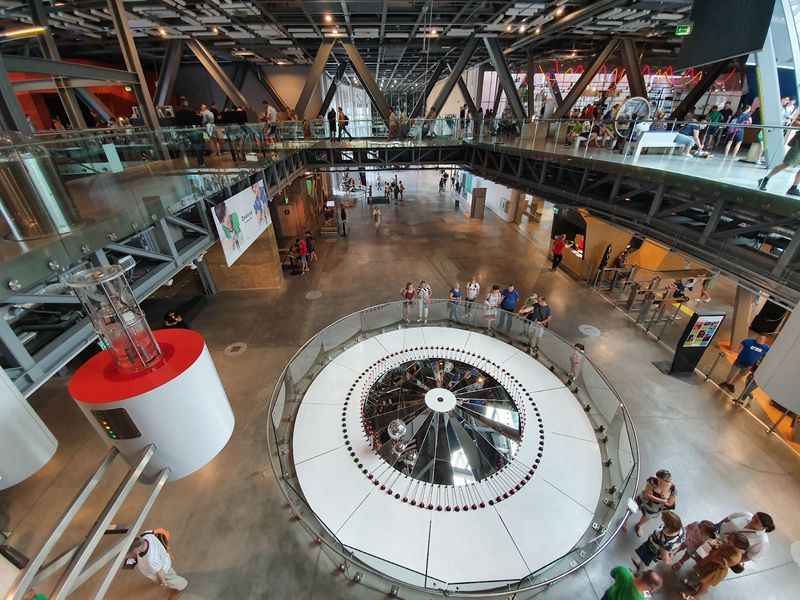
One of the best things to do in Warsaw for science lovers, the Copernicus Science Centre is a state-of-the-art science museum in Warsaw that offers a unique and interactive experience on a wide range of scientific topics, including biology, physics, chemistry, and technology.
Visitors to the Copernicus Science Centre can participate in experiments and activities that showcase the principles of science in a fun and engaging way.
The Copernicus Science Centre features hands-on activities making it a great destination for families and science enthusiasts, and visitors can learn about everything from astronomy to robotics.
7. Visit the Warsaw Uprising Museum
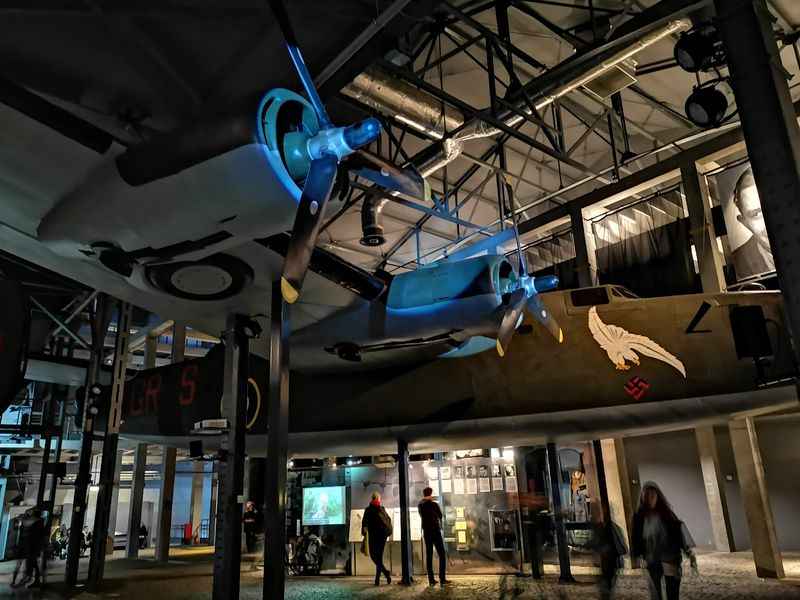
The Warsaw Uprising Museum tells the story of the Warsaw Uprising of 1944, in which the Polish resistance fought against Nazi occupation forces.
Warsaw Uprising Museum has an extensive collection of exhibits, including weapons, photographs, and personal accounts of the participants in the uprising.
Visitors can see artifacts and multimedia displays that bring this harrowing period of history to life.
You can learn about the planning, execution, and aftermath of the uprising, as well as the everyday lives of the people of Warsaw during the war.
The Warsaw Uprising Museum is a must-visit destination for anyone interested in history, politics, or social justice.
8. Stop by St. Anne's Church
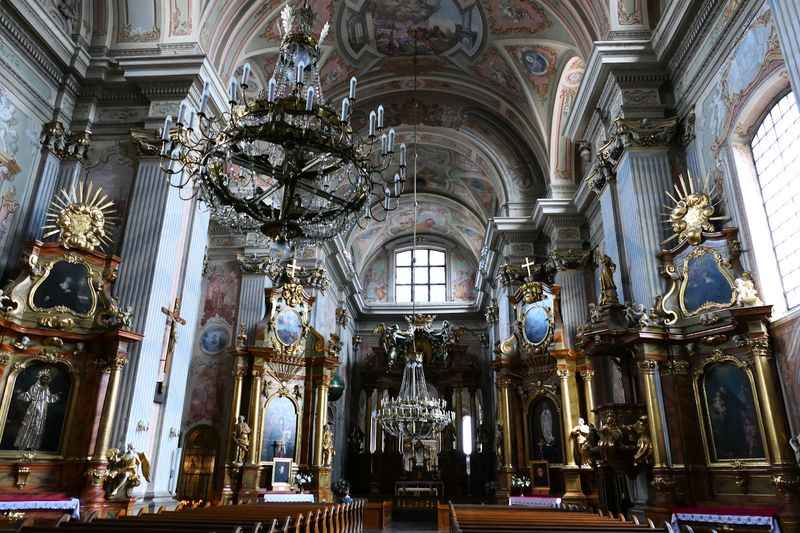
St. Anne's Church is a stunning Baroque church located in the heart of Warsaw's Old Town. Built in the 18th century, St. Anne's Church has survived war and reconstruction to remain one of the most beautiful and significant buildings in the city.
Visitors can attend mass or simply explore the church's interior, which features stunning frescoes, sculptures, and altarpieces.
A visit to St. Anne's Church offers a unique opportunity to experience the rich cultural heritage of Poland and admire some stunning works of art.
9. Explore Łazienki Park
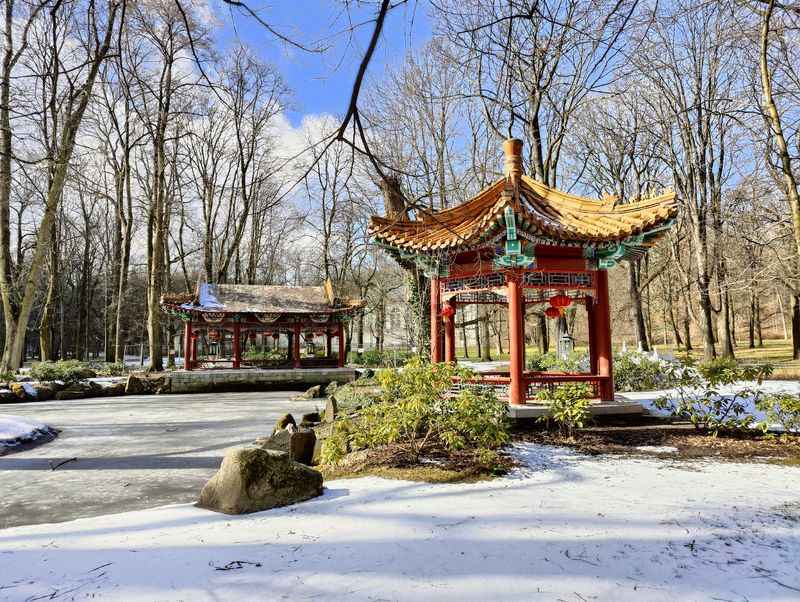
Lazienki Park , also known as the Royal Baths Park, is the largest park in Warsaw and one of the city's most beloved attractions.
It is home to numerous gardens, fountains, and statues, as well as several historical buildings and monuments.
Visitors can take a stroll through the park's winding paths, admire the peacocks that roam freely, and explore the stunning Palace on the Water, a palace built on an artificial island in the park's lake.
In the summertime, Lazienki Park also hosts concerts and open-air theater performances.

10. Pay your respects at the Tomb of the Unknown Soldier
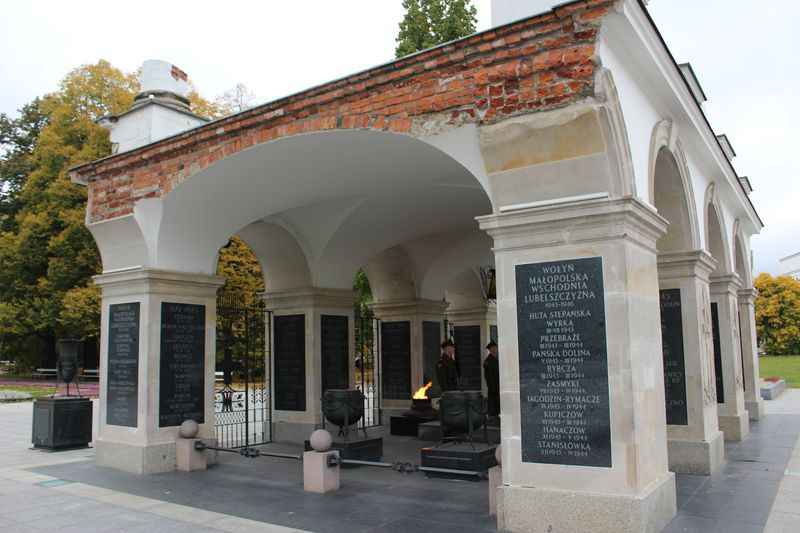
The Tomb of the Unknown Soldier is a solemn and moving memorial to the countless soldiers who lost their lives fighting for Poland's freedom.
Located in Warsaw's Piłsudski Square, the tomb holds the remains of an unidentified soldier who died in the Polish-Soviet War.
Visitors can witness the changing of the guard ceremony, which takes place every hour.
A visit to the Tomb of the Unknown Soldier is a humbling and thought-provoking experience, and a powerful reminder of the sacrifices made by those who fought for freedom and justice.
11. Explore the Frederic Chopin Museum
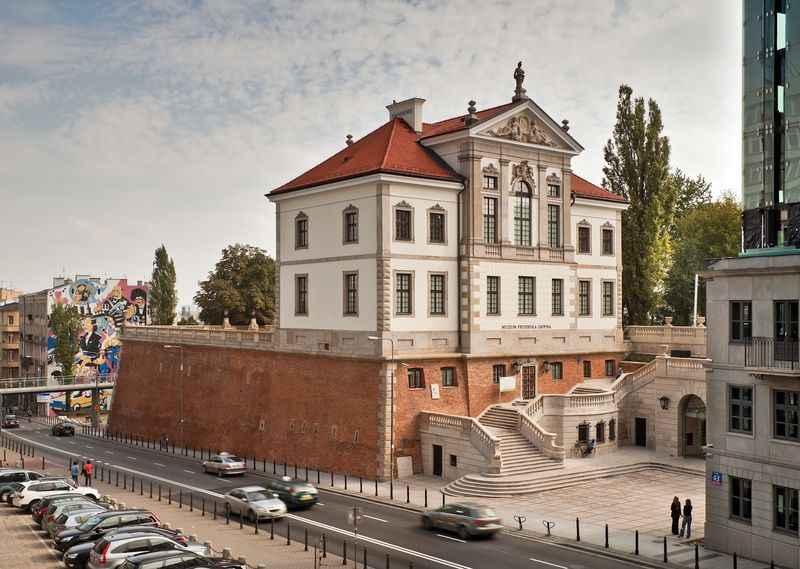
The Frederic Chopin Museum is dedicated to the life and legacy of one of Poland's most famous composers. Visitors can explore the various rooms of the museum, each dedicated to a different aspect of Chopin's life and work.
The museum contains a vast collection of Chopin's personal belongings, including original manuscripts of his compositions, letters, photographs, and musical instruments.
Visiting the Frederic Chopin Museum in Warsaw is a must for anyone interested in classical music, history, or culture.
12. Step inside the Holy Cross Church
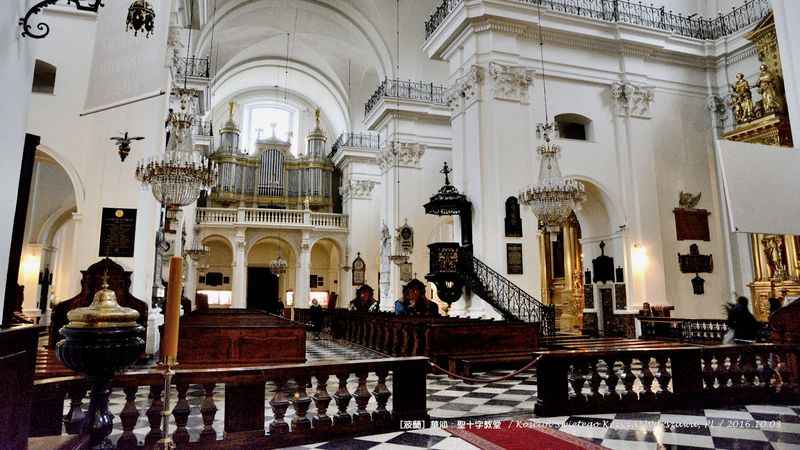
The Holy Cross Church , located in the heart of Warsaw's historic district, is a beautiful church that dates back to the 17th century.
It is perhaps best known as the final resting place of the great composer Frederic Chopin, whose heart is preserved in an urn embedded in one of the church's pillars.
The church's elegant Baroque interior features intricate carvings, stunning frescoes, and beautiful stained glass windows. Visitors can attend mass, explore the church's interior, and pay their respects to one of Poland's most beloved cultural icons.
13. Visit Old Town Market Square
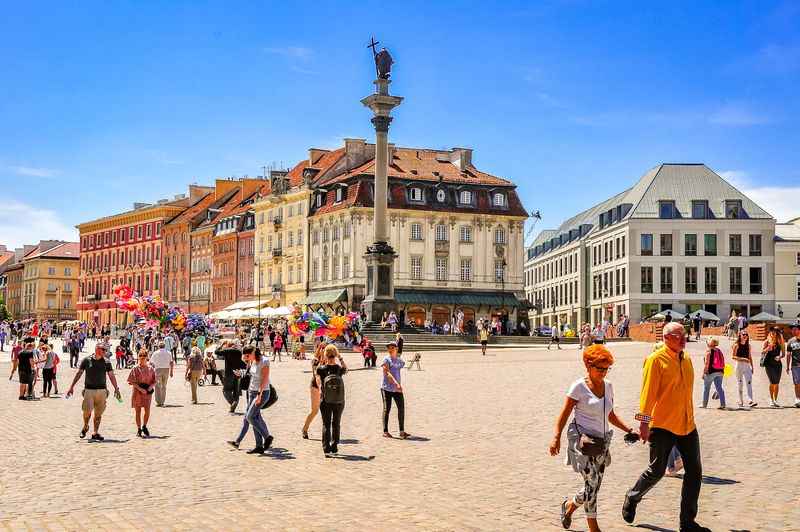
The Old Town Market Square in Warsaw is one of the most charming places in the city. It features colorful and ornate buildings, including the Renaissance-style Old Town Hall and the stunning St. John's Cathedral.
The Old Town market square is a lively spot filled with outdoor cafes, street performers, and market stalls.
It's an ideal place to soak up the vibrant atmosphere of Warsaw and enjoy a cup of coffee or a meal while taking in the picturesque surroundings.
14. Take a walk through the Saxon Garden

The Saxon Garden is one of the oldest public parks in the Polish capital. The garden dates back to the 18th century and is located right in the heart of Warsaw's city center.
Visitors can also see the remnants of the Saxon Palace, a grand Baroque building that was once a symbol of Polish royalty.
Despite being destroyed during World War II, the palace's ruins remain a testament to the city's history, and a stroll through the Saxon Garden is an opportunity to take in some of Warsaw's rich cultural heritage.
15. See the iconic Warsaw Mermaid statue
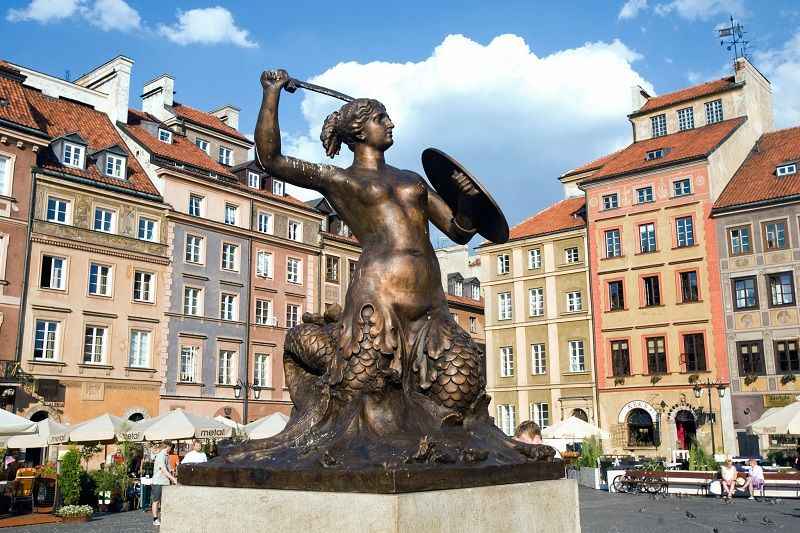
The Warsaw Mermaid is a symbol of the city and a beloved icon of Warsaw. The statue depicts a mermaid holding a sword and shield. It has been a symbol of the city since the 14th century.
According to legend, the mermaid was once captured by fishermen who heard her singing but was eventually freed by a young fisherman who fell in love with her.
Today, the Mermaid is a popular tourist attraction, and visitors can find her statue in several locations throughout the city, including in the Old Town and along the Vistula River.
16. Check out the Warsaw Barbican
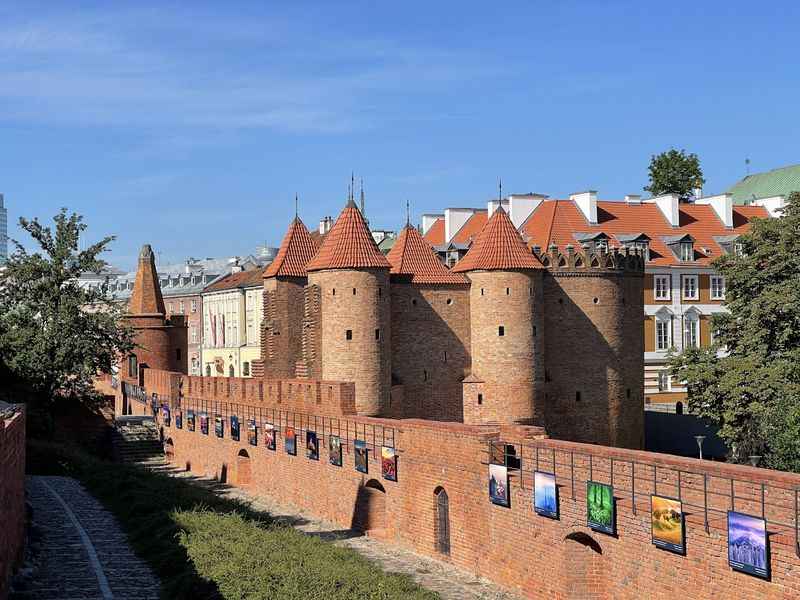
The Warsaw Barbican is a historic fortification and a popular tourist spot in the city of Warsaw.
Built in the 16th century as a part of the city's defensive walls, it is now one of the few remaining examples of such fortifications in Europe.
Visitors can explore the bastion and its ramparts, which offer stunning views of the surrounding area. The place is also a symbol of the city's resistance against foreign invaders, as it was the site of many battles throughout its history.
Its unique architecture and historical significance make it a must-visit attraction for anyone interested in the city's past.
17. Admire the art at the National Museum
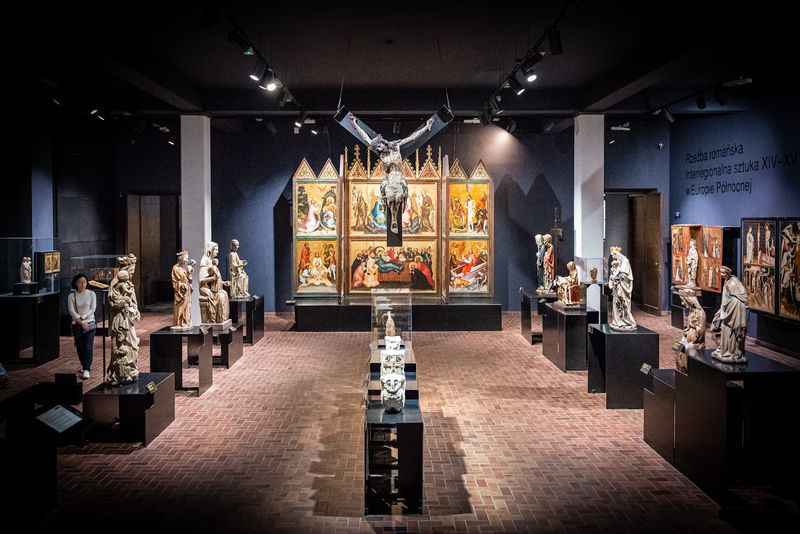
The National Museum in Warsaw is one of the largest museums in Poland, featuring an extensive collection of Polish art and historical artifacts.
The museum's collections include over 830,000 objects, ranging from ancient art to contemporary works, and cover a variety of themes such as painting, sculpture, decorative arts, and numismatics.
The museum's permanent galleries showcase some of the most important works of Polish artists such as Jan Matejko, Jozef Brandt, and Jacek Malczewski, as well as international artists including Rembrandt, Rubens, and Rodin.
In addition to the permanent collection, the museum also hosts temporary exhibitions and educational programs.
18. Visit the Okopowa Street Jewish Cemetery

Okopowa Street Jewish Cemetery is the largest Jewish cemetery in Warsaw and one of the largest in Europe. It was established in 1806 and served as the final resting place for many notable Polish Jews, including rabbis, politicians, and artists.
The cemetery was an important site during the Holocaust, as it was located within the confines of the Warsaw Ghetto.
Visitors can pay their respects to those buried there and learn about the lives and legacies of those who shaped the Jewish community in Warsaw.
Again, visiting this place is one of the most important things to do in Warsaw.
19. See the Jewish Ghetto Memorial
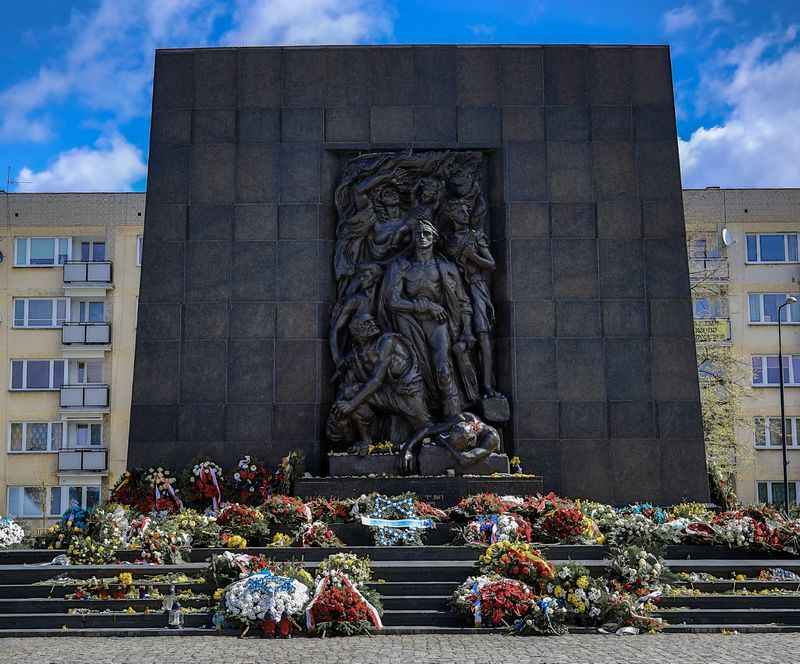
The Jewish Ghetto Memorial in Warsaw serves as a poignant reminder of one of the darkest periods in human history.
It is located in the former Jewish Ghetto, established by the Nazis during World War II, where thousands of Jewish people were imprisoned.
The memorial honors those who lost their lives in the ghetto. Visiting the Jewish Ghetto Memorial is a humbling experience that allows visitors to pay their respects to those who suffered and lost their lives during this tragic time in history.
20. Visit the Grand Theatre

The Grand Theatre , or Teatr Wielki in Polish, is one of the most prestigious cultural institutions in Warsaw. This theater in downtown Warsaw is known for its world-class opera, ballet, and theater performances, and has hosted some of the most famous performers in the world.
Built in the 19th century, the Grand Theatre has a rich history and has survived wars and revolutions, making it a symbol of the resilience and strength of Polish culture.
Visitors can attend a performance at the Grand Theatre, take a guided tour of the building, or simply admire its beautiful neoclassical architecture from the outside.
21. Enjoy the Vistula River on a Boat Tour
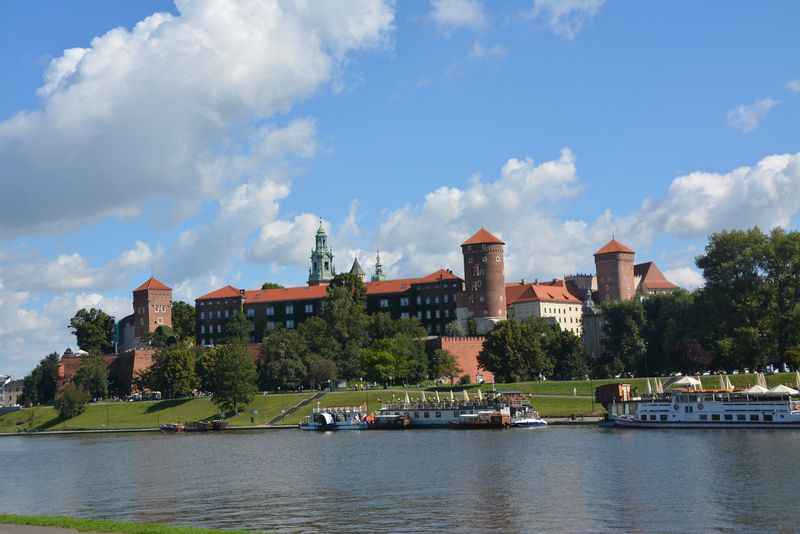
The Vistula River is one of the defining features of Warsaw, and exploring it on a boat tour is an excellent way to experience the city from a different perspective.
The river winds its way through the heart of the city, offering stunning views of Warsaw's skyline and its many historic landmarks.
As you glide along the river, you can see iconic sights such as the Warsaw Old Town, the National Stadium, the Palace of Culture and Science, and many more.
Along the way, you'll also learn about the history of the river and its importance to the city's development.
22. Explore the Warsaw University Library Garden

The Warsaw University Library Garden is a peaceful oasis in the bustling city of Warsaw. Located in the heart of the city center, this garden is a popular spot for students, locals, and tourists alike.
The garden is beautifully landscaped and features a variety of plants, as well as several water features and sculptures. Visitors can take a stroll through the garden, find a quiet spot to read a book, or simply enjoy the tranquility of this hidden gem.
The Warsaw University Library Garden is a must-visit destination for anyone looking to escape the noise and chaos of the city and find some peace and quiet.
23. Visit the Museum of King Jan III's Palace
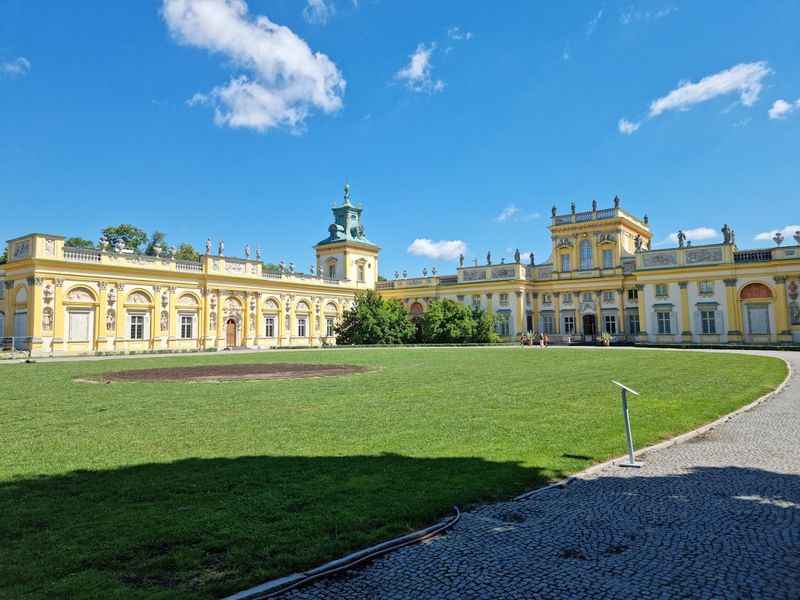
The Museum of King Jan III's Palace , also known as Wilanow Palace , is one of the most beautiful and historic palaces in Warsaw.
Built in the 17th century, the palace was originally the summer residence of King Jan III (King John III Sobieski) and his wife, Queen Maria Kazimiera.
Today, the palace is a museum that showcases the rich history and culture of Poland through its impressive collection of art, furniture, and decorative objects.
Visitors can explore the interiors and its beautiful gardens, and learn about the fascinating lives of the Polish monarchs who once called it home.
24. Spend an afternoon at Warsaw Zoo

Warsaw Zoo , located in the heart of the city, is home to a wide variety of animals, including elephants, lions, tigers, giraffes, and monkeys. In addition to the animals, the zoo offers visitors the opportunity to learn about conservation efforts and participate in educational programs.
Since opening its gates nearly a century ago, the zoo has now become one of the busiest in Europe.
With its beautifully landscaped gardens and modern facilities, it is an ideal place to spend an afternoon.
The zoo also offers special events and exhibitions throughout the year, making it a must-visit attraction for animal lovers and families visiting Warsaw.
25. Take a hike at Kampinos National Park
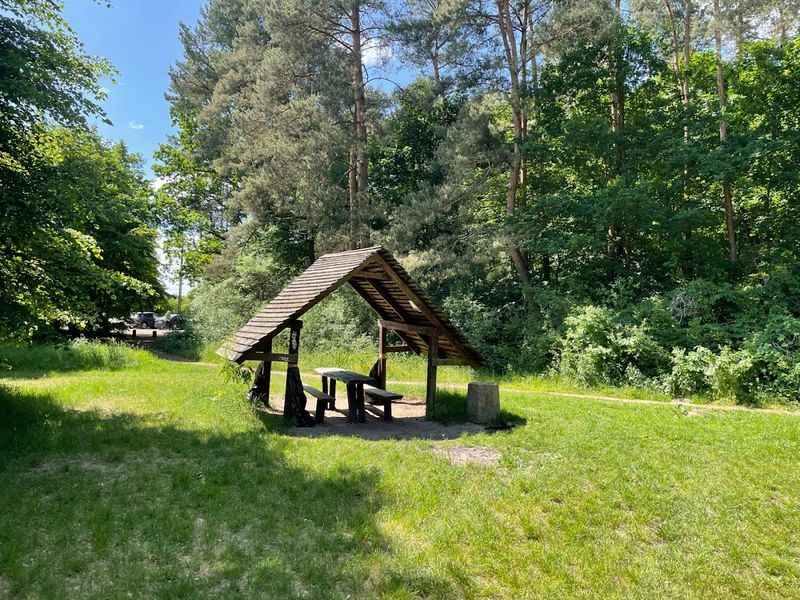
Kampinos National Park is a beautiful natural area located just outside of Warsaw.
The park is home to a variety of wildlife, including wild boar, deer, and over 150 species of birds, making it a popular destination for nature lovers and birdwatchers.
Visitors can explore the many hiking and biking trails, which wind through forests, meadows, and wetlands.
Additionally, the park is home to several historic landmarks, including an 18th-century palace and a former military training ground from World War I.
26. Enjoy the cafes and bars at Koszykowa Street
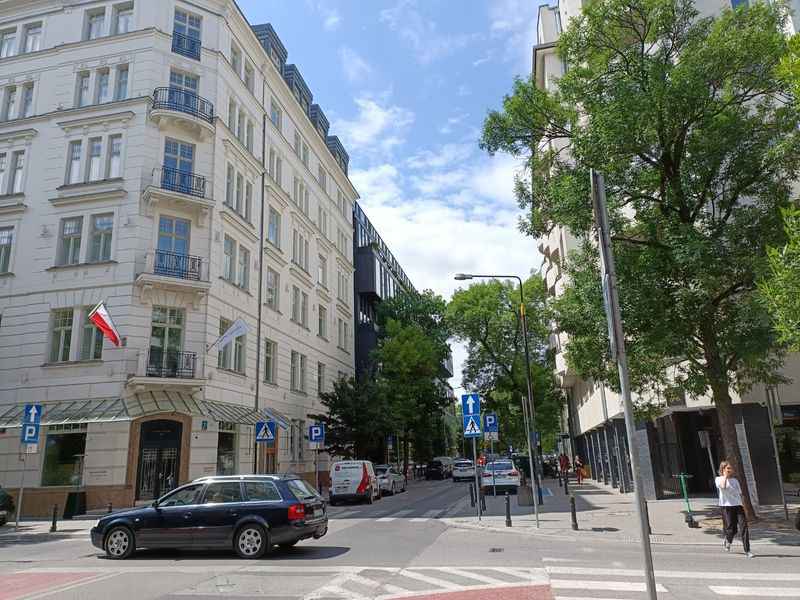
Koszykowa Street is one of the most vibrant and eclectic streets in Warsaw, offering visitors a unique glimpse into the city's cultural and social scene.
The street is lined with a variety of cafes, bars, and fine dining establishments, each with its own distinct character and charm.
Visitors can enjoy everything from traditional Polish cuisine to international fusion dishes, as well as a variety of craft beers and cocktails.
Koszykowa Street is also home to several boutiques and art galleries, making it a great destination for shoppers and art lovers alike.
With its lively atmosphere and diverse cuisine, Koszykowa Street is a top destination for anyone looking to experience the best of Warsaw's culture.
27. See the Palace of Culture and Science
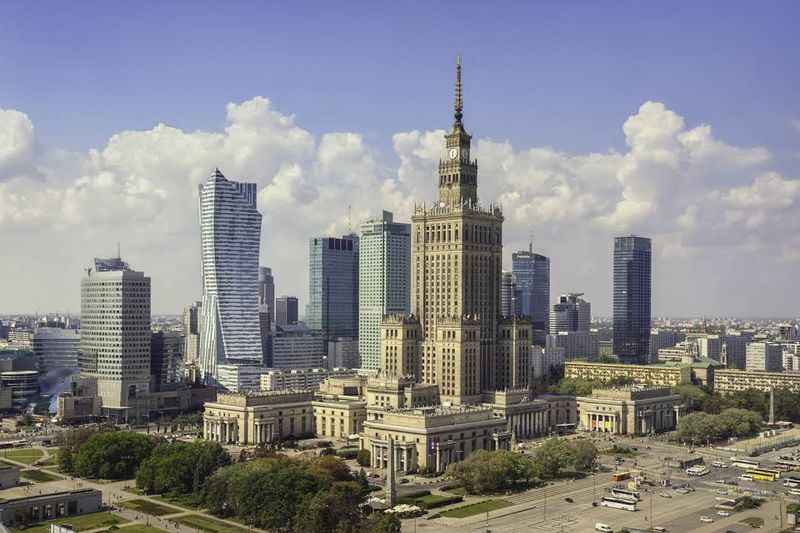
The Palace of Culture and Science is one of Warsaw's most iconic landmarks and a must-visit attraction for anyone traveling to the city. It is the eighth tallest building in the European Union and the tallest in the continent.
Completed in 1955, the palace was a gift from the Soviet Union to Poland and stands as a symbol of Poland's post-World War II reconstruction.
The building houses a variety of cultural and scientific institutions, including theaters, museums, and an observation deck on the 30th floor, where you can enjoy panoramic views of Warsaw's skyline.
28. See a light show at Multimedia Fountain Park
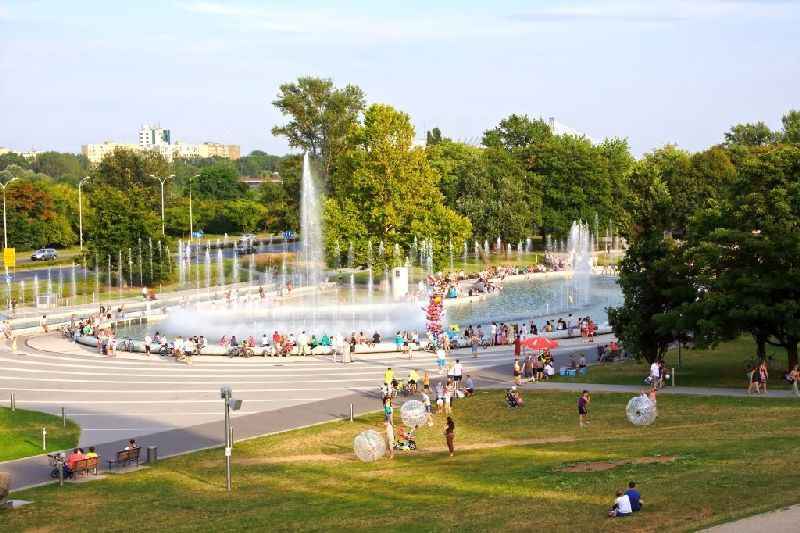
Multimedia Fountain Park is one of the most popular attractions in Warsaw, offering visitors a stunning display of music, water, and light.
The park features a large fountain system that uses a combination of water jets, lasers, and lights to create a variety of visual effects and synchronized music performances.
The show is constantly changing, with different themes and musical genres showcased throughout the year.
Visitors can watch the show from the park's amphitheater or from the nearby river, where they can also enjoy a panoramic view of the city skyline.
29. Hop on a Fiat 125p for a ‘Retro Tour’
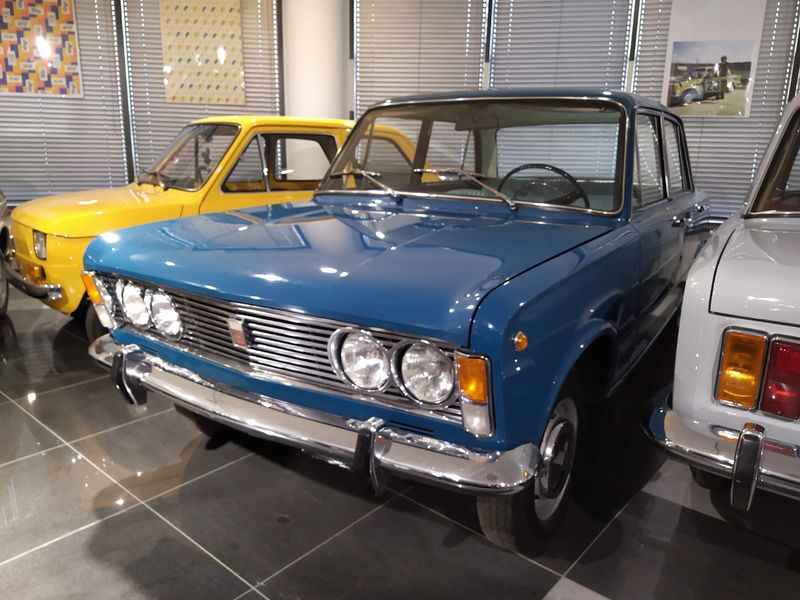
A retro car tour of Warsaw is a thrilling way to experience the city's rich history and cultural heritage.
Visitors can hop into a vintage car and take a ride through the city's charming streets and iconic landmarks, such as the Old Town, the Palace of Culture and Science, and the Royal Route.
The tour guides, dressed in retro clothing, will share fascinating stories and insights into the city's past, bringing Warsaw's history to life in a fun and engaging way.
The vintage cars, such as the iconic Trabant or Fiat 125p, add to the retro ambiance, providing an authentic and immersive experience of Warsaw's golden age.
30. Visit the Zachęta – National Gallery of Art
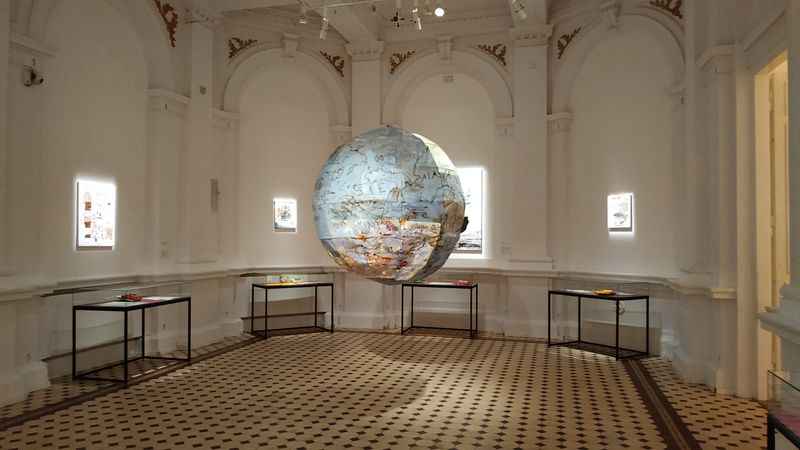
Zachęta , the National Gallery of Art , is a renowned cultural institution in Warsaw. The word "Zachęta" means "encouragement", which reflects the gallery's mission to encourage and promote contemporary art in Poland.
The gallery was established in 1860 and has since become a leading center for art and culture in the country.
Visitors can explore the vast collection of contemporary and modern art, attend workshops and lectures, and participate in other engaging events and programs.
The gallery's name not only reflects its mission but also its role in shaping the art and culture of Poland.
31. Cool off at Moczydło Water Park
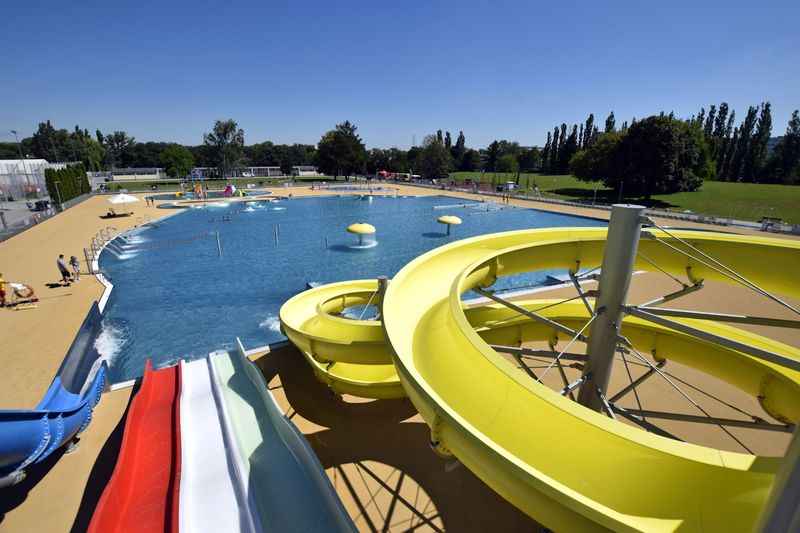
Moczydło Water Park is a popular destination for anyone looking to beat the summer heat in Warsaw.
The park features a variety of swimming pools, including a wave pool, a paddling pool for young children, and several other pools of varying depths.
Visitors can also enjoy exciting water attractions such as water curtains, drenching overflow buckets, and a turtle-shaped slide.
The park also has sports facilities and a relaxation area with sun loungers and umbrellas. With its fun and exciting attractions, as well as its relaxing atmosphere, Moczydło Water Park is the perfect destination for visitors of all ages looking to cool off and have some fun in the water.
FAQs: The Best Things to Do in Warsaw
In this section, we provide answers to frequently asked questions relating to things to do in Warsaw.
Is it worth visiting Warsaw?
Yes, Warsaw is a vibrant city with a rich history and culture, and it offers a unique blend of old and new. The city has undergone significant transformation since the Second World War, and visitors can witness its resilience through the reconstructed old town, museums, and monuments.
Warsaw also boasts a lovely Old Town, beautiful parks, lively markets, great cultural events, and a diverse culinary scene, making it a worthwhile destination for tourists.
Is 2 days enough for Warsaw?
While two days may not be enough to fully explore everything Warsaw has to offer, it is still possible to see many of the city's main attractions in that time.
Visitors can spend one day exploring the Old Town, walking down the Royal Route, visiting Castle Square and the Royal Castle, and enjoying Lazienki Park and some museums.
The second day could be spent discovering the city's modern side, including its nightlife, shopping centers, and trendy neighborhoods.
What is a must do in Warsaw?
There are many must-see attractions in Warsaw, including the Old Town, the Royal Castle, the Palace of Culture and Science, the Warsaw Uprising Museum, the Copernicus Science Centre, the Museum of the History of Polish Jews, and the Łazienki Park.
Visitors should also check out the local food scene, which features traditional Polish cuisine, as well as international options. Other recommended activities include visiting the city's many galleries, catching a performance at the National Opera, and exploring the vibrant nightlife.
Is Warsaw or Krakow better to visit?
Both Warsaw and Krakow are excellent destinations, and the choice between them largely depends on personal preference. Warsaw is a modern, cosmopolitan city with a rich history and culture, while Krakow is a smaller, more charming city with a medieval feel.
Warsaw has a more diverse range of attractions, while Krakow has a more concentrated historic center. Both cities offer excellent food, nightlife, and cultural experiences for history buffs, so it is worth considering what kind of experience you are looking for before making a decision.
Summing Up: The Best Things to Do in Warsaw
As you can see, there are plenty of great things to do in Warsaw. This capital city is a cultural hub that offers a wide variety of activities and experiences for all types of travelers.
From exploring historic sites and learning about the city's role as the bridge between Eastern and Western Europe to strolling along the Royal Route or marveling at the city's Golden Age heritage, Warsaw has something for everyone.
Visitors can also immerse themselves in the city's Jewish heritage, relax in the beautiful Łazienki Park, or shop and dine in the charming old town market square.
Whether you are interested in history, culture, nature, or just having fun, if you decide to visit Warsaw, you are sure to have an unforgettable experience.

Explore the Old Town

Visit the Royal Castle and Castle Walls

Walk the Royal Route

Visit the POLIN Museum of the History of Polish Jews

Enjoy some experiments at the Copernicus Science Center

Visit the Warsaw Uprising Museum
Featured in.

We’re on the road right now – join in on the fun and follow @thebrokebackpacker on IG!
- Meet the Team
- Work with Us
- Czech Republic
- Netherlands
- Switzerland
- Scandinavia
- Philippines
- South Korea
- New Zealand
- South Africa
- Budget Travel
- Work & Travel
- The Broke Backpacker Manifesto
- Travel Resources
- How to Travel on $10/day
Home » Europe » Warsaw
10 BEST Places to Visit in Warsaw (2024)
Warsaw was almost destroyed at the end of World War Two, but it has fought back to become a centre for academics, science, and history. Although there are nods to the city’s past all over, it’s a progressive capital firmly anchored in the present with an eye on the future.
This dynamic and resilient city offers everything you could want from a city break. There are in-depth and fascinating museums, a mix of diverse architecture, a vibrant food and drink scene, and plenty of green spaces to relax and disconnect in.
In this post, we’ll take a closer look at the best places to visit in Warsaw. Hopefully, our extensive list will help you to plan your trip to the Polish capital and have an incredible trip!
First, though, let’s take a quick look at some of the best places to stay in Warsaw.
Need a place quick? Here’s the best neighbourhood in Warsaw:
These are the best places to visit in warsaw, faq on the best places to visit in warsaw.
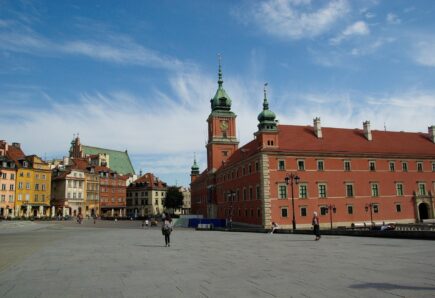
Ironically only about 70 years old, Warsaw’s Old Town is a UNESCO World Heritage Site and the perfect place to stay when you’re visiting for the first time.
- Get a history lesson at the Royal Castle.
- Try some culture at the Adam Mickiewicz Museum Of Literature.
- Try some Polish dishes in one of the many street-side stores.
Warsaw has a variety of different neighbourhoods to choose from when it comes to accommodation. Before you scroll any further down this list, check out where to stay in Warsaw, get the full low-down on the best areas in the city and book yourself a great place to relax!

Unlock Our GREATEST Travel Secrets!
Sign up for our newsletter and get the best travel tips delivered right to your inbox.
#1 – Old Town (Stare Miasto) – A beautiful and scenic place to check out in Warsaw
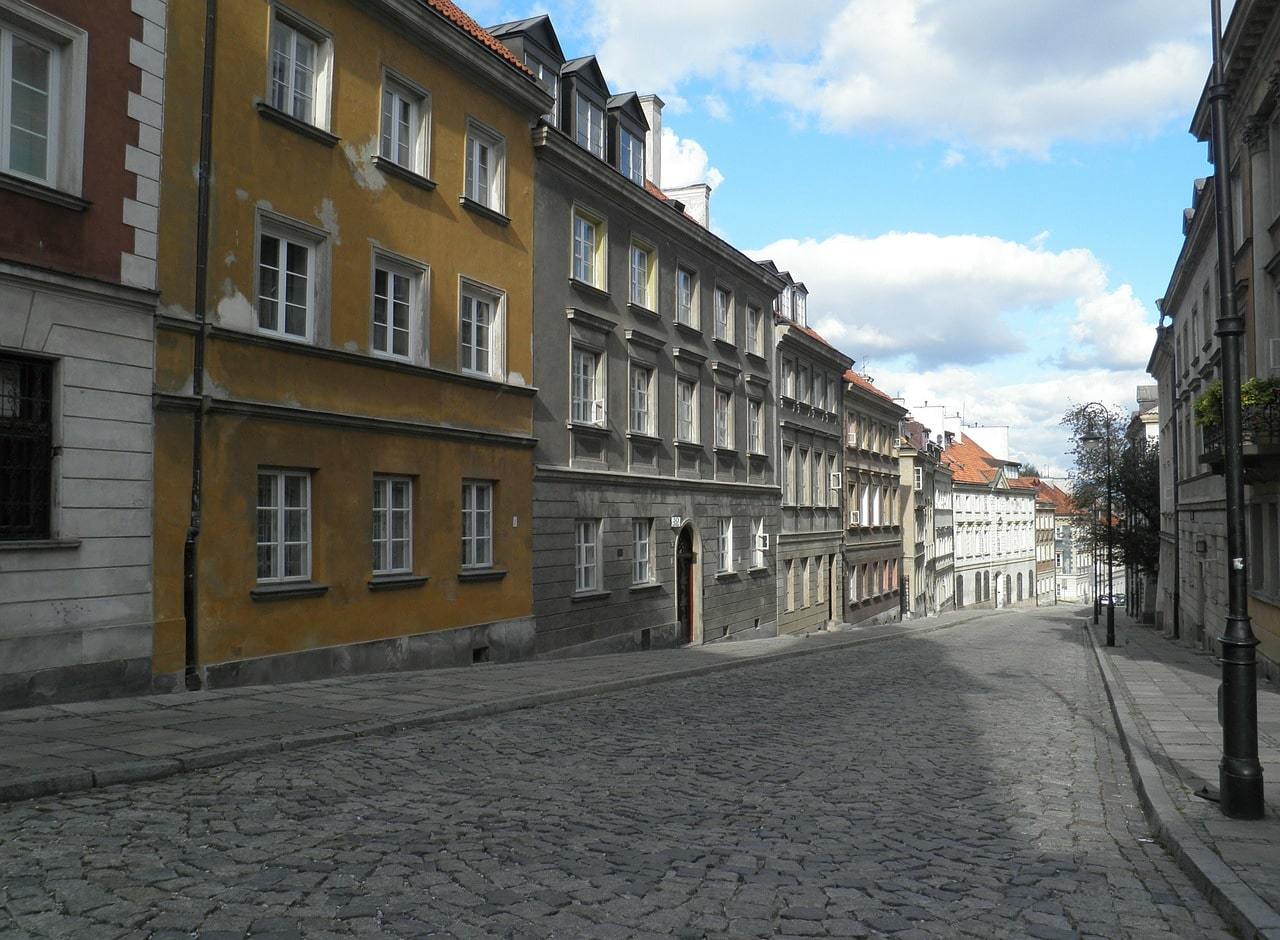
- A UNESCO World Heritage site in the centre of Warsaw
- Wander narrow alleyways that open out onto wide squares and churches
- One of the best places in Warsaw to learn about the city’s past
Why it’s awesome: When walking through the historic centre of Warsaw, you could be forgiven for thinking that these buildings date back to medieval times. However, as the city was razed to the ground during World War II, that’s not quite the case. Almost 90% of Warsaw was destroyed, but it arose like a phoenix from the flames. Nowhere is more emblematic of that than the Old Town. Faithfully and painstakingly reconstructed in 1962, it’s at the top of the list for what to do in Warsaw!
What to do there: Step back in time to get to know the city’s past. Don’t miss St. John’s Arch cathedral, and the triangular Canon square on your jaunt around this cool UNESCO World Heritage site. For a view of the Old Town from above, don’t miss the viewing platform at St Anne’s Church. There are walking tours of the Old Town which will help you learn everything you need to know about it. However, if that sounds like too much hard work, a more fun option is a Segway tour. It’ll be more expensive, but it’ll definitely be a memorable way to explore Warsaw!
#2 – Warsaw Royal Castle – One of the coolest historical sites in Warsaw
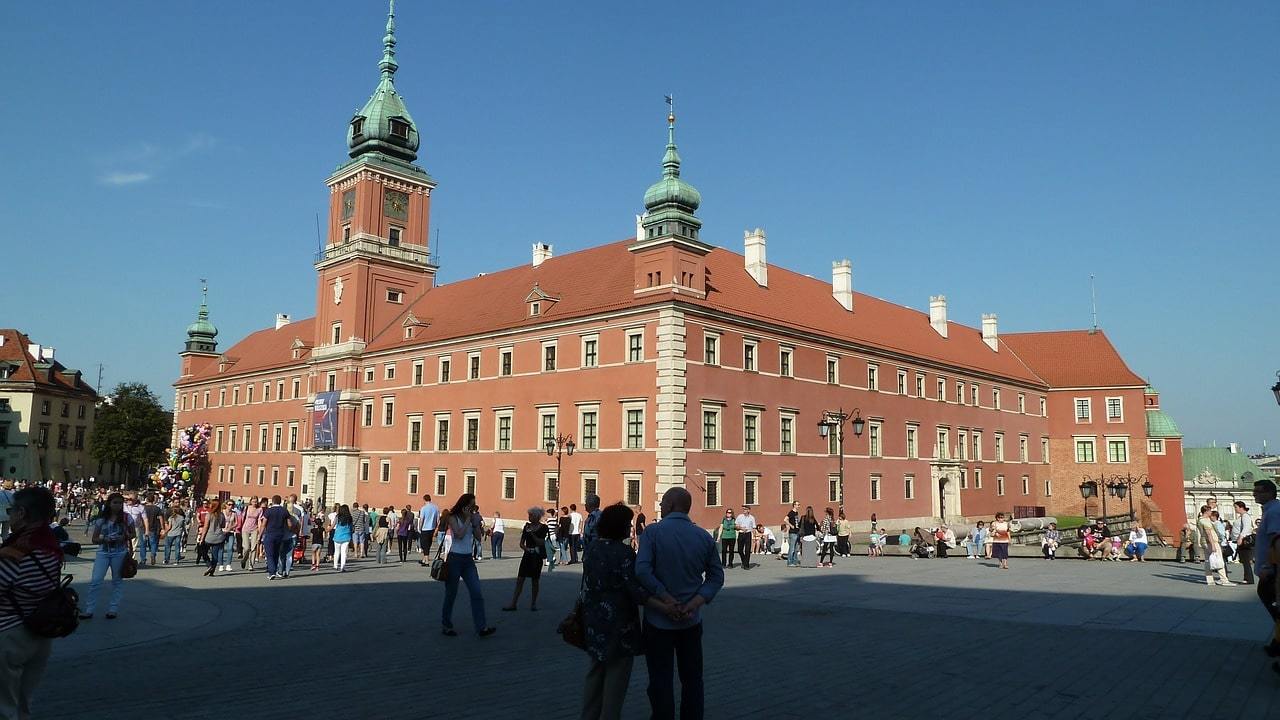
- The residence of Polish royalty between the 16th and 18th centuries
- One of the most important landmarks in Warsaw
- The Royal Route begins here
Why it’s awesome: Like the majority of the Old Town, Warsaw’s Royal Castle was destroyed during the Second World War II. Due to the Communist Regime, this wasn’t rebuilt with the rest of the Old Town though – it had to wait until the 1980s. Since then it has been a museum which houses portraits of Polish Royalty. After all, it was their residence for a couple of hundred years! Castle Square is a great place to get some pictures of the castle and take in some sun. It’s also the beginning of the Royal Route!
What to do there: It’s definitely worth spending a couple of hours in the castle, to find out more about this Warsaw must-see. After you’ve finished, it might be an idea to make a start on the Royal Route. This runs 15km from Castle Square to the south, where you’ll find Wilanów Palace. On the way, you’ll be able to stop off at some of the best places to visit in Warsaw, including ?azienki Park and a number of palaces, churches, and academic institutions!
#3 – Warsaw Uprising Museum – Possibly one of the most important places to visit in Warsaw
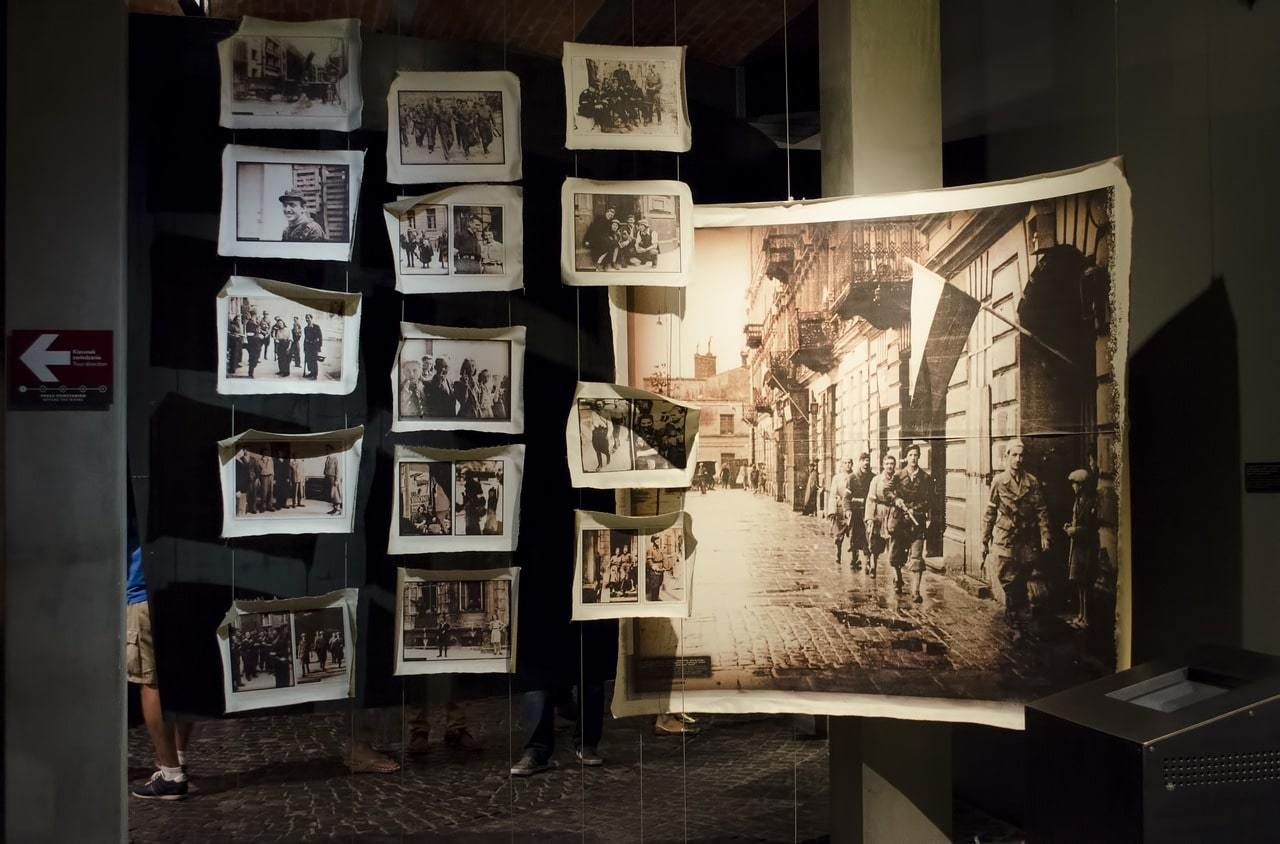
- Use pre-war telephones to listen to memories of those involved in the Uprising
- Watch footage of the Uprising in the museum’s cinema
- An extremely important event in the ending of World War II
Why it’s awesome: One of the most important historical points of interest in Warsaw, this fascinating museum documents the 1944 Warsaw Uprising, a key event in the closing stages of World War II. Rather than being just lots of exhibits with texts, there’s a range of multimedia used to make the story of the Uprising come alive. It’s actually modelled on the Holocaust Memorial Museum in Washington DC.
What to do there: If you want to learn more about the Warsaw Uprising, there’s no better place to do it than here. Read newspapers printed at the time of the event or even check out the bunkers where people hid. There are also opportunities to listen to actual messages recorded by insurgents on old telephone receivers or watch footage from the event at the Kino Palladium cinema installation. Just make sure that you don’t plan to travel to Warsaw’s Uprising Museum on a Tuesday. It’s closed!
#4 – Palace of Culture and Science
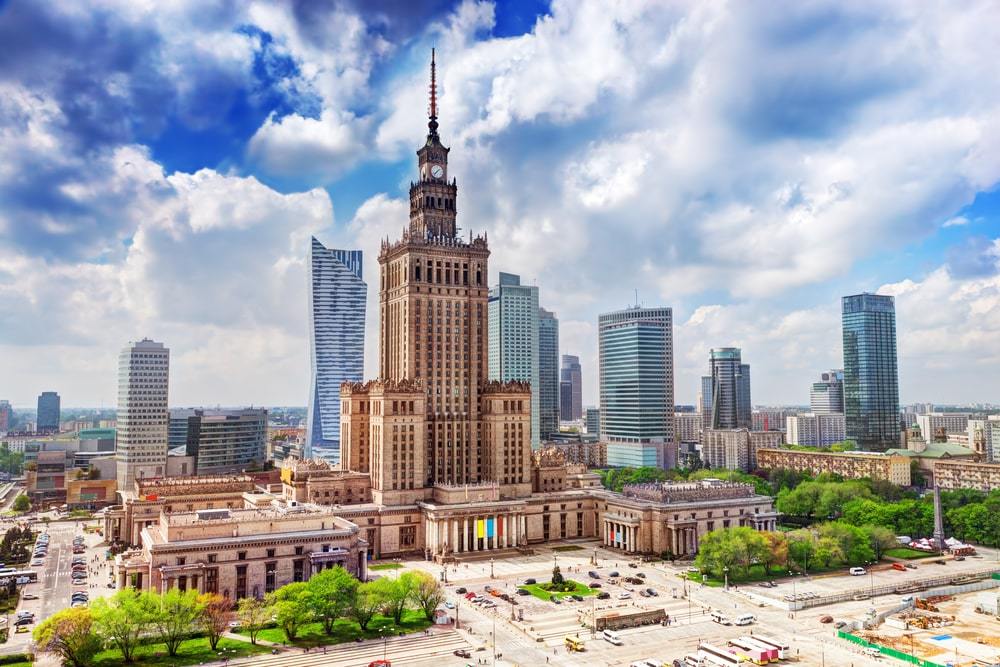
- The tallest building in Poland
- One of the most recognisable landmarks in Warsaw
- One of the best places in Warsaw to get panoramic photos
Why it’s awesome: This striking building splits opinion in the way only Marmite can, and you can see it from pretty much anywhere in Warsaw. At 237 metres, it’s the tallest building in Poland and across its 42 floors, you’ll find four theatres, two museums, and a multi-screen cinema. And those are just the parts you can actually go in! There are also government offices and private companies based in the building. There’s enough space, trust us! A lot of Poles dislike this building. Not for how it looks, but because it was a ‘gift’ from the Soviet Union in 1955.
What to do there: Whatever your feeling on Stalinist architecture, you can’t deny that this building is imposing and striking. There are plenty of cultural activities that we’ve mentioned above, and going to the theatre, museum, or cinema is definitely an option while you’re here. However, there’s one Warsaw must do in this enormous building. And that’s heading to the observation deck. You’ll be able to get jaw-dropping views and photos from the 30th floor!
#5 – Lazienki Park – A beautiful outdoor place to visit in Warsaw
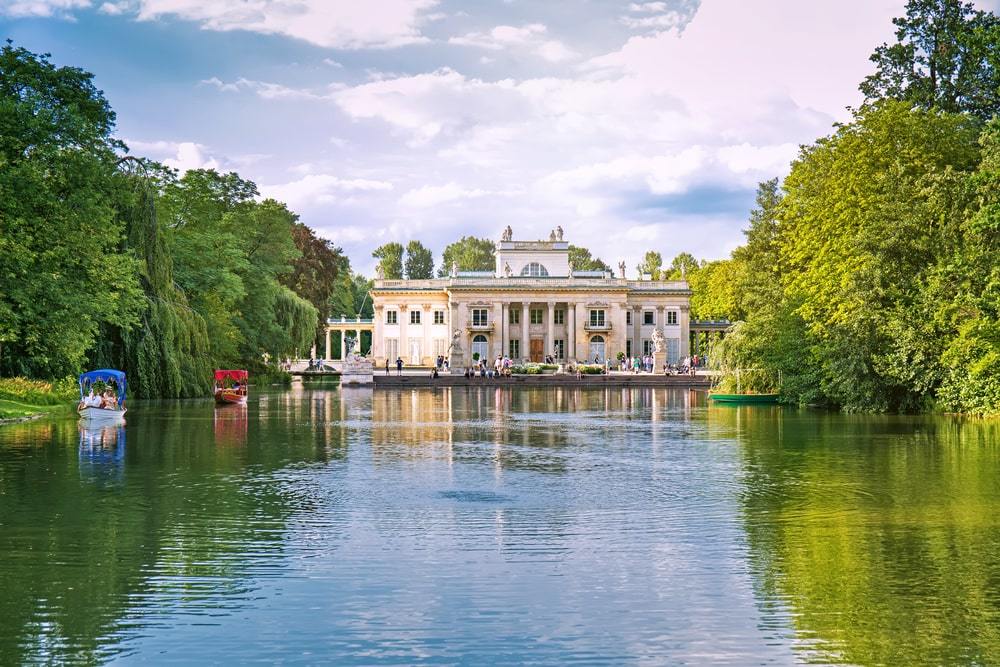
- The largest park in Warsaw and a key part of the Royal Route
- Loved by local families and tourists alike
- Don’t miss the beautiful palace on an artificial island in the middle of a lake
Why it’s awesome: Ask any Warsaw local where they’d go on a sunny day in the city and the chances are their response will be Lazienki Park. So, you may as well follow their advice! This leafy park is the largest one in the Polish capital and covers over 76 hectares. The paths which criss-cross the park lead to museums, palaces, pavilions, and even a planetarium among many other cool places. This is one of the best places in Warsaw to relax and enjoy an entire day in nature. Without leaving the city!
What to do there: Strolling through this ideal park is what to do in Warsaw whether you’re travelling solo, with friends, or on a romantic break. Check out one of the four museums in the park, or head to the Lazienki Palace. The classical Palace sits on an artificial island in the middle of a lake, but you can enter to see the lavishly decorated rooms and galleries. In summer, there are often concerts in the park. Just look for the Frederic Chopin statue!
#6 – Tomb of the Unknown Soldier
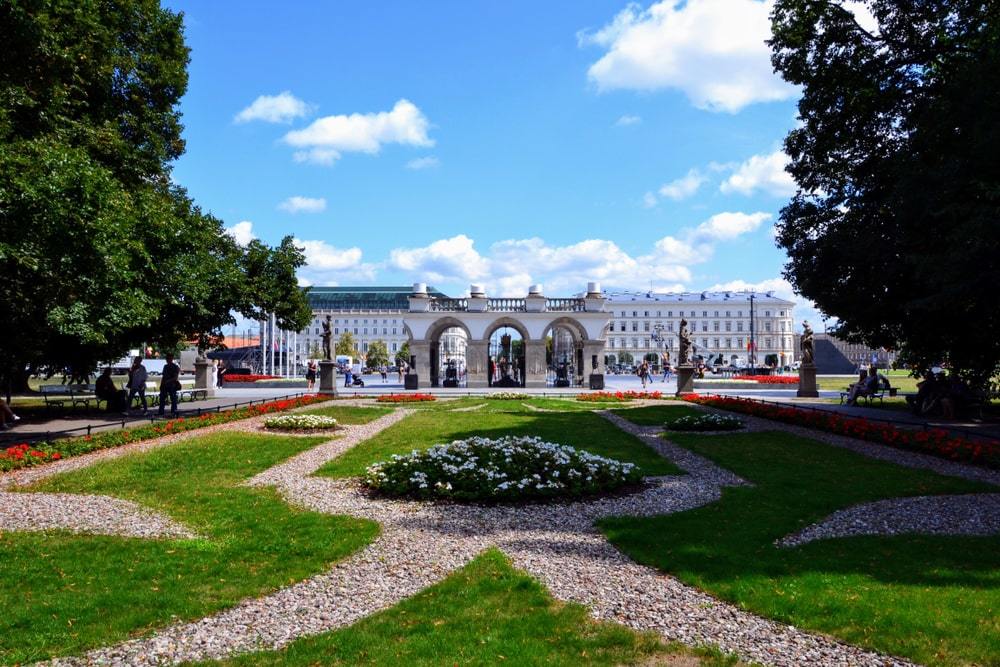
- A monument to the unidentified soldiers who have passed away in battle
- Watch the changing of the guard on the hour every hour
- See the eternal flame – it’s one of the most poignant landmarks in Warsaw
Why it’s awesome: The Saxon Palace was destroyed in the Warsaw Uprising of 1944, but part of it still survives here. Yes, that’s where the 3 arches of the Tomb of the Unknown Soldier are from. This isn’t a monument to just one soldier, but rather all those who have died fighting for Poland. You can find this small and moving monument in Pi?sudski Square. This is a Warsaw must-see if you’re interested in military history , or you want to spend some time in a quiet and peaceful spot.
What to do there: Try and be at the memorial on the hour. It doesn’t matter which hour, as the guard is changed 365 days a year on the hour every hour. No exceptions – not even on Christmas Day! A great time to visit this memorial is on the 15th of August. This square, and the monument, in particular, are the centrepiece of the remembrance ceremonies for Polish Armed Forces Day. The Eternal Flame burning under the arches is a poignant memorial to those who have passed away fighting for their country.

A new country, a new contract, a new piece of plastic – booooring. Instead, buy an eSIM!
An eSIM works just like an app: you buy it, you download it, and BOOM! You’re connected the minute you land. It’s that easy.
Is your phone eSIM ready? Read about how e-Sims work or click below to see one of the top eSIM providers on the market and ditch the plastic .
#7 – Copernicus Science Centre
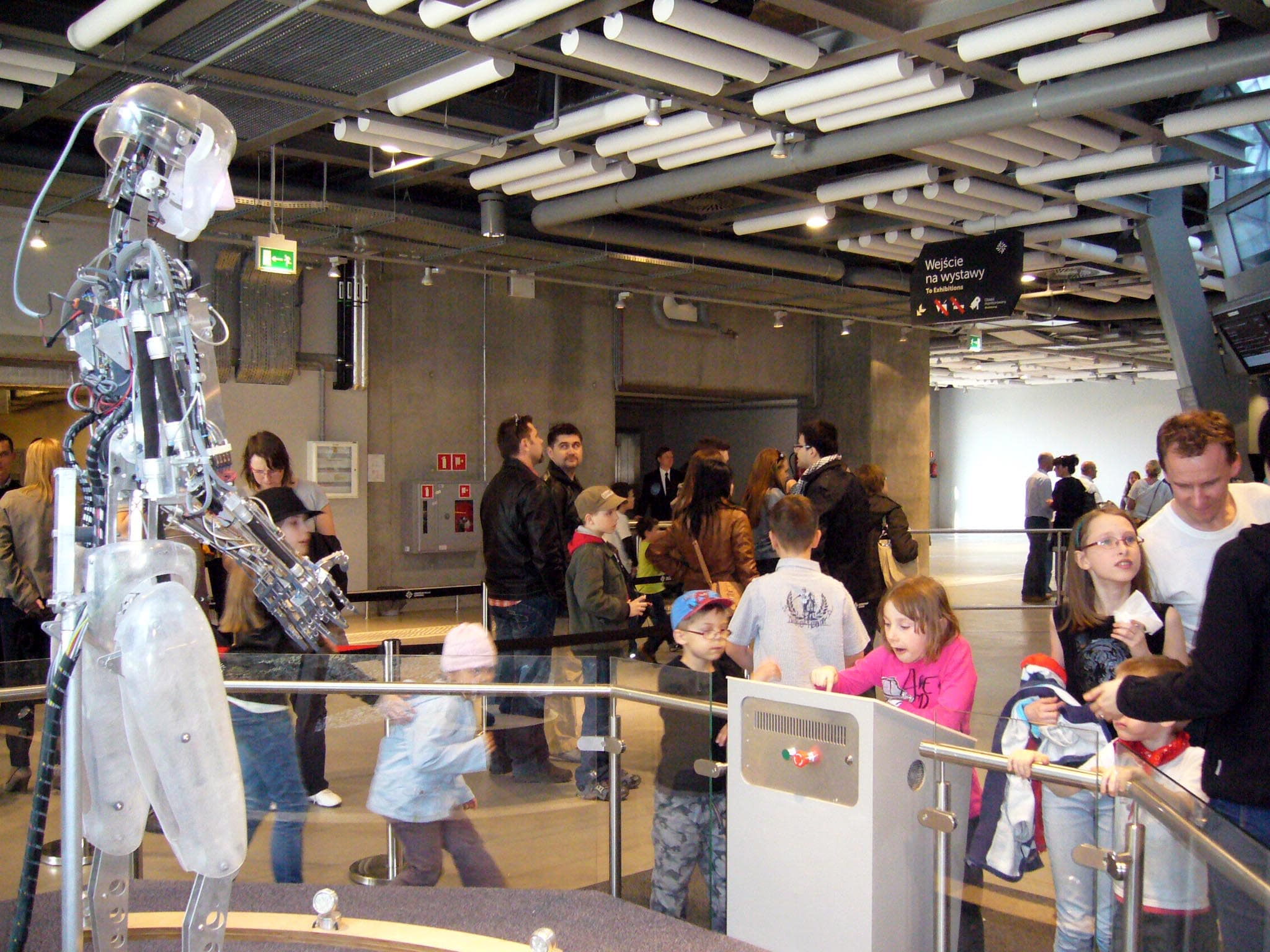
- More than 400 interactive exhibits across 6 zones
- One of the newest and most modern attractions in Warsaw
- Experience the tremors of the museum’s earthquake simulator!
Why it’s awesome: Even if you’re not interested in science in the slightest, Copernicus Science Centre should definitely make it onto your Warsaw itinerary. This might just be not only one of the best learning hotspots in Warsaw but the whole of Europe! Opened in 2010, there are more than 400 interactive exhibits at this museum. They’re spread across six zones, so whether you’re interested in animals, humans and the environment, even natural disaster, you’ll surely find something to pique your interest here.
What to do there: For adrenaline seekers, this museum proves you don’t have to go bungee jumping or sky diving. No, here you can enjoy (maybe that’s not the right word) the feeling of being caught up in an earthquake! If biology is more your thing, check out the installation of a human skeleton riding a bicycle. It’s quite cool seeing how all those bones and joints work! And, if something more relaxing is right up your street, settle back into one of the comfy chairs in the planetarium. Not only are there shows about the universe, but humans and nature too, all accompanied by a fantastic surround sound system. This is a must-visit when you explore Warsaw!
#8 – POLIN – Museum of the History of Polish Jews – A fascinating educational place to visit in Warsaw
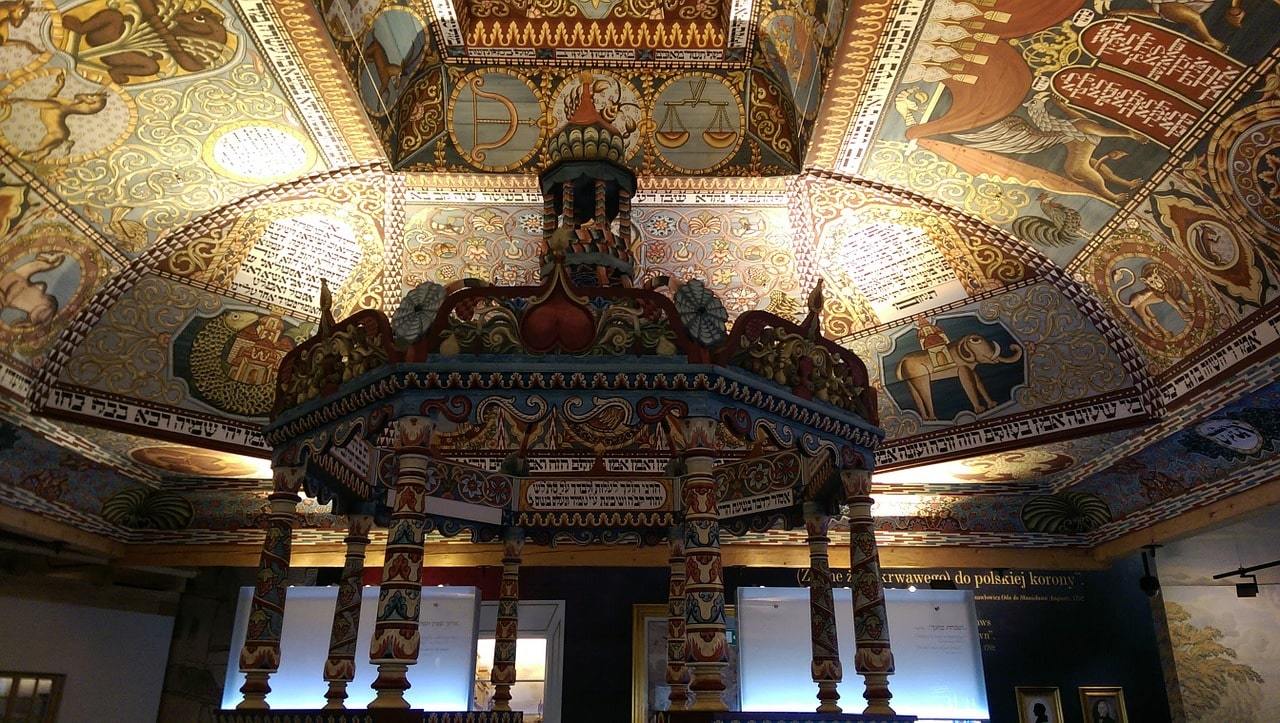
- Learn about the 1,000-year history of Jews in Poland
- Located in the heart of the former ghetto in Muranów
- One of the best places in Warsaw to feel moved and educated at the same time
Why it’s awesome: POLIN opened in 2014 after being in the making for seven years, making it even newer than the Copernicus Science Centre. Poland has long been home to Europe’s largest Jewish community, and this museum commemorates the highs and lows of this history across eight galleries. Obviously, it’s unavoidable visiting this museum without taking the Holocaust into account. Although it was undeniably a terrible event, there are stories about heroes and people saved from such a dreadful fate in the Warsaw ghetto.
What to do there: There are plenty of interesting exhibits to view at POLIN. Although we’ve mentioned the sobering and chilling Holocaust display, there are some genuinely uplifting and enjoyable parts to the museum too. There’s a prayer book that dates all the way back to 1272, a fascinating and intriguing artefact. There’s also an entire exhibit dedicated to the 16th and 17th centuries – known as the golden age of religious tolerance! Whatever you take from the POLIN museum, it’s an unmissable point of interest in Warsaw. A guided tour is a great way to see it if you’re unsure where to start
#9 – Chopin Museum
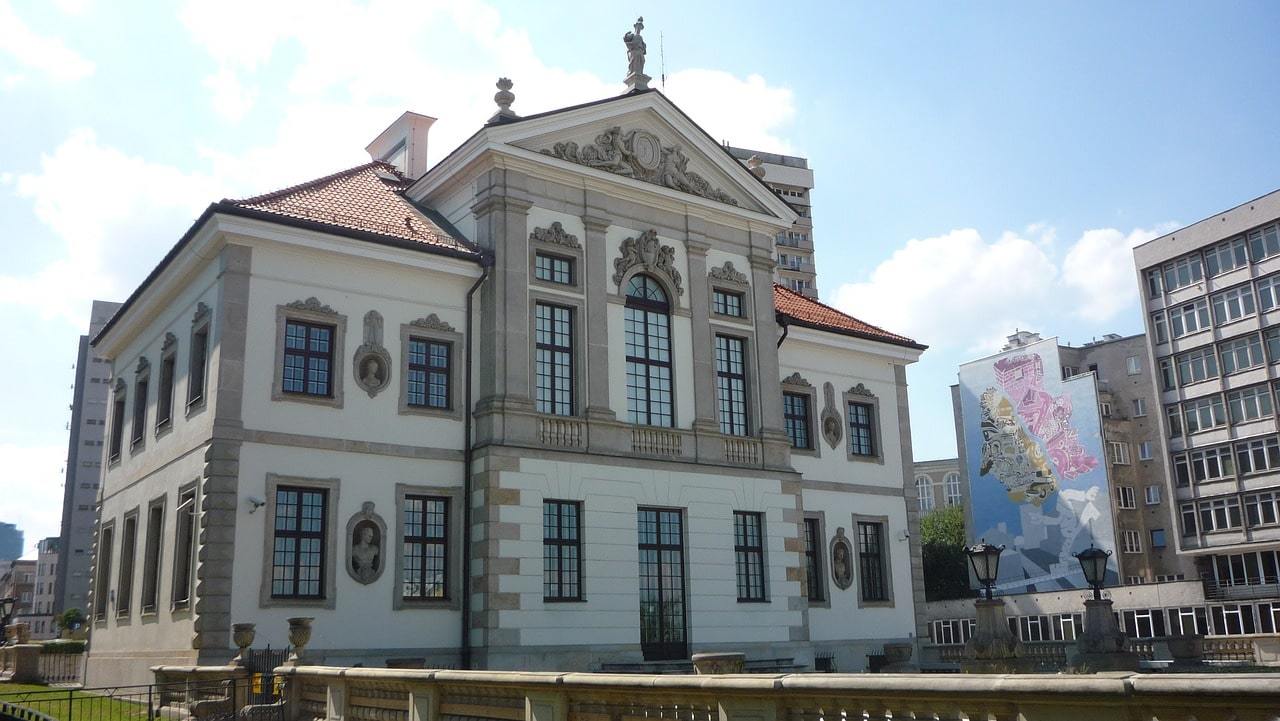
- Learn about one of Warsaw (and Poland’s) most famous historic figures
- Find curious exhibits dedicated to Chopin all across the city
- Great Warsaw vacation ideas for music lovers
Why it’s awesome: The museum refers to Chopin as a 19th-century answer to Sir Elton John. While we’re not sure we’d describe him in that way, learning more about one of the city’s most famous historical figures is a Warsaw must do. The museum of Chopin’s life is housed in a 17th-century palace but it’s packed with cool interactive exhibits that will keep even the surliest teenagers intrigued. You’ll learn more about the composer’s life. For example, did you know that he actually came from a farm estate in the east of the city, before going on to becoming respected and revered in Paris?!
What to do there: The museum is a great place to learn about the life of Frederic Chopin. However, it’s not the only place that you’ll feel his presence. While you’re visiting Warsaw, keep an eye out for the Chopin benches too. These special benches are dotted around the city and play the great composer’s music as you sit on them! There’s also a monument to Chopin in ?azienki Park that becomes a concert venue in the summer, while churches often host evening performances of the composer’s music. Warsaw is a great place to be if you love classical music!
#10 – Keret House – An unknown (but awesome) place to see in Warsaw!
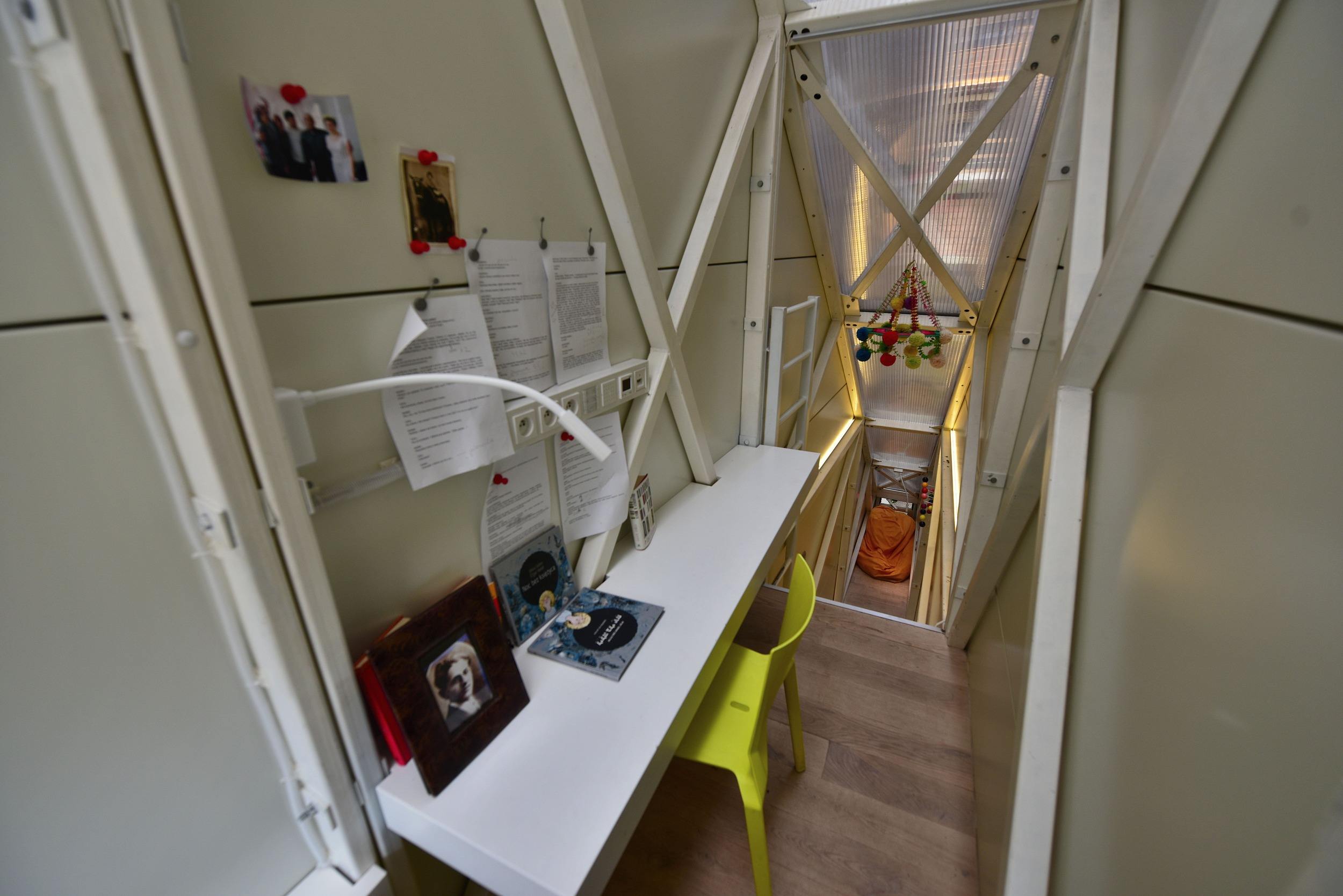
- The narrowest house in the world
- One of the more unusual things to do in Warsaw
- Open to all who visit Warsaw
Why it’s awesome: There are some pretty cool museums and royal attractions in Warsaw, but sometimes you just want something a bit quirky and unusual. Okay then, let us present to you the Keret House! It may be over 30 foot tall, but at its widest, it’s not more than 4 feet wide. In fact, at its narrowest point, it’s just over 2! The house is too narrow to be classed as a house as it doesn’t mean minimum requirements, so instead, it’s an art exhibition.
What to do there: Although people have lived in this house in the past, it’s not a private residence anymore. Nowadays, it’s open to visitors, although you might bump into each other on the ladders that connect the floors! If you’re a travel writer, you’re able to book a night’s stay in the house. This could be a great opportunity to have an authentic, off the beaten track experience. It’s certainly one of the most unusual things to do in Warsaw!
Get insured for your trip to Warsaw!
ALWAYS sort out your backpacker insurance before your trip. There’s plenty to choose from in that department, but a good place to start is Safety Wing .
They offer month-to-month payments, no lock-in contracts, and require absolutely no itineraries: that’s the exact kind of insurance long-term travellers and digital nomads need.

SafetyWing is cheap, easy, and admin-free: just sign up lickety-split so you can get back to it!
Click the button below to learn more about SafetyWing’s setup or read our insider review for the full tasty scoop.
Find out what people want to know about the best places to visit in Warsaw
What should I not miss in Warsaw?
A visit to the Warsaw Royal Castle is one of the most important and beautiful historical sites in the city and can’t be missed.
What are some fun places to visit in Warsaw?
Call by the quirky ‘Keret House’, the worlds narrowest house! Why? Well, why the hell not!?
What are the best free things to do in Warsaw?
Wandering the fairytale streets of the Old Town (Stare Miasto) is a great way to immerse yourself in the city and it’s totally free.
What are the best things to do in Warsaw in winter?
Head indoors and learn about the 1000 year history and stories of the Jewish citizens of the country at the Museum of the History of Polish Jews.
Final Thoughts
So, that’s all from us on our list of the best places to visit in Warsaw. Hopefully, you’ll see from our extensive list that this is a dynamic and diverse city with plenty to do! And, you’ll have an idea of the best places to stay in Warsaw too.
Whatever you want from a city break, you’ll find it when you travel to Warsaw. The museums and galleries are some of the best in Poland, showing the history of this fascinating country. The restaurants offer a mix of international food and local delicacies, and the nightlife scene can compete with any European capital!
Hopefully, our list of the best places to visit in Warsaw will have not only showed you the city’s best attractions but also given you a bit of an idea of how the locals live. With everything in mind from our list, all that’s left is for us to wish you an amazing vacation when you’re visiting Warsaw!

And for transparency’s sake, please know that some of the links in our content are affiliate links . That means that if you book your accommodation, buy your gear, or sort your insurance through our link, we earn a small commission (at no extra cost to you). That said, we only link to the gear we trust and never recommend services we don’t believe are up to scratch. Again, thank you!
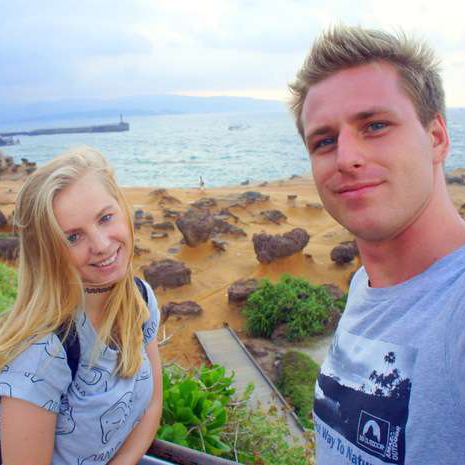
Agness and Cez
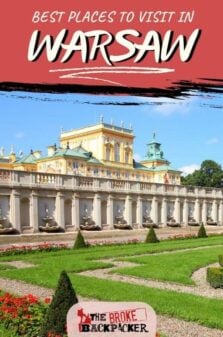
Share or save this post

Leave a Reply Cancel reply
Your email address will not be published. Required fields are marked *
Save my name, email, and website in this browser for the next time I comment.
Notify me of followup comments via e-mail.

19 Top Things to do in Warsaw: Museums, History and Travel Guide
December 30, 2023 | Posted in: Poland
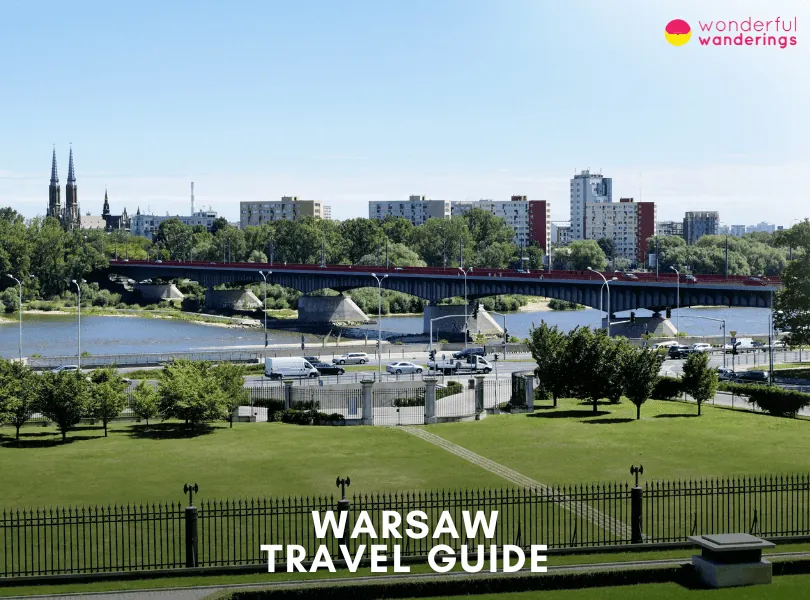
Warsaw is the capital and largest city of Poland. It is located in east-central Poland, 300 kilometers (186 miles) from the Baltic Sea coast and 260 kilometers (161 miles) from the Carpathian Mountains. Warsaw lies on the Vistula River, roughly halfway between Berlin, Germany and Moscow, Russia. Warsaw is the country's important political, economic and cultural center, with a total population of 1,747,155 as of 2023.
Warsaw originated as a small 13th-century fishing village but grew to prominence when it became the capital of the Duchy of Masovia in 1413. It then developed into the de facto capital of the Polish-Lithuanian Commonwealth in the 1600s, becoming a center of culture and the arts under the patronage of its kings. Warsaw endured many hardships over the centuries, including foreign invasions, plagues, fires and crackdowns on independence movements when it was partitioned and occupied by Prussia and Russia in the 18th and 19th centuries. Over 85% of Warsaw was completely razed by the Nazis after the Warsaw Uprising in 1944. Varsovians rebuilt the city from rubble after World War II. Warsaw has undergone an economic rebirth, becoming a thriving center of business, finance and technology in Central Europe today while preserving its long, culturally rich history.
Warsaw features top attractions such as the Old Town, which allows visitors to explore reconstructed medieval architecture and landmarks like the Market Square and the Museum of Warsaw. The Royal Route links streets, palaces, churches, parks and more that Polish kings once traveled. Łazienki Park features 75 hectares of palace grounds and gardens, with sights like the Chopin statue. The Warsaw Rising Museum's immersive exhibits commemorate the 1944 uprising against Nazi occupation. The Copernicus Science Centre delights visitors with 400+ interactive scientific experiments. The National Museum houses Poland's most extensive art collection spanning centuries, leading Polish artists across mediums and other top attractions only this city offers. Warsaw lies in the Central European Time zone (UTC+1). It observes Central European Summer Time with daylight saving time from late March through October, shifting clocks 1 hour forward to UTC+2.
Listed below are the things to do in Warsaw.
- Warsaw Old Town. The Warsaw Old Town is in the city center district of Warsaw, Poland. It has a history dating back to the 13th century when the area grew around the castle of the Dukes of Mazovia. Key landmarks include the Market Square with the iconic Mermaid statue, St. John's Cathedral, the city walls and defense fortifications and the Museum of Warsaw, presenting the city's 1000-year history. The area was severely damaged in World War II but meticulously rebuilt to restore its historic architecture and role as the city's heart. Visitors can explore sites like the Royal Castle, wander picturesque alleys, visit museums and dine at outdoor cafes and restaurants while soaking in the medieval atmosphere.
- Royal Route in Warsaw. The Royal Route is a historical pathway spanning major streets to connect landmarks across central Warsaw. It begins at the Royal Castle in the Old Town and ends at Wilanów Palace to the south, lined with elegant residences, churches, palaces, squares and sites associated with Polish royalty. Key areas include Krakowskie Przedmieście and Nowy Świat streets, home to sights like the Presidential Palace, Warsaw University and numerous churches. Visitors can admire the preserved Renaissance, Baroque and Neoclassical architecture along the route, do upscale shopping and dining and access green spaces like Saxon Garden and Łazienki Park.
- Łazienki Park. Łazienki Park is a 76-hectare park located in downtown Warsaw, originally built as a baths park for nobleman Stanisław Lubomirski in the 17th century. Its main landmark is the Palace on the Isle residence of King Stanisław August Poniatowski, set amidst gardens, lakes and peacock sanctuaries. Other architectural gems include the Myślewicki Palace, White House, Old Orangery Theater and statues like the Chopin Monument. Visitors can tour the lavish royal residences, stroll through different styled gardens from the 18th century, attend Chopin recitals and theater performances, rent boats and observe wildlife like roaming peacocks.
- Old Town Market Place. The Old Town Market Place is a reconstructed central square located in Warsaw's Old Town, lined with colorful Baroque and Renaissance-style townhouses. Landmarks include the bronze Warsaw Mermaid statue, St. Kazimierz Church and a memorial to Warsaw Uprising heroes. Visitors can shop, dine at cafes and restaurants around the perimeter, explore sights like St. Kazimierz Church, take photos of the Mermaid statue and experience events like summer concerts and crafts markets. It offers a glimpse into Warsaw’s history before the extensive destruction of WWII.
- POLIN Museum of the History of Polish Jews. The POLIN Museum presents the 1000-year history of Polish Jews before the Holocaust through a 4000 sq meter interactive exhibition. Set on the former Warsaw Ghetto site, key displays include films, objects like religious items and folk costumes, oral histories and an enormous replica 17th-century painted synagogue roof illustrating the diversity of Polish Jewish culture largely destroyed in WWII. Visitors can journey through galleries exploring the community’s early days, Golden Age, interwar years, tragedy in the Holocaust and Jewish revival today.
- Warsaw Uprising Museum. This modern multimedia museum commemorates the 1944 Warsaw Uprising against Nazi occupation during WWII. Its key features include a replica bomber aircraft, sewer passageways, insurgent artifacts and weapons, survivor testimonies, timelines and photographs documenting the 63-day struggle when Polish resistance forces unsuccessfully tried to liberate Warsaw, leading to the city's destruction. The museum offers an immersive experience conveying the desperate realities for resistance fighters and civilians during this seminal period in Warsaw’s history.
- Wilanów Palace. Wilanów Palace dates back to 1677 as a grand royal summer residence built for King John III Sobieski and styled after the Palace of Versailles. The Baroque architecture and lavish interiors contain priceless furnishings, paintings and other art spanning civilizations from ancient Rome to 17th-century China and Japan. The grounds are home to scenic gardens, fountains and greenery. Highlights include the preserved baroque royal apartments, temporary exhibits, opportunities for garden strolls and summer cultural events and concerts.
- Copernicus Science Centre. This modern, interactive science museum features over 400 hands-on exhibits spread across galleries with physics, light, environmental science and civilization themes based on experimentation and discovery rather than passive observation. Facilities include a planetarium, theaters, gardens and varied labs and workshops. Visitors pilot spaceships, race robots, build structures, paint with light, see physics phenomena in their bodies and engage with all aspects of science first-hand in an open “Experimental Zone” through games and challenges suited for all ages and interests.
1. Warsaw Old Town (Stare Miasto)
Warsaw Old Town (Polish. Stare Miasto Warszawskie), also known as Old Town Warsaw, is at Plac Zamkowy 4, 00-277 Warsaw, Poland. It is within Warsaw's Śródmieście (City Center) district, surrounded by the Vistula River. Warsaw Old Town has a long and tumultuous history. The settlement dates back to the 13th and 14th centuries when it was fortified with brick city walls. It grew up around the castle of the Dukes of Mazovia, which later became the Royal Castle. The Market Square (Rynek Starego Miasta) was laid out by the end of the 13th century. During World War II, the Old Town was severely damaged by Nazi German bombings and demolitions, which targeted Warsaw's historic areas. The reconstruction project was recognized as an outstanding example of rebuilding a historic city core, leading to Warsaw Old Town's inscription as a UNESCO World Heritage Site in 1980.
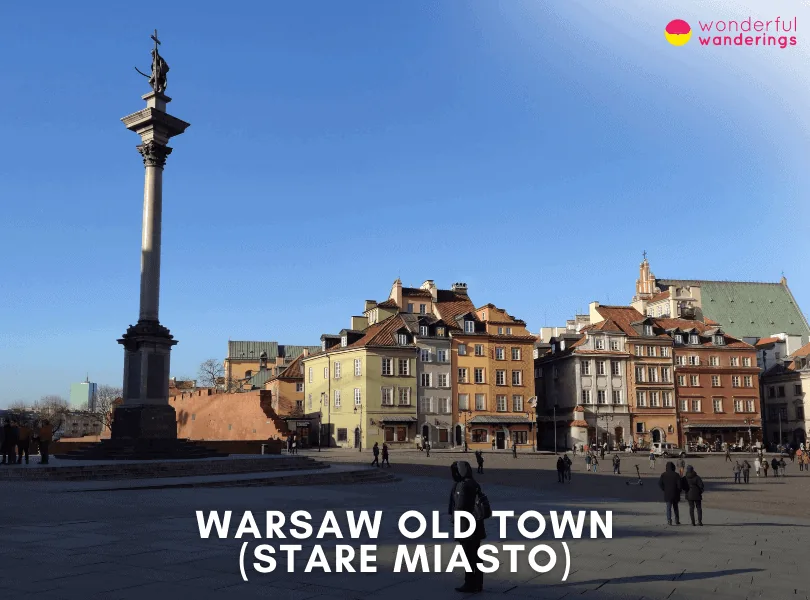
Warsaw Old Town contains many historic buildings and landmarks showcasing Renaissance, Baroque and Gothic architecture. Key sites include the Royal Castle, St. John's Cathedral, the city walls and defense fortifications like the Barbican, the narrowest house in Warsaw on Kanonia Street and the iconic Mermaid statue in the Old Town Market Square. Visitors can explore the Old Town Market Square and Castle Square and meander through atmospheric alleys and medieval basements. The Old Town is also home to the Museum of Warsaw, which presents the city's 1000-year history. Warsaw Old Town offers activities for all visitors. Families can take kids to the colorful townhouses, visit the whimsical Mermaid statue and walk along the medieval city walls. History buffs can tour sites like the Royal Castle, learn about Polish royalty and politicians buried in St. John's Cathedral and see Warsaw's oldest monuments. Foodies will enjoy the many cafes and restaurants with outdoor dining in summer. Photographers have endless opportunities to capture Warsaw's iconic sites. The district also hosts cultural festivals, winter Christmas markets and summer nightlife.
Visitors can take the S2 or S3 train directly to Warsaw Śródmieście station. The Warsaw Centralna is linked by tram and bus to the Old Town. The Old Town can be accessed on foot within Warsaw from hotels or attractions in the City Center district. Entry to Warsaw Old Town is free, requiring no admission tickets.
2. Royal Route in Warsaw
The Royal Route (Trakt Królewski) is in Warsaw, Poland's capital and largest city. It spans several major streets and connects the Old Town with the southern districts, passing various historic landmarks along an 11 kilometers (6 miles) route. The Royal Route has a long history dating back to the 16th century, when Warsaw became the capital under the Polish King Sigismund III Vasa. It began as a communication route linking the Royal Castle in Old Town to the king's Wilanów Palace residence further south. Aristocrats and wealthy citizens built magnificent homes, palaces, churches and squares along this prestigious route. Warsaw's golden age in the 17th and 18th centuries was when Polish kings and nobles would travel along the Royal Route during coronation processions or on other ceremonial occasions.
The central section of Warsaw's Royal Route runs along Krakowskie Przedmieście and Nowy Świat streets in the borough of Śródmieście. Key sites include St. Anne's Church, Presidential Palace, Warsaw University and churches like St. Joseph's and the Holy Cross Church, where the heart of composer Frederic Chopin is sealed inside a pillar. The route connects Old Town's Castle Square to Three Crosses Square, Łazienki Park and Wilanów Palace grounds.
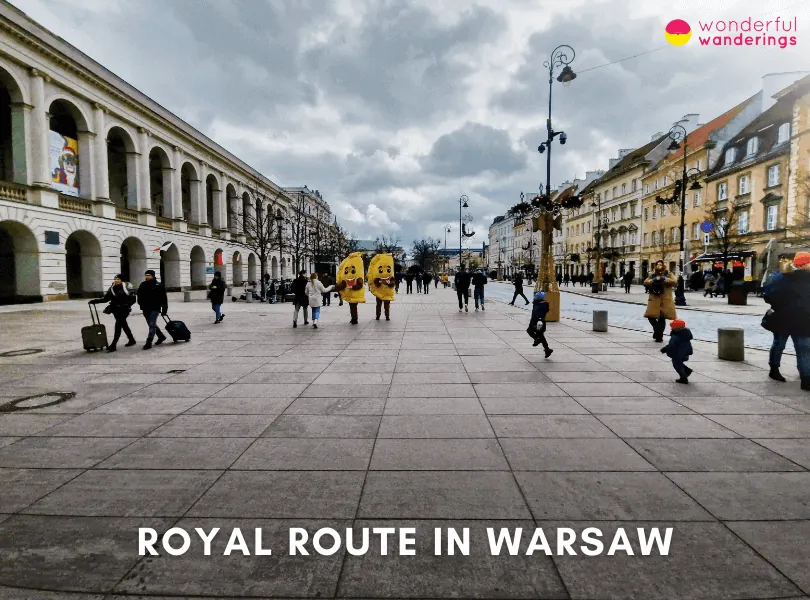
The Royal Route offers much for tourists to see and do. Visitors can admire the elegant Renaissance, Baroque and Neoclassical architecture along the route. History and architecture buffs will especially appreciate sites like the Royal Castle, St. John's Cathedral, historic townhouses and the University of Warsaw library. Many museums, galleries, cultural institutions, shops, cafes and restaurants are also dotted along the route. People strolling along the pedestrian sections can do upscale shopping or souvenir hunting on streets like Nowy Świat. The route also connects green spaces like Saxon Garden and Łazienki Park, allowing visitors to take scenic strolls past palaces and gardens. Free Chopin concerts are performed at Łazienki Park on Sundays from May to September. Those traveling with kids can visit the Copernicus Science Centre and enjoy the interactive exhibits.
The Royal Route is very accessible via public transportation. The central train station Warsaw Centralna offers trams and buses to Śródmieście district. Many buses run along the Royal Route, while the nearest metro stations are Centrum and Świętokrzyska. Visitors can also take taxis or walk from hotels situated along the route. Entry to the Royal Route streets is completely free. Visitors only need to pay admission fees for certain attractions like the Royal Castle Museum, Copernicus Science Centre or Wilanów Palace. Combo tickets are available for discounted entry to multiple sites. Guided walking tours along the Royal Route are also available.
3. Łazienki Park
Łazienki Park, known as Royal Baths Park, is in Warsaw, Poland's capital and largest city, at Ul. Agrykoli 1, 00-460 Warsaw. It lies in Warsaw's central Śródmieście (City Center) district, on Ujazdów Avenue, which links the Old Town with Wilanów to the south. Łazienki has a long history dating back to the 17th century when it was built as a bath park for nobleman Stanisław Herakliusz Lubomirski. In the 18th century, it was transformed by Poland's last monarch, King Stanisław August Poniatowski, into a setting for palaces, villas, pavilions, temples and monuments. Its 76 hectares contain a palace, amphitheatre, gardens, water features and peacock sanctuary. Key sites include the Palace on the Isle, Myślewicki Palace, the White House, the Old Orangery Theater and statues like the Chopin Monument.
Visitors can explore the regal Palace on the Isle, King Stanisław August Poniatowski’s home, see peacocks roaming freely and experience venues for arts and culture. The park is also home to the Botanic Garden and the Museum of Scouting. Visitors can tour historic palaces and museums like the Palace on the Isle, admire monumental sculptures by prominent artists and wander through different garden styles from the 18th century. The park offers lively spaces like the Old Orangery Gallery and quiet retreats within secluded garden nooks or the king’s former hermitage residence. The activities at Łazienki Park cater to all visitors, families, couples, culture aficionados, photography enthusiasts and nature lovers. The peacocks, row boats and Chopin recitals especially appeal to kids. The palace museums, art galleries and summer theater performances draw cultured crowds. The preserved historic interiors give architectural fans a glimpse into 18th-century royal life. The park’s scenic natural beauty makes it popular for wedding photo shoots.
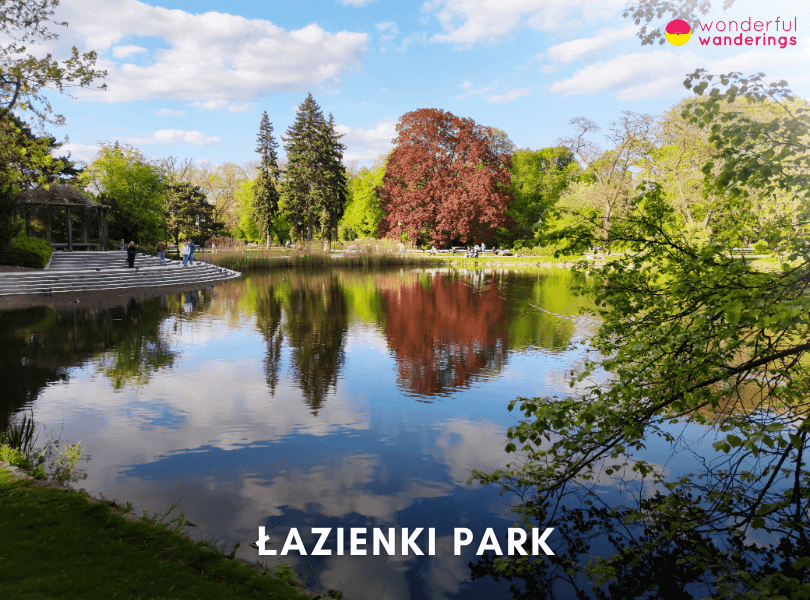
Łazienki Park is easily accessible by public transport or taxis from Warsaw city center. Visitors can take the S2 or S3 train directly to Warsaw Śródmieście station. The central train station Warsaw Centralna also offers buses and trams to Łazienki Park. The nearest bus stop within the park is Łazienki Królewskie. Visitors can also reach by foot or bike from nearby attractions like Wilanów Palace (30 mins) or the Old Town (50 mins). Entry to Łazienki Park is free, with no admission tickets required.
4. Old Town Market Place
The Old Town Market Place (Polish. Rynek Starego Miasta) is located in the heart of Warsaw's Old Town, in the Śródmieście (City Center) district of Warsaw, Poland. The full address is Plac Rynek Starego Miasta 2, 00-272 Warsaw. The Old Town Market Place has a long history dating back to the 13th century, when Warsaw was first founded. It originated as a central square where guilds would meet, merchants would trade and public events would be held. Immediately after World War II, it was systematically destroyed by the Nazis as retaliation after the Warsaw Uprising. After the war, the Old Town Market Place was meticulously rebuilt to recreate its former glory. It is one of Warsaw's top tourist attractions.
Old Town Market Place has historic significance as the heart of Old Warsaw. The square is lined with colorful reconstructed townhouses exemplifying Baroque, Renaissance and Gothic architecture. Key landmarks include the bronze Warsaw Mermaid statue in the center, St. Kazimierz Church and the monument to the Warsaw Uprising heroes. Visitors can explore historic sights, dine al fresco, people-watch or soak in street performances and events at the square. Visitors can tour St. Kazimierz Church, admire the architecture of the reconstructed townhouses, take photos of the iconic Warsaw Mermaid statue, wander around the square, shop for souvenirs, dine at one of the restaurants around the square or simply sit and people-watch. The square hosts lively cultural events on summer weekends, like concerts and historical reenactments. The activities at the Old Town Market Place cater to all visitors. families, couples, historians, architecture enthusiasts, photographers, etc. Kids especially enjoy seeing the colorful buildings, wandering around the square and spotting the mermaid statue. Historians appreciate sites like the Warsaw Uprising Museum located just off the square. Foodies flock to the restaurants and cafes lining the square. The lively atmosphere draws tourists and locals alike.
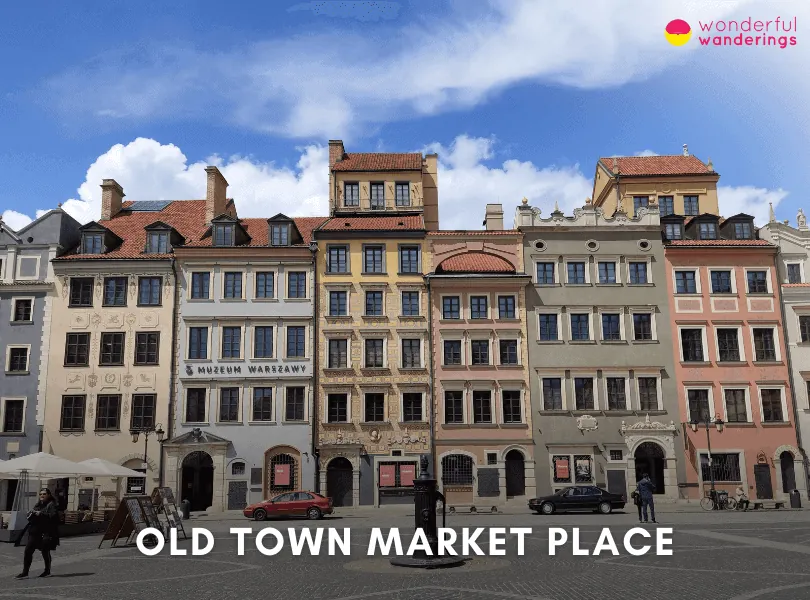
The Old Town is located in Warsaw's City Center and is easily accessible via public transport, taxi or walking. Visitors can take the S2 or S3 train directly to Warsaw Śródmieście station to the Old Town Market Place. The central train station, Warsaw Centralna, also offers buses, trams and metro trains to the Old Town area. Many buses and trams run along the nearby Krakowskie Przedmieście street. The Old Town area is also very walkable from hotels and attractions in central Warsaw districts like Śródmieście. Entry to the Old Town Market Place is free, with no admission tickets required. Visitors only need to pay for dining at the restaurants/cafés around the square or optional attractions like the Warsaw Uprising Museum.
5. POLIN Museum of the History of Polish Jews
The POLIN Museum of the History of Polish Jews (Polish. Muzeum Historii Żydów Polskich) is located in the Muranów district of Warsaw, Poland, at 6 Anielewicza Street, 00-157 Warsaw.
The museum has a deeply symbolic location, situated on the site of the former Warsaw Ghetto, where hundreds of thousands of Polish Jews tragically perished during the Holocaust. The museum was established to honor the memory of Polish Jewish life and culture in Poland, spanning over 1000 years before it was largely destroyed in the Holocaust. Its unique Core Exhibition documents the social, religious and cultural worlds of Polish Jewry. Construction began in 2009 on a site specially designated by the Warsaw City Council. The museum building was designed through an international architectural competition, ultimately won by the Finnish studio Lahdelma & Mahlamäki Architects.
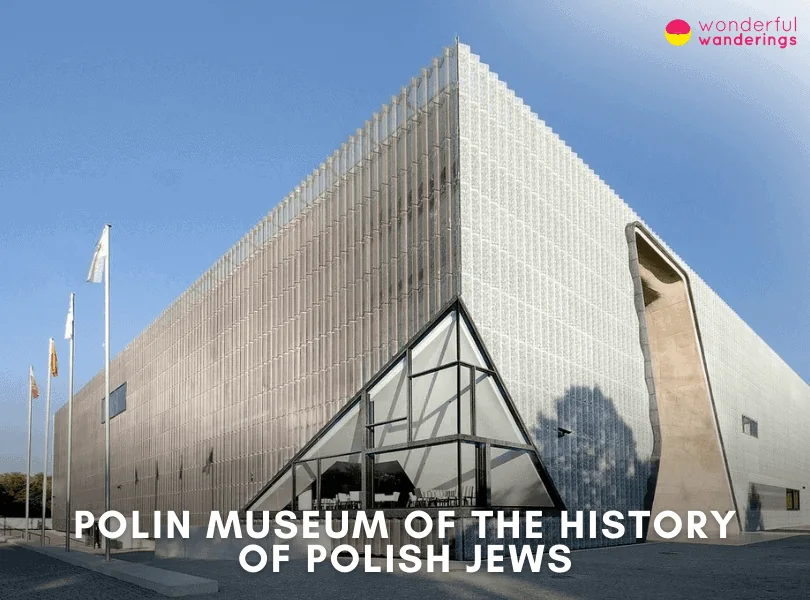
POLIN Museum features an immersive Core Exhibition spanning over 4000 sq meters, recounting the epic 1000-year history of Poland's Jewish community using multimedia installations, paintings, films, reconstructions and hundreds of original artifacts. The galleries vividly showcase the diversity of Polish Jewish life, from early settlement to the community's ‘Golden Age', the interwar years, the tragedy of the Holocaust and finally, the Jewish revival today. One of the exhibition's showstoppers is an enormous replica of the intricately painted ceiling and roof beams of a 17th-century wooden synagogue. Visitors to the POLIN Museum can journey through the Core Exhibition's eight galleries displaying a thousand years of Polish Jewish arts, culture and heritage. Visitors can view films, listen to oral histories, explore interactive maps and installations and admire a multitude of precious objects like folk costumes, religious items, books, paintings and Jewish folk art illuminating the lost world of Polish Jews. The POLIN Museum offers activities catering to all visitors, families, school groups, researchers, culture lovers and anyone interested in learning about the long and culturally rich history of Polish Jewry. The museum also hosts workshops, debates, concerts, festivals and holiday events like Hanukkah celebrations.
The POLIN Museum is easily accessible using Warsaw's excellent public transportation system. Visitors can take a 25-minute train directly to Warsaw Śródmieście station, then transfer to tram #15, #18 or #35 for the short ride to the POLIN Museum stop. The museum is situated close to the city center and major hotels. Parking is available for visitors driving to the museum. Entry tickets to the POLIN Museum's Core Exhibition cost 25 PLN ($6, 6€, 4£) with extra fees for temporary exhibits, workshops and family activities. The museum is closed on Mondays and certain public holidays.
6. Warsaw Uprising Museum
The Warsaw Uprising Museum (Polish. Muzeum Powstania Warszawskiego) is located in the Wola district of Warsaw, Poland, at 79 Grzybowska Street, 00-844 Warsaw. The museum is dedicated to commemorating the Warsaw Uprising of 1944, when Polish resistance forces led by the Home Army rose against the Nazi German occupation for 63 days. The idea to build a museum originated in 1983, but construction only began in 2003. The museum opened on July 31st, 2004, to coincide with the 60th anniversary of the start of the uprising. Its creation was seen as a tribute to the fallen heroes and the enormous sacrifice of Warsaw's residents.
Warsaw Uprising Museum features modern architecture and an immersive, multimedia approach to presenting history. The building features a cracked glass facade, symbolizing the rupture between pre-war and contemporary Warsaw. Inside, the museum spans over 3000 sq meters with hundreds of exhibits and installations reflecting different aspects of life during the uprising. Key highlights include the replica of a Liberator B-24J bomber used in supply drops, sewer tunnels recreating the insurgent passageways, an interactive map plotting troop movements and chilling video testimonies of survivors. Visitors to the Warsaw Uprising Museum can view films and video displays, listen to audio recordings of insurgents and survivors, explore underground passageway replicas, see artifacts like homemade weapons and medical equipment, admire photos and documents from the uprising and occupation of Warsaw, learn about key figures and witness events through maps and timelines. The multimedia exhibits and artifacts at the Warsaw Rising Museum cater to visitors of all ages and interests.
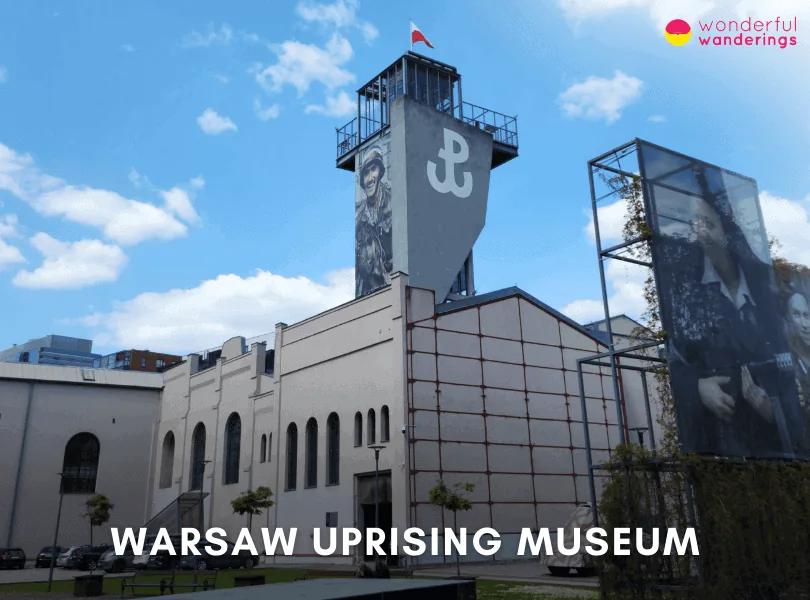
The Warsaw Uprising Museum is easily accessible by public transport, located close to the city center. Visitors can take the S2 or S3 train to Warsaw Śródmieście station, then either walk 15 minutes or take any eastbound trams along Marszałkowska Street to the museum stop. The museum is also within walking distance from hotels in the Śródmieście district. Entry tickets to the permanent exhibition cost 25 PLN (6€, $6, £4) with discounts for students and seniors.
7. Wilanów Palace
Wilanów Palace is located in the Wilanów district of Warsaw, Poland's capital and largest city. The full address is Stanisława Kostki Potockiego 10/16, 02-958 Warsaw. It is 10 kilometers (6.2 miles) south of Warsaw's city center. Wilanów Palace has a long and storied history. Construction began in 1677 under the commission of King John III Sobieski, who wanted a grand suburban residence resembling the Palace of Versailles. The initial design was by Augustyn Wincenty Locci in a style combining elements of Polish nobility architecture with an Italian suburban villa. After Sobieski died in 1696, the palace changed hands multiple times, with various owners adding their flourishes. Wilanów Palace is one of Poland's best-preserved royal residences, having survived the country's tumultuous history.
Visitors to Wilanów Palace can explore the lavish royal apartments on the main floor, including the Baroque-era King's quarters and the later 18th-century suites of various noble residents. People can admire the works of great painters like Rembrandt, along with antique furnishings and art from civilizations spanning ancient Rome to 17th-century China and Japan. The upper floors host temporary exhibits. The gardens, orangerie and park offer opportunities for scenic strolls. The palace hosts cultural events, summer concerts and an annual Royal Garden of Light show during winter. The activities at Wilanów Palace cater to varied visitors, from history and architecture buffs to families and photography enthusiasts. Kids can enjoy spotting whimsical garden sculptures, rowing on the lake and watching the peacocks wandering the lawns. The museum appeals to art aficionados, while the preserved 17th-century interiors give a glimpse of royal life for history fans. The beautiful grounds suit leisurely walks for nature lovers. Wedding parties frequently take photos on the grounds.
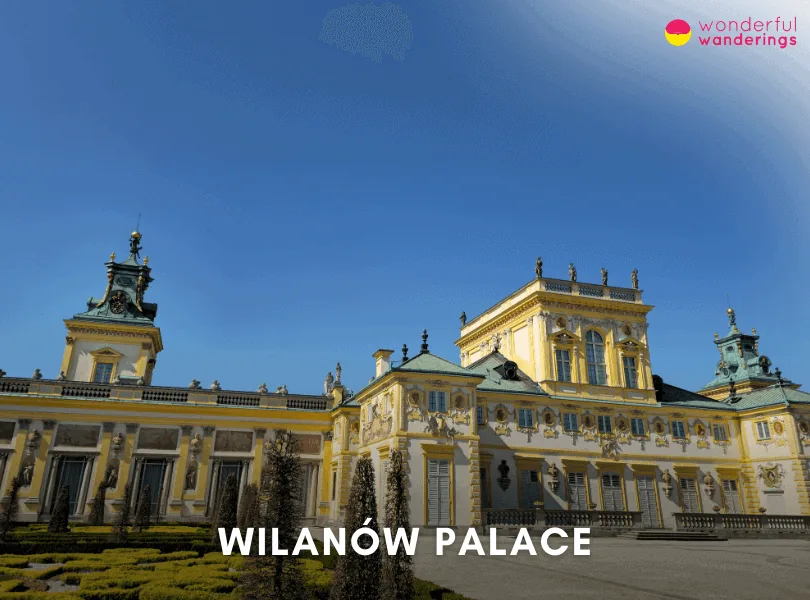
Wilanów Palace is easily reached from central Warsaw via public transit, taxi or bike. Visitors can take a 25-minute S2 or S3 train to Warsaw Śródmieście station, then transfer to bus #116, #180 or #516 directly to the Wilanów stop. The nearby Wilanowska metro station is set to open in 2023. The palace is also accessible on foot or bike from the Łazienki Park area (30 mins).
Entry tickets to the Palace Museum cost 25 PLN (6€, $6 £4). Combo tickets for the museum plus park are available. Special events like the Royal Garden of Light have additional fees. Through its well-preserved architecture, royal connections, and art collections, Wilanów Palace offers an elegant glimpse into Poland's past.
8. Copernicus Science Centre
The Copernicus Science Centre (Polish. Centrum Nauki Kopernik) is located in Warsaw, Poland, along the Vistula River at Wybrzeże Kościuszkowskie 20, 00-390 Warsaw. It lies in the Powiśle district, near the Warsaw University Library. The origins of the Copernicus Science Centre date back to the 1990s when Polish Radio began organizing outdoor science-themed picnic events for families. The concept eventually grew into plans for a permanent interactive science museum. Construction on the ultra-modern glass and steel building began in 2008, led by young Polish architects from the RAr-2 Architecture Laboratory. The first section opened in November 2010 and additional galleries, a planetarium, labs and other facilities opened over the next year. It spans over 15,000 square meters.
Copernicus Science Centre is one of Europe's most advanced interactive science museums. It contains over 400 hands-on exhibits demonstrating scientific principles that visitors can experiment with. There are no glass cases or traditional museum displays. This focuses on sparking curiosity to explore natural phenomena through games, challenges and first-hand discovery. Exhibits are spread over galleries with themes like Humans and Environment, Light and Vision, Physics and Roots of Civilization, unified by an open “Experimental Zone”. Other facilities include laboratories, a planetarium, theaters, workshops, conference spaces and a rooftop garden. Visitors can pilot a spaceship, build bridges, see a flying carpet in action, race a hippo, try out artistic illusions, conduct robotic excavations, explore the physics of their bodies and countless other exhibits. There are also chemistry, physics, biology and robotics labs for supervised experiments. In the on-site planetarium, visitors can immerse themselves in films about space or the cosmos on its 360-degree screen. The interactive exhibits at the Copernicus Science Centre cater to visitors of all ages and backgrounds. Kids can enjoy age-specific galleries like “Bzzz!” for visitors under five, while teens have the “Re. Generation” area. Families, students, tourists, etc., can all tailor their visit based on interests ranging from art to space to engineering. Visitors typically spend 2-4 hours but can easily stay longer across the extensive exhibition space and facilities.
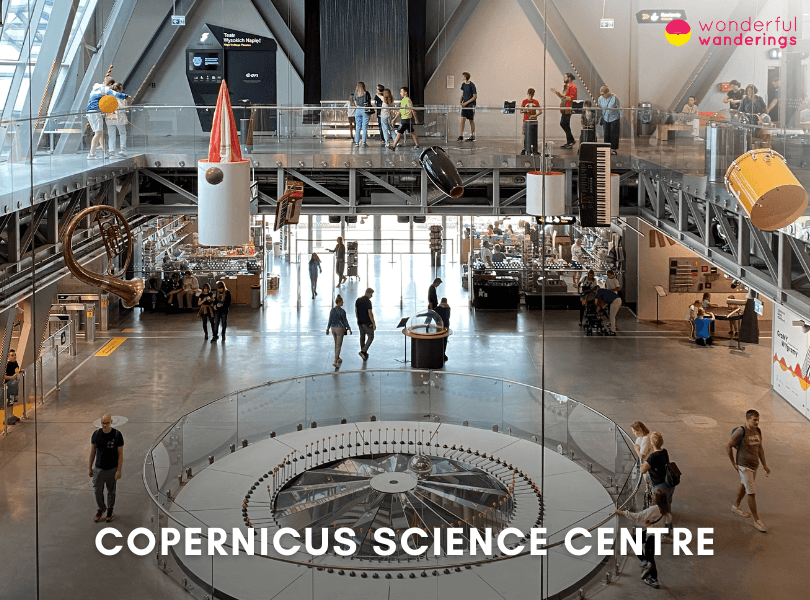
The Copernicus Science Centre has excellent transport links in central Warsaw near the Vistula River. Visitors can take the S2 or S3 train to Warsaw Śródmieście station (8 mins walk) or the metro line M2 to Centrum Nauki Kopernik station right by the museum. Many buses and trams also stop directly outside or nearby. Garage parking and bicycle racks are also available on-site.
Entry tickets to the permanent exhibitions cost 40 PLN (9€, $10, £7). The planetarium has separate ticket pricing of 28 PLN (6€, $7, £5). Discounted annual family memberships are available.
9. Warsaw Zoo
The Warsaw Zoological Garden, known simply as the Warsaw Zoo, at Ratuszowa 1/3, 03-461 Warsaw. It lies on the right bank of the Vistula River in central Warsaw. The Warsaw Zoo has a long history dating to its opening on March 11, 1928. The current zoo was established by a resolution of the Warsaw City Council in 1927. The first director was Wenanty Burdziński, former founder of the Kiev Zoo. In its early years, the Warsaw Zoo acquired animals from older closed zoos through purchases and donations. It quickly became a beloved institution among Warsaw residents. During World War II, the zoo suffered heavy damage from bombing and demolitions. Remarkably, zoo directors Jan and Antonina Żabiński saved hundreds of Jews by hiding them within the zoo grounds. The zoo was rebuilt and reopened in 1949. It houses over 11,000 animals representing over 500 species, spread across 40 hectares of green space.
Warsaw Zoo is right in the heart of the city center, allowing urban residents easy access to nature. Visitors can see a diverse collection of animals worldwide, displayed in thoughtfully designed enclosures resembling natural habitats as much as possible. Highlights include the elephant house, hippo pavilion with shark tank, reptile house, ape enclosure, aviaries and more. The zoo also runs conservation and breeding programs for endangered species. And its free-roaming peacocks wandering the grounds add a whimsical touch. Visitors can observe and learn about animals ranging from tiny insects to large mammals like elephants and rhinos. In indoor enclosures, people can tour the elephant, hippo, ape and reptile houses for close-up views of exotic species. Outdoor spaces like the bear habitat, seal pond and large bird aviaries allow seeing other animals in more natural settings. Interactive displays provide info about species and conservation. The Warsaw Zoo offers fun and engaging activities for visitors of all ages and interests. Families with kids can enjoy seeing all the varied animals while learning about wildlife. Interactive elements appeal to children. There is much to discover for adults interested in zoology, conservation and biodiversity.
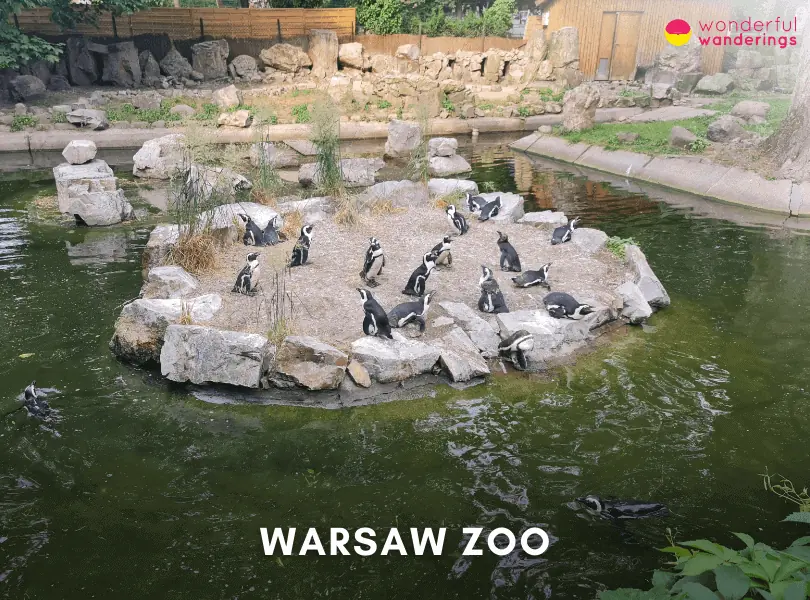
The Warsaw Zoo has excellent public transportation links, given its prime location in Warsaw's city center. It is within walking distance from attractions like the Old Town. Visitors can take the S2 or S3 train to Warsaw Śródmieście station, walk for 15 minutes or take tram #24 or #33 to the zoo's Ratuszowa stop. Warsaw Centralna train station also offers trams and buses to the zoo. The zoo has two gates on Ratuszowa and Jagiellońska Streets. Entry tickets to the Warsaw Zoo cost 10 PLN ($2, 2€, 1£). Discounted family and group rates are available.
10. Palace of Culture and Science
The Palace of Culture and Science (Polish. Pałac Kultury i Nauki) is located in central Warsaw, Poland, at Plac Defilad 1, 00-901 Warsaw. It lies in the Śródmieście (City Center) district of Warsaw. The Palace has a contentious history dating back to its construction from 1952-1955, when it was built as a “gift from the Soviet people” during Poland's communist era. The Palace was personally commissioned by Soviet leader Joseph Stalin and designed by Soviet architect Lev Rudnev in a monumental “socialist realist” style, resembling several similar Stalinist skyscrapers built across the Eastern Bloc. Over 3,500 Soviet workers assisted in erecting the 237 meters (778 ft) tall structure using high-quality materials and lavish decorations that were scarce in still war-ravaged Poland.
The Palace of Culture and Science is immense and has an instantly recognizable silhouette on Warsaw's skyline. Though controversial for its ideological symbolism, the Palace has, over time, become an iconic fixture of the city. Visitors can ascend to its 30th-floor viewing terrace 114 meters (374 ft) high for panoramic views of Warsaw. The Palace also houses many public facilities, including museums, theaters, cinemas, galleries, bookshops, restaurants, a large congress hall and a swimming pool. Surrounding the building are socialist realist sculptures of figures from fields like science and arts. The Palace has a memorable illuminated facade from far across the city at night. Visitors can view the expansive Congress Hall, see panoramic views from the 30th-floor terrace, visit the Museum of Technology or Poster Museum, watch a show at one of its theaters, see films at its multiplex cinema, go shopping at its bookstores, dine at its restaurants or simply admire the monumental architecture and decor. The activities at the Palace cater to varied visitors, tourists, families, culture aficionados, photographers, etc. The terrace view appeals to all ages for its wow factor. Events like concerts or theater shows suit nightlife-lovers. Museums and architecture interest culture fans, while the iconic facade provides endless photo-ops.
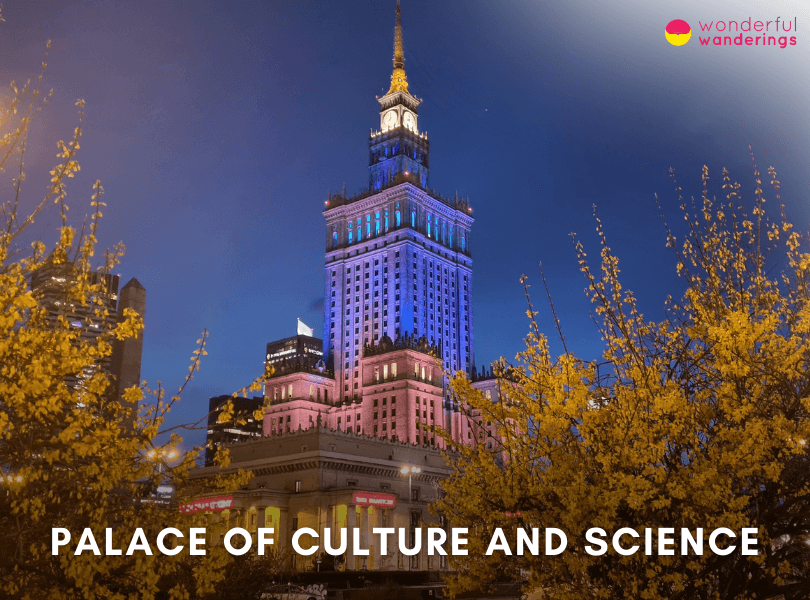
The Palace of Culture and Science has excellent public transportation access in Warsaw's thriving downtown. The nearby Centrum metro station, multiple buses and Warsaw Centralna train station provide links. Visitors can take the S2 or S3 train to Warsaw Śródmieście station (12 mins walk) or metro line M2 to Centrum station by the Palace. The central location also makes walking an option from nearby hotels or Old Town (25 mins). Entry to the Palace building is free, with charges only for certain attractions like the observation terrace, movies and events.
11. National Museum in Warsaw
The National Museum in Warsaw (Polish. Muzeum Narodowe w Warszawie) is located at Aleje Jerozolimskie 3 in the downtown area of Warsaw, Jerozolimskie 3, 00-495 Warsaw. The National Museum has a history dating back to 1862 when a Society for the Encouragement of Fine Arts was established in Warsaw. Its goal was to promote Polish arts and culture and help establish a national museum. The Museum opened to the public in 1864, though its early collection was small. Its current imposing building, constructed in 1927-1938, was inspired by Neoclassical architecture. Designed by architects Tadeusz Tolwiński and Antoni Jawornicki, it exemplifies Polish monumental style with imposing columns and a decorative facade.
The National Museum has a vast collection of Polish and international paintings dating from the 16th through 20th centuries, counting over 830,000 exhibits in total. Poland's most famous paintings are housed there, including Jan Matejko's enormous “Battle of Grunwald”. Other highlights include Gothic altarpieces, Orthodox icons, genre & portrait paintings from the 16th-18th centuries, a cabinet of prints and drawings and extensive collections of sculptures and decorative arts. Temporary exhibitions are also mounted in galleries on the 2nd floor.
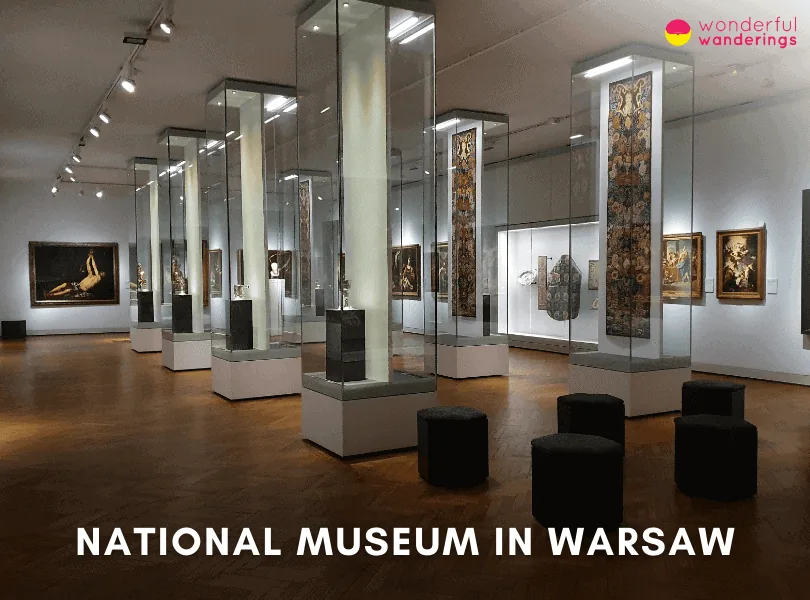
Visitors can tour multiple galleries chronologically showcasing the expansive collection, from medieval altarpieces to 20th-century Polish paintings. People can admire iconic large-scale Polish history paintings, view precious icons, see rare Renaissance portraits and discover works by leading international Old Master painters. The collection and activities at the National Museum cater to varied visitors, including art aficionados, history buffs, tourists and anyone interested in Polish cultural heritage. School groups, families and international tourists frequent the galleries due to the museum's central location and collection highlights familiar to worldwide art history.
The National Museum is conveniently located in Warsaw's city center on Aleje Jerozolimskie, a major street. It is within walking distance from attractions like the Old Town and easily reached by public transit. Visitors can take a 25-minute train to Warsaw Centralna station, walk for 15 minutes, or take any eastbound bus at five stops. Regular admission tickets to the permanent National Museum galleries cost 20 PLN (5€, $5, £3). Open Tuesday-Sunday, closed Mondays, and major holidays.
12. Warsaw Citadel
The Warsaw Citadel (Polish. Cytadela Warszawska) is in Warsaw, Poland. The full address is ul. Czerniakowska, 00-715 Warsaw. It lies in the Żoliborz district, on the west bank of the Vistula River. The Warsaw Citadel has a long and turbulent history. It was built between 1832 and 1834 by order of Russian Tsar Nicholas I, following the suppression of the November Uprising in 1830. The fortress was intended to bolster imperial control and intimidate Polish nationalists. Designed by Russian general Ivan Dehn, it covers 36 hectares and originally housed over 16,000 Russian troops. The imposing brick structure features high outer walls and bastions surrounding barracks, arsenals and prisons. The Warsaw Citadel is one of the best-preserved 19th-century fortress complexes in Poland. It is a monument to the complex story of Russian domination and Poland's struggle for independence.
Visitors can explore parts of the formidable historic defenses and learn more at on-site museums. The Citadel grounds are also home to two other museums, the Katyn Museum and the Museum of Polish Military Technology. The sprawling site offers scenic riverside walks with panoramic views of Warsaw. Viisitors can take self-guided tours along sections of the brick defensive walls, view historic guardhouses and fortifications and visit on-site museums. The activities at Warsaw Citadel cater to varied visitors, including history and military buffs, culture aficionados, sightseers and nature lovers. The fortress ground's scenic location makes it a nice spot for walking or running along the Vistula River. Families can enjoy the outdoor areas and take kids to the historic walls and cannons. Museums appeal most to adults and older youth interested in Polish history and Warsaw's WWII suffering under occupation. The summer music festivals also draw lively crowds.
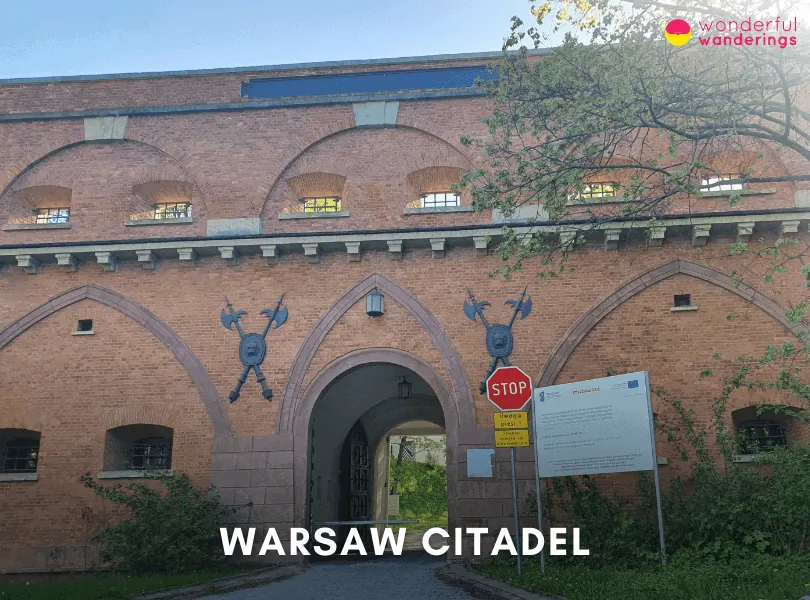
The Warsaw Citadel sits close to Warsaw's city center on the west bank of the Vistula River. It can be reached via buses #102, #105, #111, #117, #127, #175, #507 and #517, which stop right by the Citadel. Visitors can take the S2 or S3 train to Warsaw Śródmieście station, then transfer to bus #111, #127 or #517 directly to the Citadel stop. Entry to the Citadel grounds is free. The Warsaw Citadel is open year-round, but some museums are closed on Mondays or Tuesdays.
13. Neon Museum in Warsaw
The Neon Museum (Polish. Muzeum Neonów) is located in the Praga district of Warsaw, Poland, at 25 Mińska Street, 03-808 Warsaw. The museum is inside the Soho Factory, a revitalized former factory complex that now contains galleries, shops and restaurants. The Neon Museum has a unique history dating back to 2005 when British graphic designer David Hill and Polish photographer Ilona Karwińska began a project to document Warsaw's fading Cold War-era neon signs. Their “Polish Neon” exhibition showcased these forgotten signs and sparked renewed public interest. The couple's collection outgrew their storage spaces as more neon signs were donated. In 2012, they established the Neon Museum to provide a permanent home for these artifacts of Warsaw's history.
The Neon Museum features a collection of over 200 neon signs, tubes and letterforms from Poland between the 1960s and early 1990s. The signs were produced during the “neonization” of Polish cities, a state campaign to install colorful, avant-garde neon decorations designed by famous artists. The museum has iconic signs like the swirling flower shop insignia, a neon centaur from a cinema, a mermaid symbolizing a library and many unique lettering styles. Each sign has been preserved and restored, with the stories behind their original locations. The Neon Museum is one of just a few museums of its kind worldwide dedicated to preserving this Cold War art form. Visitors can observe the striking colors, shapes and letterforms that made these neon creations iconic during Warsaw's “neon renaissance”. The museum also houses a vast archive of related photographs, documents and blueprints. The Neon Museum appeals to visitors of all ages and backgrounds. The retro neon designs, illuminating stories and hands-on displays engage kids and adults alike. Photographers flock to capture the dazzling colors. Historians and city culture enthusiasts appreciate learning about Warsaw's neon history. Design and architecture buffs admire the mid-century styles and avant-garde lettering. The museum often hosts events like concerts or movie nights showcasing neon art, with something for everyone.
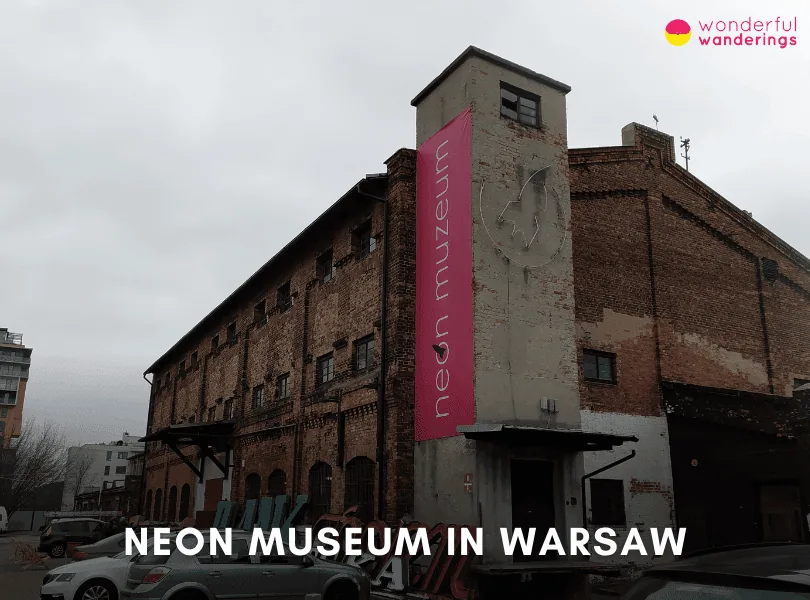
The Neon Museum has convenient public transport connections despite its industrial location. Visitors can take the S2 or S3 train to Warszawa Wschodnia station (12 mins), walk for 15 minutes or take trams #4, #15, #18 or #35 to the Mińska stop right by the museum. The museum is also accessible by buses #154, #160, #190 and #517. Entry tickets to the Neon Museum cost 18 PLN ($4, 4€, 3£). The museum is open from 12 pm to 6 pm, Monday to Saturday and Sundays from 11 am to 5 pm. Guided tours have additional fees.
14. Chopin Museum
The Fryderyk Chopin Museum (Polish. Muzeum Fryderyka Chopina) is located at 1 Okólnik Street in Warsaw, Poland. It is in the historic Ostrogski Palace in Warsaw's Śródmieście (City Center) district, near the Vistula River escarpment. The museum has a history dating back to the 1930s when the Fryderyk Chopin Institute began collecting Chopin memorabilia. The museum officially opened in 1954. It houses the world's largest collection of artifacts related to the renowned Polish composer and pianist Frédéric Chopin (1810-1849). The museum contains over 5,000 exhibits spanning Chopin's life from birth to death. The Chopin Museum uses innovative multimedia technology to bring Chopin's world to life.
Visitors can explore rooms dedicated to different periods in Chopin's life, from his youth in Poland to later years in Parisian exile. Visitors can view original manuscripts, listen to his works and learn about his turbulent romance with French writer George Sand. The museum traces Chopin's journey from a child prodigy playing organs in Warsaw churches to a fragile virtuoso performing in European concert halls. Through the innovative multimedia exhibits, screens and audio stations, visitors can fully immerse themselves in Frédéric Chopin's world. The multimedia activities at the Chopin Museum cater to all visitors, music fans, history buffs, families, tourists, etc. The variety of exhibits, listening stations and interactive screens provide engaging content for children and adults alike. The museum hosts piano recitals, concerts, lectures and special events like outdoor summer Chopin concerts. Guided tours are available for groups.
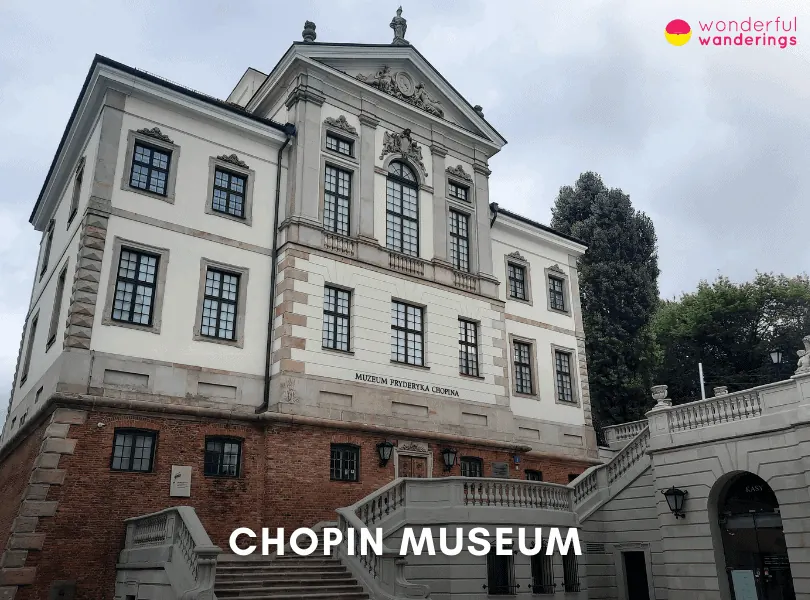
The museum enjoys a convenient central location in downtown Warsaw. Visitors can take a 25-minute train to Warsaw Central Station and then transfer to bus #180, #195, or #518. The Chopin Museum is a must-see attraction using modern technology to immerse visitors in his genius. Regular admission tickets cost 25 PLN (6€, $6 £4). Entry is free on Wednesdays. Discounted tickets are available for students, seniors, etc. The museum is open Tuesday-Sunday, 10 am to 8 pm. It provides an unforgettable interactive showcase of the life and music of Poland's most celebrated classical composer, Fryderyk Chopin.
15. Praga District
The Praga District is located in Warsaw, Poland, on the east bank of the Vistula River. Its boundaries roughly align with two administrative districts. Praga Północ (Praga North) and Praga Południe (Praga South). The area spans neighborhoods like Pelcowizna, Szmulizna and Grochów. Praga has a long history dating back to the 1400s as a separate settlement across the river from Old Warsaw. It derived its name from the Polish word “prażyć” meaning “to burn or roast”, referring to the burning of trees to clear space for the village. Praga was granted its city charter in 1648 but remained separate from Warsaw, only connected by ferries and ice crossings. Wars and fires repeatedly damaged it over the centuries before being officially incorporated into Warsaw in 1791. Praga retains more original pre-war architecture than most Warsaw districts.
Praga's “authentic” atmosphere contrasts with the touristy Old Town – the pedestrian streets feel lived-in versus a museum. Another draw is Praga's dynamic arts and entertainment scene, from neon-lit bars to repurposed factories hosting galleries and shows. Visitors can explore historic churches like the Baroque Our Lady of Loreto and neo-Gothic St. Florian Cathedral, wander atmospheric backstreets lined with pastel houses, shop at the vintage Różycki Bazaar and tour museums like the Warsaw Praga Museum for insights into local life. The Soho Factory complex hosts events in its industrial halls-turned-arts venues. Nightlife hotspots include the famous “11 Listopada 22” courtyard with cool clubs. Parks like Skaryszewski offer leafy escapes while the zoo entertains families. The activities in Praga cater to varied visitors, from history buffs to party people. Families appreciate the zoo, park spaces and laidback local vibe. Nightlife lovers flock to the offbeat bars and clubs. Nostalgic types enjoy retro shopping as they glimpse a vanishing way of life. Photography fans find endless inspiration in the gritty streetscapes and murals.
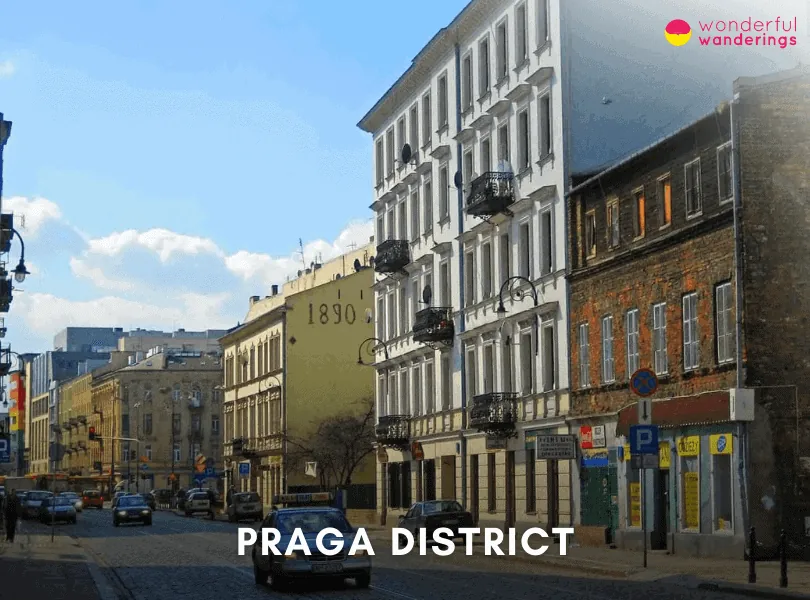
Reaching Praga is easy using Warsaw's excellent public transit. The S2 or S3 train reaches Warsaw Śródmieście station in the center. From there, metro line M2 runs directly to Dworzec Wileński station in the heart of Praga. Trams #4, #15, #18, #35 also cross the river. Buses #160 and #190 run frequently from Old Town. Praga offers visitors an eye-opening walk off Warsaw's beaten path. Entry to Praga's streets, parks and churches is free. Paid admission applies at specific attractions.
16. Powązki Cemetery
Powązki Cemetery (Polish. Cmentarz Powązkowski) is in the Wola district, Powązkowska 14, 01-797 Warszawa, Poland. Powązki Cemetery has a long history dating to its establishment on November 4, 1790, on land donated by Polish nobleman Melchior Szymanowski. It was consecrated on May 20, 1792. During World War II, the cemetery suffered heavy damage. Remarkably, zoo directors Jan and Antonina Żabiński saved hundreds of Jews by hiding them within the zoo grounds located nearby. After the war, the cemetery was rebuilt and restored. Powązki Cemetery covers 43 hectares (110 acres) and is the burial place of over 1 million people. Powązki Cemetery is one of Warsaw's most famous and historically significant cemeteries. Many famous Poles are buried here, with some interred along the “Avenue of the Distinguished” – Aleja Zasłużonych, created in 1925 to honor Poland's eminent cultural, scientific and military figures.
Visitors can explore the grounds, view the many ornate tombstones and statuary, visit graves of famous Poles buried here, like composers Frederic Chopin and Witold Lutosławski, pay respects to loved ones and take in the cemetery’s atmosphere of serenity. The Avenue of the Distinguished section makes for an especially memorable walk. The cemetery appeals to varied visitors, including history fans, those with family buried here, photography enthusiasts or anyone wishing to take a quiet walk surrounded by nature. Its elaborate tombstones and celebrity burials make it a popular tourist attraction. The scenic grounds are also suitable for respectful jogging or dog walking.
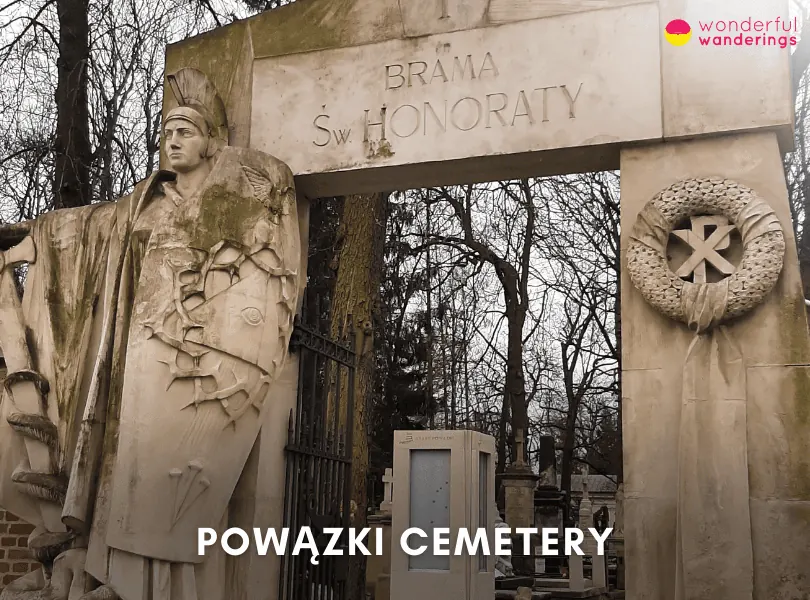
Powązki Cemetery is located in western Warsaw and is easily accessible by public transport. Visitors can take bus #175, which stops at the cemetery entrance. The nearby metro stop is Pole Mokotowskie. Buses and trams connecting the city center to the Mlociny metro station also pass by the cemetery. Entry to Powązki Cemetery is free and open to visitors daily. The historic Powązki Cemetery is a must-see for visitors wanting to pay their respects while taking in elaborate Polish tombstone architecture and art.
17. University of Warsaw Library Roof Garden
The University of Warsaw Library Roof Garden is in Warsaw, Poland, at Dobra 56/66, 00-312 Warsaw. The garden sits atop the library building, part of the historic main campus of the University of Warsaw located along Krakowskie Przedmieście Street in central Warsaw.
The roof garden has an interesting history, opening recently on June 12, 2002. It was designed by acclaimed Polish landscape architect Irena Bajerska to utilize the library's expansive roof space. At over 1 hectare (10,000 square meters), it ranks among the largest roof gardens in Europe. The garden features two main sections – a lower garden and an upper garden connected by a cascading fountain and several smaller thematic gardens. Its creation also included installing proper waterproofing, drainage, irrigation and other infrastructure to support a garden.
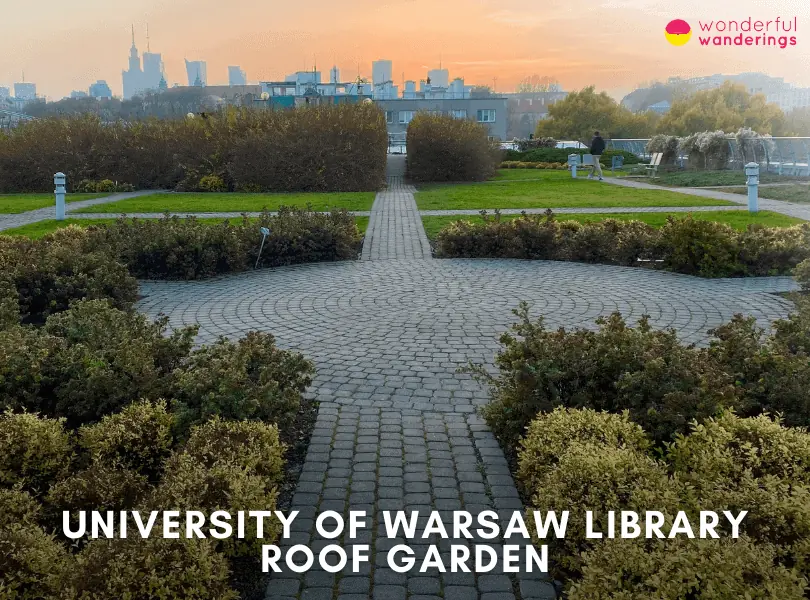
The University of Warsaw Library Roof Garden has extensive greenery, scenic vistas and imaginative landscaping above the streets. Visitors can ascend from the lower garden to discover secluded garden spaces divided into color-themed sections like the Silver Garden or Crimson Garden. The garden includes nearly 100 tree varieties and over 4,000 shrubs like spirea, barberry and lavender that bloom in waves of color. Other garden features include granite sculptures, streams, pergolas, observation decks and even a duck pond. From the garden vantage points, one can take in panoramic city views of Warsaw's skyline and the Vistula River. The garden has many benches to sit, read or relax amidst the urban respite. The garden attracts various visitors, from the University of Warsaw students seeking study breaks to tourists and families exploring its playful landscape. The garden also hosts university events, summer gardening workshops for kids and outdoor theater performances.
The University of Warsaw Library Roof Garden enjoys a very central and convenient location from the Metro Centrum Nauki Kopernik station. It sits close to popular attractions like the Copernicus Science Centre, the Warsaw University campus and the Vistula Riverfront. Visitors can take the S2 or S3 train to Warsaw Śródmieście station, then either walk 15 minutes through downtown or take any eastbound trams along Marszałkowska Street to the garden's Dobra Street entrance. The best part is that no admission tickets are required to enter the University of Warsaw Library Roof Garden. Visitors can explore the gardens year-round. The upper garden is only open from April through October.
18. Warsaw Mermaid Statue
The Warsaw Mermaid Statue (Polish. Pomnik Syrenki Warszawskiej) is located in the very heart of Warsaw's Old Town, in front of the Old Town Market Place at Plac Zamkowy 4, 00-277 Warsaw, Poland. The mermaid statue has a history intertwined with Warsaw's very origins. A mythical female creature first appeared on the city's coat of arms in the 14th century, initially with a bird's torso and dragon tail. Over the next centuries, her form gradually transformed into the mermaid we recognize today. Legends arose about how the mermaid settled in Warsaw, fell in love with the local fishermen and pledged to defend the city. Konstanty Hegel designed the most famous statue depicting Warsaw's mermaid.
The Warsaw Mermaid statue has been a significant city symbol for over six centuries. The mermaid statue ties together Warsaw's coat of arms, the legends of the city's founding and the iconic Old Town where she resides. Her prominent placement in the Market Square makes her the most visited and photographed mermaid sculpture in Poland's capital. She can be seen gracing everything from official city documents to souvenir trinkets. The statue portrays the mermaid as a beautiful, busty woman and warrior, ready to defend Warsaw with her raised sword and shield. Visitors can admire the sculpture up close, pose for photos of the distinctive landmark and appreciate why she was chosen as the protector of Warsaw. The Mermaid Statue appeals to all visitors, families, couples, historians and first-time Warsaw tourists. Kids especially enjoy spotting the mermaid and reading about her legends. Historians appreciate the site's significance, which stretches back seven centuries. Photographers flock to capture images of the distinctive sculpture with old townhouses as a backdrop.
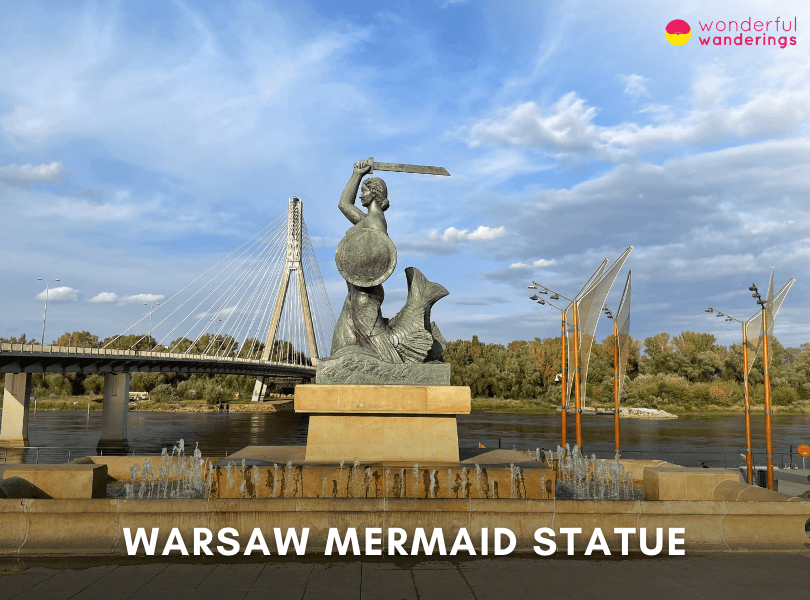
The Mermaid Statue is within walking distance from hotels and attractions in the Śródmieście district. Visitors can take the S2 or S3 train to Warsaw Śródmieście station (8-minute walk) or metro line M2 to Ratusz Arsenał station (4 minutes). The best part is no admission tickets are required to see the Mermaid statue. Visitors can freely view and photograph the sculpture year-round as they explore Warsaw's atmospheric Old Town center.
19. Pub Crawl Warsaw
The Pub Crawl Warsaw is located in the city center of Warsaw, Poland. The full address of the meeting point is Club Makulatura, in the backyard of Chmielna 5 Street, 00-021 Warsaw. The Pub Crawl Warsaw has over ten years of history, having started organizing party tours in Warsaw in 2011. It was created by local guides seeking to showcase the best of Warsaw's nightlife to visitors in a fun and affordable way. Over 15,000 international crawlers have since joined their pub crawls. The local guides are carefully selected for their energy, friendliness and nightlife expertise to deliver tourists an epic party experience discovering local bars and clubs.
Visitors can enjoy an hour-long open bar of unlimited beer, wine and mixed drinks, with the chance to mingle and play drinking games. They will then tour three more standout local bars, receiving a free shot at each venue. Guides encourage crazy challenges to get outside comfort zones before ending at an exclusive club with complimentary VIP access. Nightlife hotspots showcase Warsaw's best venues for drinking and dancing. The social atmosphere facilitates befriending fellow crawlers from different countries. The pub crawl activities cater to various nightlife lovers, including tourists, study-abroad students, backpackers, young professionals and locals looking to discover new hotspots. The party vibe appeals especially to 20-35 year olds. Solo travelers can easily meet new people. Budget-conscious drinkers appreciate the included drinks and specials. Extroverts are drawn to the sociable challenges. The crawling community bonds over their zest for nightlife regardless of background.
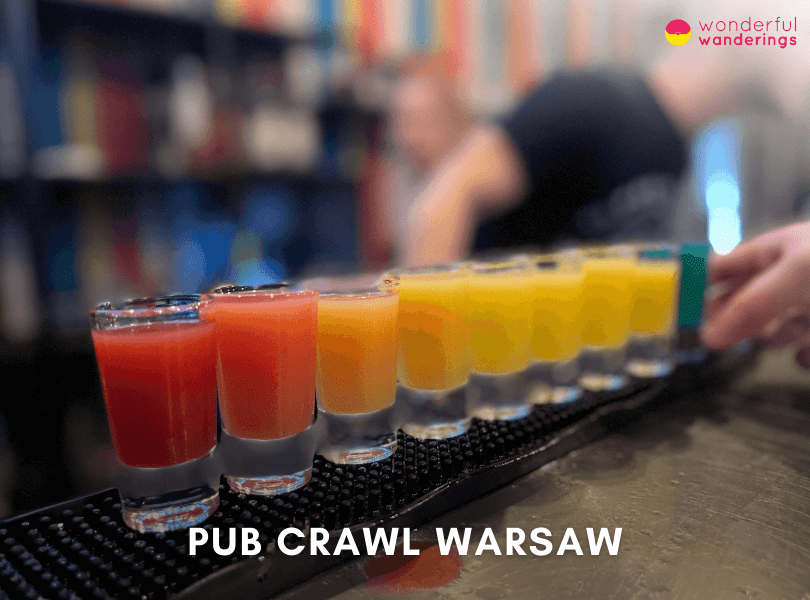
The Pub Crawl Warsaw meeting point at Club Makulatura enjoys a convenient central location in downtown Warsaw near popular attractions. It is within walking distance from hotels and sites in the Śródmieście district. Visitors can take the S2 or S3 train to Warsaw Śródmieście station (8 minutes walk) or metro line M2 to Centrum station (10 minutes). It has introduced over 15,000 visitors to the city's legendary nightlife scene. The Pub Crawl Warsaw offers the chance to party like a local VIP on a journey into Warsaw's nightlife.
What are the best museums to visit in Warsaw?
Listed below are the best museums to visit in Warsaw.
- Museum of Warsaw. The Museum of Warsaw immerses visitors in the city's extensive history through 6 floors of highly engaging and interactive audio-guided exhibitions depicting Warsaw from its founding days to the present, including panoramic vistas of Old Town Square from the top-floor viewpoint.
- The POLIN Museum of the History of Polish Jews. This museum is spread over eight state-of-the-art galleries. The POLIN Museum's award-winning permanent exhibition utilizes multimedia technology to vividly trace 1000 years of Jewish life in Poland, from reconstructed synagogues and a detailed Warsaw Ghetto model recreating poignant moments in time, ultimately winning the prestigious European Museum of the Year award in 2016 for its innovative approach.
- Warsaw Rising Museum. This museum utilizes videos, photographs, replica resistance sites, personal accounts and artifacts. The Warsaw Rising Museum depicts the tumultuous 1944 uprising against Nazi occupation over several emotionally impactful floors dedicated to the various facets of this pivotal historical event.
- The National Museum. The National Museum houses Poland's most extensive art collections gathered over centuries, spanning ancient civilizations and medieval religious artifacts through multiple galleries dedicated to the country's most influential 19th and 20th-century artistic masters across painting, sculpture and more.
- Copernicus Science Centre. The Copernicus Science Centre contains over 400 interactive, hands-on science exhibits and activities, allowing visitors to actively explore principles of physics, chemistry and more, as well as panoramic Vistula River views from its rooftop gardens and journeys through the cosmos in its high-tech planetarium. This museum is also great for families.
- The Wilanów Palace Museum. The Wilanów Palace Museum is housed in a lavish former royal residence with opulent baroque architecture and ornate interiors, containing interesting collections of 18th and 19th-century paintings alongside Chinese artifacts that provide insights into the tastes of past Polish aristocracy and royalty. The sprawling palace grounds feature beautifully landscaped gardens in the French style with scenic ponds and pathways that allow visitors to experience the luxurious lifestyles of Polish nobles.
- Royal Castle in Warsaw. Royal Castle in Warsaw takes visitors through the storied history of this important seat of Polish royalty over the centuries via engaging tours of the ornate throne room, royal apartments and grand halls that have been carefully recreated based on paintings and historical accounts to replicate their original splendor before the castle's destruction in World War II. Guides bring the castle's dramatic history to life with vivid tales of royal ceremonies, political intrigue and wars played out within its walls through extensive multimedia and interactive exhibits.
What are the best things to do in Warsaw with kids?
Listed below are the best things to do in Warsaw with kids.
- The Copernicus Science Centre. The Copernicus Science Centre offers over 400 interactive exhibits spread across multiple floors that allow kids ages five and up to explore principles of physics, chemistry and more through supervised hands-on experiments, 3D movies in the on-site planetarium and rooftop gardens with nice views of the Vistula River and Warsaw skyline.
- Warsaw Zoo. Warsaw Zoo is the largest and oldest zoo in Poland. It was founded in 1928 and is home to over 4,700 animals across 500 species that kids of all ages can observe up close, including tigers, polar bears and giraffes. It also features playgrounds, an on-site amusement park and a direct opportunity to feed certain animals.
- Old Town Market Square. The historic Old Town Market Square provides a family-friendly atmosphere for toddlers and elementary school-aged children to chase pigeons, take photos by the iconic mermaid statue, wander through cafes, shops and restaurants and enjoy free entertainment from buskers and musicians performing in the square.
- Royal Baths Park. Royal Baths Park features vast gardens, lakes and playgrounds where toddlers and young children can feed ducks, enjoy outdoor concerts and shows on the dedicated Chopin stage and spot peacocks roaming the grounds of this large public green space free to enter central Warsaw.
- Wilanów Palace. Wilanów Palace is a lush Victorian-style Palm House containing over 200 exotic plant species and fish ponds with a tropical ambiance that allows kids ages five and up to observe rare birds and fish during a short and relaxing stroll, accessible by strollers and free with palace admission.
What are the best activities for a business traveler in Warsaw?
Listed below are the best activities for a business traveler in Warsaw.
- POLIN Museum of the History of Polish Jews. The POLIN Museum is at 6 Anielewicza Street in central Warsaw near the site of the former Warsaw Ghetto. This award-winning modern museum traces 1000 years of Jewish history in Poland through multimedia and interactive exhibits, including a reconstructed painted synagogue and a model of the Warsaw Ghetto. Business travelers can take a break from work to learn about Warsaw's Jewish culture and the city's rebirth after World War II at this museum, which caters to adults interested in history, culture and architecture.
- Lazienki Park. Lazienki Park is a large green space at Agrykola 1 in central Warsaw, featuring gardens, lakes, peacocks and neoclassical landmarks. Nice spots for business travelers include the Palace on the Water, which can provide a relaxing walk or jog, fresh air and glimpses of historic royal residences perfect for individual travelers or small groups. Lazienki Park is free, but fees are charged for specific attractions.
- Warsaw Spire Building. The Warsaw Spire Building is a modern glass office building located at Plac Europejski 1 in Warsaw's business district. It is distinguished as the tallest building in Poland with unique architecture. Business travelers can visit the free panoramic viewing deck on the 49th floor of the Warsaw Spire for nice views of the city and photos appealing to adult travelers interested in architecture and city views from unique vantage points.
- Craft Beer Pub Spiż. Spiż is a popular pub located at Bracka 20 in Warsaw's city center, serving Polish and international craft beers with a relaxed vibe conducive to chatting over drinks. This pub can be a nice spot for business travelers to casually network or discuss work matters over a pint. It is best suited for adult travelers after work hours or evenings.
Where is Warsaw?
Warsaw is the capital and largest city of Poland. It is located in east-central Poland, 300 kilometers (186 miles) from the Baltic Sea coast and 260 kilometers (161 miles) from the Carpathian Mountains. Warsaw lies on the Vistula River, roughly halfway between Berlin, Germany and Moscow, Russia. It has historically been at the crossroads between Western and Eastern Europe. Warsaw spans both banks of the Vistula, although the city center and oldest neighborhoods are mostly on the western side. It covers 517 square kilometers (199 square miles) and also serves as the capital of the Masovian Voivodeship or province. Although some hills and escarpments exist, Warsaw lies on a plain with little topographic relief. Its average elevation is about 100 meters above sea level.
What is the history of Warsaw?
Warsaw has a long and turbulent history spanning over 1400 years. It originated as a small fishing village in the 13th century but grew to prominence when it became the capital of the Duchy of Masovia in 1413. Warsaw then developed into the de facto capital of the Polish-Lithuanian Commonwealth and saw great prosperity and growth in the 1600s under the patronage of its kings. Warsaw became a center of culture and the arts. Warsaw had also endured many hardships, including numerous plagues, foreign invasions, devastating fires and violent crackdowns on independence movements in the 18th and 19th centuries when it was partitioned and occupied by Prussia and Russia. Over 85% of Warsaw was razed to the ground by the Nazis after the Warsaw Uprising in 1944 and Varsovians rebuilt the city brick by brick after World War II. Since the fall of communism, Warsaw has experienced an economic rebirth and become a thriving center of business, finance and high technology in Central Europe while preserving links to its long, culturally rich history.
What language is spoken in Warsaw?
The official and predominant language spoken in Warsaw is Polish. As a major port city and center of trade and immigration over centuries, the city has also had historical minorities of Germans, Dutch, Scots, French, Swedes and Kashubians influencing the local dialect of Polish. After WWII, most of the German minority were expelled. Polish is the common language used by the government, businesses, education and daily life. Due to tourism, history and commercial ties, many locals also speak English, German and Russian as second languages.
What time zone is Warsaw in?
Warsaw is in the Central European Time zone, UTC+1. It observes Central European Summer Time (UTC+2) when daylight savings time is in effect. Poland and the rest of the European Union shift clocks forward 1 hour to CEST on the last Sunday of March and revert to 1 hour on the last Sunday of October. Warsaw uses CET in the winter months and CEST in the summer months. The time in Warsaw is the same as most of Poland, Germany, France and other Central European countries.
How many people live in Warsaw?
The population of Warsaw is 1,747,155 as of 2023. There are 846,350 men and 900,804 women residing in the city. Looking at Warsaw by age groups, there are 257,990 people aged 0-14. This includes 132,329 boys and 125,660 girls in this youngest age bracket. For the 15-29 age range, there are 267,336 total people, with 135,995 men and 131,339 women. In the middle age groups, 396,139 people aged 30-44 and 348,999 aged 45-59. Warsaw has 134,789 senior citizens between 75 and 89 years old and 16,811 inhabitants over 90 years old.
What are the most interesting facts about Warsaw?
Listed below are the most interesting facts about Warsaw, Poland.
- Currency. The official currency of Poland and Warsaw is the Polish złoty (PLN). Banknotes come in 10, 20, 50, 100 and 200 złoty denominations. Coins come in 1, 2, 5, 10, 20 and 50 groszy.
- Time Zone. Warsaw is in the Central European Time Zone, UTC+1. It observes daylight saving time, shifting clocks forward 1 hour to UTC+2 in the summer. Warsaw is 1 hour ahead of GMT/UTC in Winter. It is 2 hours ahead of GMT/UTC in summer.
- Language. The official and predominant language spoken in Warsaw is Polish. Facts about Poland are that many locals also speak English, German, Russian, or Kashubian (regional dialect). English is widely understood in restaurants/cafes.
- Power Plugs. Poland uses the Type E power plug, which has two round prongs. The standard voltage is 230V and the standard frequency is 50Hz. Visitors from countries like the USA will need an adapter and possibly a voltage converter to charge devices.
How many days are needed to see Warsaw?
It is recommended to stay for 2 to 3 days to see what Warsaw offers. Warsaw offers several fascinating sights between its historical sites and contemporary attractions. Its museums honor both national heritage and the difficult 20th-century history. The city's food, entertainment and nightlife are thriving today. Blending past and present, Warsaw's dual vibrancy makes it an engaging destination for tourists as it continues to grow in prestige.
Is Warsaw worth visiting?
Yes, Warsaw is worth visiting. Warsaw is considered one of Europe's most underrated capital cities. Warsaw was destroyed in World War II and was dreary under communism for decades; the city has re-emerged since 1989 with colorful, restored architecture and a cosmopolitan vibe. The meticulously rebuilt Old Town offers a glimpse into Warsaw's past glory, with its Gothic churches, burgher houses and grand palaces reconstructed using historical paintings and plans. The Royal Route's aristocratic palaces, churches and mansions also provide insight into the city's history as the seat of royalty. Contemporary Warsaw also beckons with its modern towers, corporate headquarters, luxury shopping and trendy bars that signify its current status as an economic hotspot in Central Europe.
Is Warsaw expensive to visit?
No, Warsaw is considered affordable for travelers on a budget compared to most European capitals. Costs for accommodation, transportation, sightseeing, and dining out are cheaper than in cities like London, Paris, or Amsterdam. Budget hotel rooms can be found for 50€ ($35, £43) per night, public transit for under 1€ ($1, £0.86), and meal prices average 9€ ($10, £7) at modest restaurants. Museums, palaces, and some tours also have very reasonable entrance fees. Higher-end hotels, Michelin-star dining, and luxury shopping can still add cost, but Warsaw has plentiful budget-friendly options to experience the city without breaking the bank.
Is Warsaw safe to visit?
Yes, Warsaw is very safe to visit. Warsaw’s rate of violent crime is low, with incidents like homicide, rape or assault being rare compared to other European capitals. Petty crimes like pickpocketing or bag snatching can occur in crowded tourist areas, on public transit or at the central train station, but violent attacks are uncommon. Warsaw has a very walkable city center where most attractions like the Old Town, Royal Route, parks and museums are found. This area feels secure to explore on foot during the day or night. Public transportation like trams, buses and the metro system are efficient and affordable and have good coverage of the main tourist zones, allowing visitors to easily access sites across the central districts.
Is Warsaw easy to visit with kids?
Yes, Warsaw is easy to visit with kids. Warsaw can be a very family-friendly city to visit with children. Factors that make Warsaw accommodating for kids include its walkable Old Town with attractive sights, numerous parks and playgrounds, an interactive science museum, family-friendly restaurants and cafes and affordable attractions compared to other European capitals. Warsaw's Old Town has a small-scale ambiance with colorful architecture, cafes and ice cream shops that appeal to kids. Lazienki Park has playgrounds, paddle boats and free weekend Chopin concerts at its palace. The Copernicus Science Centre offers hundreds of interactive exhibits to spark young imaginations. The Warsaw Zoo and smaller zoos feature animals that fascinate children. Family-friendly Polish restaurants provide budget-friendly kids' menus while accommodating dietary needs.
What is Warsaw famous for?
Warsaw is most famous for being the epicenter of Jewish life and culture before World War II and for its residents' dramatic but doomed uprising against Nazi occupation during the war. Secondly, the Warsaw Ghetto and its resistance figure prominently in Holocaust history and lore. The Warsaw Uprising of 1944 also highlights Polish defiance despite the rebels' defeat against overwhelming odds. Thirdly, the city's phoenix-like reconstruction and rebirth following the war's devastation symbolizes Polish resilience. Contemporary Warsaw is renowned as Central Europe's business, technology and academic center. Lastly, it is well-known for its Old Town architecture, green spaces, cuisine, music and nightlife. Warsaw continues to be a cosmopolitan capital, attracting tourists and expatriates alike.
Who are the most important people born in Warsaw?
Listed below are the most important people born in Warsaw.
- Maria Skłodowska-Curie (1867-1934). She was a famous scientist who conducted pioneering research on radioactivity and discovered the elements polonium and radium; she was the first woman to win a Nobel Prize and the only woman to win two Nobel Prizes, one in physics and one in chemistry. Born in Warsaw but lived in Paris as an adult.
- Frédéric Chopin (1810-1849). World-renowned composer and virtuoso pianist considered one of the great masters of Romantic music, best known for works like mazurkas, polonaises, waltzes and etudes; born in a village near Warsaw then moved to the city as an infant, he later lived and worked in Paris for most of his adult life though his heart is buried in Warsaw.
- Pope John Paul II (1920-2005). Born Karol Józef Wojtyła near Warsaw, he was elected Pope in 1978 as the first non-Italian Pope in over 400 years; he played a key role in ending communist rule in his native Poland and across Europe and visited Poland 9 times over his long papacy.
- Irena Sendler (1910-2008). Polish humanitarian who saved over 2,500 Jewish children from the Warsaw Ghetto during WWII, risking her life to rescue Jews during the Holocaust; she was born and lived in Warsaw for nearly a century until her death at age 98, later honored as Righteous Among the Nations.
- Robert Lewandowski (born 1988). Captain of the Poland national football team and star striker for FC Barcelona, considered one of the best footballers playing today; has won many trophies and goalscoring records in the Bundesliga and Champions League, born and still living in Warsaw when not abroad for matches. Robert Lewandowski is considered one the top sportsmen in Poland .
What to eat in Warsaw?
Listed below are what you can eat in Warsaw.
- Sledzie po kaszubsku. Sledzie po kaszubsku features pickled herring, a specialty of the Kashubian region surrounding Warsaw, topped with hard-boiled eggs, potatoes, onions and oil for a light appetizer. The dish is a celebration of local seafood and cultural traditions. It is one of the best food to eat in Poland .
- Goldwasser. Warsaw's famous Goldwasser liqueur has been produced in the city using secret herbal formulas since 1598 and is still made today with flakes of 22-karat gold for visual brilliance. The Goldwasser distillery in Warsaw continues centuries-old traditions by offering tours and tastings of the signature sweet and spicy spirit.
- Fresh seafood. Warsaw's seaside location on the Baltic makes it a prime destination for fresh seafood like salmon and herring caught right off the coast. Restaurants across Warsaw take full advantage by serving simply prepared fish to highlight the fresh flavors or incorporating the bounty into rich seafood stews.
- Pierogi. Filled dumplings like meat, potato and cheese pierogi are extremely popular across Poland, but Warsaw has developed its own unique regional varieties using local ingredients. Warsaw pierogi may feature fillings of Baltic seafood like herring, salmon or cod blended with onions and herbs for a taste of the Pomeranian coast. The pierogi are still boiled and then crisped up through pan-frying or baking as is tradition.
- Warsaw gingerbread. Gingerbread baking with honey and spices has been a generations-old craft tradition in Warsaw, resulting in elaborately decorated gingerbread sold across the city.
- Bigos. Bigos is a beloved Polish hunter's stew and Warsaw's proximity to Kashubian forests and farmland provides easy access to ingredients like pork, mushrooms and sauerkraut. Restaurants across Warsaw simmer their bigos for hours, allowing the flavors of meat, cabbage and spices to mingle into the hearty, comforting dish the city is known for.
What are the best places to eat in Warsaw?
Listed below are the best places to eat in Warsaw.
- Restauracja Belvedere. Restauracja Belvedere is a luxurious European restaurant located in the exotic Warsaw Royal Bath Gardens that features a regally decorated interior perfect for celebrating special occasions; with cuisine praised by Warsaw's discerning clientele and even recommended by the prestigious Michelin guide, this restaurant offers an exquisite menu ranging from starters to mains to decadent desserts in a one-of-a-kind lush setting. Restauracja Belvedere is one of the best restaurants to eat in Warsaw.
- Hala Koszyki. The trendy renovated market hall Hala Koszyki houses multiple restaurants serving everything from dedicated vegan fare to juicy meat dishes. The restaurant features boutiques, cultural events, and tempting street food options. This bustling enclosed spot has something to satisfy all tastes, from the adventurous foodie to the comfort food seeker. It is especially great for large groups looking to sample a variety of cuisines in Warsaw.
- U Fukiera. U Fukiera is a Polish restaurant in Warsaw with an aristocratic old-world atmosphere that serves up updated versions of some of Poland's most cherished traditional dishes like flavorful soups, tender dumplings and hearty meats by atmospheric candlelight, enhancing the romantic ambiance of this special-occasion venue.
- Stary Dom. The restaurant Stary Dom features a rustic wooden decor and exposed beams stretching across its lofty ceiling, offering a cozy yet upscale environment known for elevated takes on classic Polish cuisine that combines heritage with innovation, resulting in a distinct dining experience that artfully melds history with culinary expertise.
- Różana. Różana is a sophisticated vintage-style restaurant exuding authenticity through its Polish delicacies consisting mainly of expertly prepared meats, potatoes and veggies and its small antique piano that entertains guests by playing live music adds old-world charm to the already quaint atmosphere.
What are the best areas to stay in Warsaw?
Listed below are the best areas to stay in Warsaw.
- Old Town (Stare Miasto). This historic neighborhood, with its cobblestone streets and medieval architecture reconstructed after WWII, is perhaps the most popular area for tourists. The Old Town Square, restaurants and shops put visitors close to many top attractions with its proximity to the Royal Castle. The ambiance and accessibility make Old Town a safe, convenient choice for solo travelers.
- City Center (Śródmieście). The bustling heart of Warsaw, along the Royal Route, houses luxury hotels, museums, theaters, dining and nightlife. Neighborhoods like Powiśle on the riverside also offer trendy bars and cafes. With so much to see and do, the City Center keeps tourists in the mix. Its public transit options also make it solo traveler-friendly.
- Mokotów. This upscale residential district has a modern yet relaxed vibe. Travelers can stroll through parks and bike paths, providing various accommodation options. Mokotów's restaurants, malls and nightlife give tourists something to enjoy while ensuring safety with foot traffic. The metro and buses also provide solo convenience.
- Praga. Paraga features historic churches, Soviet-era buildings and an underground arts scene. This neighborhood east of the river fascinates visitors as “real Warsaw”. Once edgy, Praga now balances grit with lively bars, galleries and markets. As an up-and-coming area, tourists mingle with welcoming locals during the day, but solo nightlife is less advised.
- Żoliborz. North Warsaw's greenery accompanies Old Town in this quiet neighborhood. Żoliborz delights visitors with its leafy squares, independent cafes, historic architecture and local vibe. It makes travelers feel part of Warsaw's life. It is accessible near Old Town, buses/trams and solo exploration is manageable.
What are the best accommodations to stay in Warsaw?
Listed below are the best accommodations to stay in Warsaw.
- Hotel Bristol. Hotel Bristol in Warsaw features elegant rooms steps adjacent to the Presidential Palace, which features Art Deco-style furnishings, fine art and marble bathrooms, while amenities extend to a rejuvenating spa, pristine indoor pool and several high-end restaurants and bars on the premise. Bristol is a refined retreat frequented by celebrities and sophisticated travelers seeking premium accommodations. It is one of the best hotels to stay in Warsaw.
- Westin Warsaw Hotel. Westin Warsaw Hotell is an ideal location in the heart of the business and shopping district, with elegant rooms featuring city views, marble bathrooms and a refined blend of classic and contemporary decor for a luxurious atmosphere. The hotel amenities include a rejuvenating spa, a pristine indoor pool, multiple restaurants with international cuisine and modern conference facilities.
- Polonia Palace. The historic Polonia Palace Hotel in Warsaw provides spacious, classically elegant rooms outfitted with marble bathrooms, as well as a generous breakfast buffet praised by guests, an onsite wellness center for relaxation and a stately restaurant serving Polish and European specialties in an upscale, old-world ambiance befitting its heritage.
- Safestay Hostel Warsaw. Safestay Hostel Warsaw is located right on Warsaw's historic Royal Route and is known for being impressively clean and tidy, as well as having a social yet relaxed vibe with its modern bar and lounge for meeting other travelers; it features a mix of both dorms and private rooms to meet different budgets and preferences.
- Novotel Centrum Warsaw. Novotel Centrum Warsaw’s convenient central location and modern rooms equipped with rainfall showers, the 4-star appeal to business and leisure guests seeking amenities like the 24/7 fitness center all-day international restaurant with seasonal menus. This lively hotel bar and family rooms comfortably accommodate children, all in a contemporary style.
How to get from Warsaw to Warsaw Chopin Airport WAW?
There are a few ways to get to Warsaw Chopin Airport from Warsaw. These are by train, bus, taxi, and rideshare services. Firstly, take the S2 or S3 train from Warsaw Central Station (Warszawa Centralna) to the Warsaw Chopin Airport train station. The journey takes 20 minutes, trains run every 30 minutes, and tickets cost 4.40 PLN (1€, $1, £0.86). Secondly, take the 175 bus to the airport from Warsaw city center near the Palace of Culture and Science. The bus takes 35 minutes, and tickets cost 4.40 PLN (1€, $1, £0.86). Thirdly, take a taxi from central Warsaw to the airport that costs 50 to 70 PLN (11€, $12, $9) to (16€, $17, £15); the journey takes 30 minutes, depending on traffic. Reputable taxi companies include Ele Taxi and Super Taxi. Ask for the fare estimate before starting the journey. Lastly, rideshare service apps like Uber, Bolt, and FreeNow also operate in Warsaw. The fare from the city center to the airport is usually 40-60 PLN (9€, $10, £7) to (13€, $14, £10).
Where to go shopping in Warsaw?
There are several great places to go shopping in Warsaw. These are Złote Tarasy, Arkadia, Westfield Mokotów, Galeria Młociny and Blue City. Firstly, Złote Tarasy is a large, modern mall next to Warsaw's Central Train Station that houses over 200 shops, restaurants and amenities. Popular international brands mix with local boutiques across four floors and the glass roof floods the open interior with natural light. Secondly, Arkadia caters to over 400 stores, restaurants and entertainment options, Arkadia is one of Poland's biggest malls. Anchor stores like IKEA and major fashion brands sit in this spacious complex alongside a cinema, food court and children’s play zones. Thirdly, Westfield Mokotów is known for its airy architecture. This upscale shopping center features high-end fashion alongside more mainstream shops. The glass roof and multiple open spaces give it an airy vibe. The 3rd floor houses many dining options, from fast food to high-end. Fourthly, Galeria Młociny is a large, modern mall at the end of the metro line containing popular international apparel brands like H&M and Reserved and electronics, books, sports gear and more. The beautiful architecture, spacious layout and amenities like restaurants and cinemas draw crowds. Lastly, Blue City was built on the site of a former brewery. Blue City uniquely mixes shopping with dining, entertainment, office space and apartments, all under one glass roof. Over 200 stores and services, including many dining options and a cinema, can be found inside.
What festivals or events are taking place in Warsaw?
Listed below are the festivals or events that are taking place in Warsaw.
- The Orange Warsaw Festival. The Orange Warsaw Festival is one of Poland's largest music festivals, featuring Polish and international artists from various genres like rock, pop, hip-hop and electronic. It takes place every June at Warsaw's National Stadium and Służewiec Racecourse over the course of 3 days. The festival attracts around 100,000 music fans each year.
- The Warsaw Film Festival. The Warsaw Film Festival is an annual international film festival held every October that showcases full-length features and short films by Polish and foreign directors. Hundreds of films are screened over the course of 9 days at several theaters and cultural institutions across Warsaw. It's considered one of Europe's leading film festivals, attended by over 90,000 people annually. It is also one of the top festivals in Poland and Warsaw .
- The Warsaw Christmas Market. The Warsaw Christmas Market transforms Castle Square in Warsaw's Old Town into a festive winter wonderland from late November through December. Visitors can browse the wooden stalls selling handmade holiday ornaments and decorations, sample Polish Christmas treats like gingerbread and mulled wine and enjoy free concerts and activities like ice skating. Over 1 million people visit Europe's largest Christmas market each year.
- Wianki. Wianki is a midsummer festival celebrating the summer solstice along Warsaw's Vistula River every June. Thousands of revelers gather to float flower wreaths on the river, symbolizing bidding farewell to spring and welcoming summer. The festival also features open-air concerts, fairs and parades. Upwards of 200,000 typically attend Wianki festivities annually.
- The Warsaw Uprising Remembrance Day. The Warsaw Uprising Remembrance Day on August 1 commemorates the Warsaw Uprising of 1944 against Nazi occupation during WWII. It is marked by wreath-laying ceremonies, Catholic masses, military parades and historical reenactments attended by Poland's top officials and remaining uprising veterans. Over 10,000 people observe the solemn occasion each year.
PIN FOR LATER
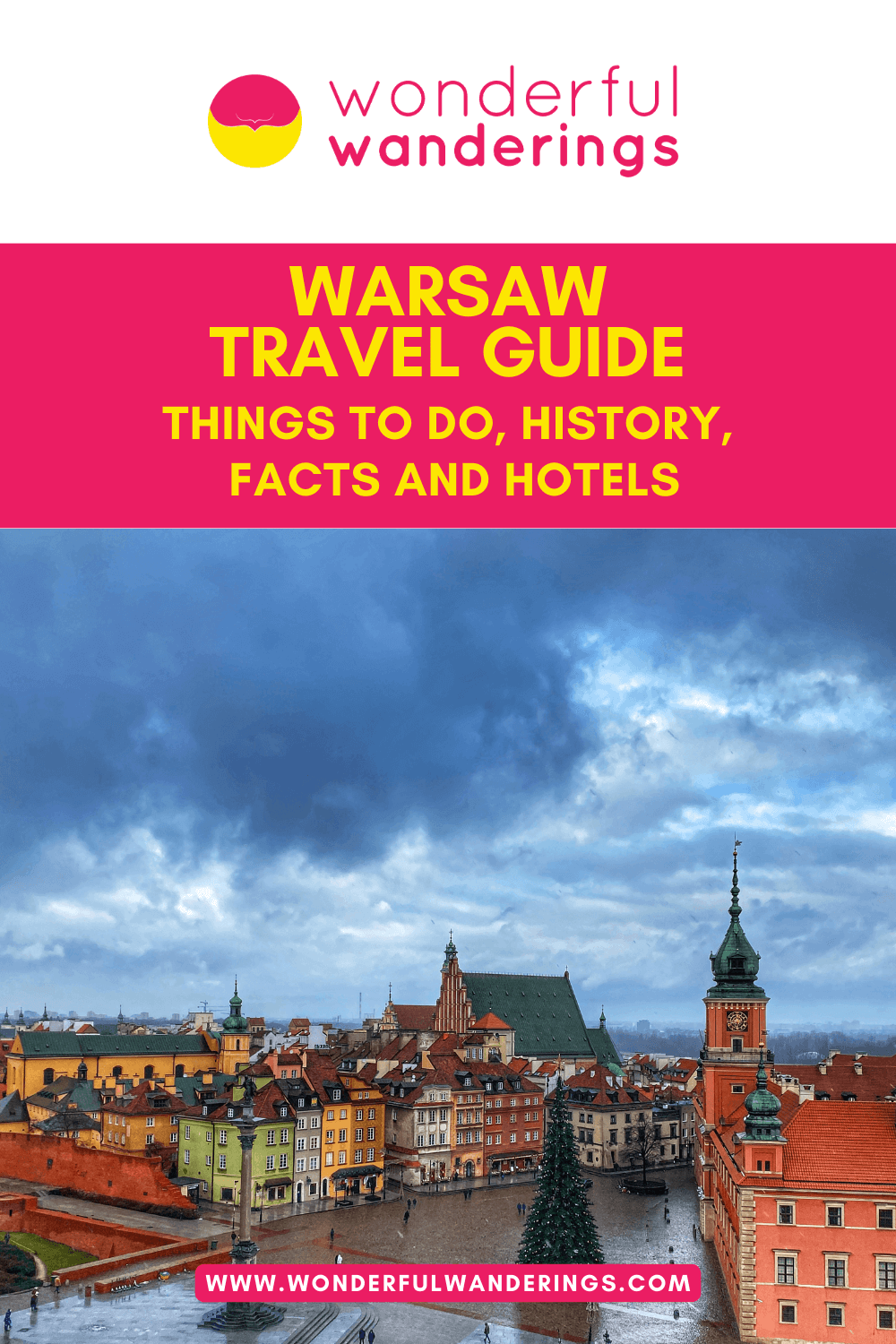
Find below our best travel guides about Poland.

24 Interesting Facts about Poland

18 Best Beaches to Visit in Poland

Renting a Car in Poland: 34 Important Tips (2024)

18 Best Castles to Visit in Poland

Prices in Poland: Is Poland Expensive?

25 Traditional Polish food and Where to Eat Them in Warsaw

36 Most Famous Polish people: Artists, Chefs and Scientists!

Dates of Holidays in Poland 2024 [Annually updated]

22 Top Festivals to Attend in Poland for 2024

Driving in Poland: Road Safety, Driving Etiquette and How to Rent a Car

Transportation Guide in Poland: Which One Is Best for You?

20 Wonderful Things to do in Gdansk: Museums, History and Travel Guide

17 Fabulous Things to do in Bydgoszcz: Museums, History and Travel Guide

19 Impressive Things to do in Krakow: Museums, History and Travel Guide

17 Best Things to do in Gdynia: Museums, History and Travel Guide

17 Best Destinations in Poland to visit all year round!

Auschwitz tour review: an Auschwitz tour from Krakow

Poland Vacation Guide – Everything to plan your trip

The editorial team at Wonderful Wanderings brings together travel experts with backgrounds in travel writing, web development and digital marketing. The team, through their collaborative effort, provides readers with relevant travel experiences and up-to-date digital content. The vast expertise within the team ensures an informative blend of travel stories and useful online travel guides and trip experiences, built on a foundation of both industry recognition and hands-on global adventures. Learn more about Wonderful Wanderings
Your email address will not be published. Required fields are marked *
Join 58,000+ other Wonderful Wanderers!
As an Amazon Associate I earn from qualifying purchases.
- 10 Places That All History...
10 Places That All History Fans Must Visit In Warsaw

From a splendid 17th century capital to virtual annihilation during World War II, Warsaw has a rich but often tragic history. Stunning royal palaces stand in stark contrast to socialist blocks of flats and monuments to the thousands who fell during 20th century battles, creating a modern day city that is virtually unrivaled in the stories it tells about the past.
1. pałac kultury i nauki (palace of culture and science).

2. Museum of the Warsaw Uprising
Museum, Building

3. Plac Zamkowy and the Royal Castle

Plac Zamkowy and the Royal Castle
Most histories of Warsaw tend to focus on the 20th century – and rightly so, considering how drastically those events shaped the city that’s seen today. However, areas such as Plac Zamkowy (Castle Square) and the Royal Castle perfectly depict Warsaw’s era as a flourishing 17th century capital. Although the area, along with most of the Old Town, was almost entirely destroyed during World War II, it was rebuilt virtually brick-for-brick in its earlier style, thus still offering a gateway to the past. The Royal Castle is teeming with lavish décor and paintings of famous Poles, and provides visitors with an insight into the time when Poland was still a monarchy. The square outside showcases Warsaw at its most beautiful, and nowadays is also a popular meeting spot full of restaurants and cafés.
Plac Zamkowy, Warsaw, Poland

Although virtually nothing remains of the Warsaw ghetto after its bombing during the 1943 Ghetto Uprising, a visit to the area that it once stood on is nevertheless a poignant experience. The recently opened Museum of the History of Polish Jews is a modern, striking centerpiece to the former ghetto, and just outside it is the Monument to the Ghetto Heroes, commemorating those who fell in the 1943 uprising. Now a predominantly residential area, tell-tale signs of the district’s tragic history can be found everywhere: the stone monument to Umschlagplatz – the square on which Jews were loaded onto vehicles transporting them to death camps – and a secluded grave for the fallen uprising fighters, are two important examples.
Museum of the History of Polish Jews, Mordechaja Anielewicza 6, Warsaw, Poland , +48 22 47 10 300
Umschlagplatz, Stawki, Warsaw, Poland
4. Uprising Monument

Uprising Monument
There are numerous monuments to the Warsaw Uprising dotted across the city, but the most famous and perhaps the most impressive is the one located on Krasiński Square, just next to the ultra-modern Supreme Court. Larger-than-life-sized figures seem to be coming up out of the ground in this monument – dedicated to those who fought and fell during the attempt to liberate the city. Other monuments, such as the chilling child-sized statue commemorating the children who fought and died in the uprising, located on Podwale Street, are also definitely worth visiting.
Plac Krasińskich, Warsaw, Poland
5. National Museum in Warsaw

6. Wilanów Palace

7. Pawiak Prison Museum
Building, Museum

8. The Tomb of the Unknown Soldier

The Tomb of the Unknown Soldier
Situated on the far side of a vast, paved square on which speakers as famous as Pope John Paul II have spoken, Warsaw’s Tomb of the Unknown Soldier, erected after World War I, is a monument to the unidentified Polish soldiers who fell during numerous wars. The curious shape of the monument is due to the tomb being located in the only surviving fragment of what was once a grand palace, which was destroyed during World War II. A poignant place, the tomb is perpetually guarded by soldiers, and is the place where Poles and foreigners alike come to pay their respects to the fallen.
Plac Marszałka Józefa Piłsudskiego, Warsaw, Poland
9. The Fryderyk Chopin Monument

Since you are here, we would like to share our vision for the future of travel - and the direction Culture Trip is moving in.
Culture Trip launched in 2011 with a simple yet passionate mission: to inspire people to go beyond their boundaries and experience what makes a place, its people and its culture special and meaningful — and this is still in our DNA today. We are proud that, for more than a decade, millions like you have trusted our award-winning recommendations by people who deeply understand what makes certain places and communities so special.
Increasingly we believe the world needs more meaningful, real-life connections between curious travellers keen to explore the world in a more responsible way. That is why we have intensively curated a collection of premium small-group trips as an invitation to meet and connect with new, like-minded people for once-in-a-lifetime experiences in three categories: Culture Trips, Rail Trips and Private Trips. Our Trips are suitable for both solo travelers, couples and friends who want to explore the world together.
Culture Trips are deeply immersive 5 to 16 days itineraries, that combine authentic local experiences, exciting activities and 4-5* accommodation to look forward to at the end of each day. Our Rail Trips are our most planet-friendly itineraries that invite you to take the scenic route, relax whilst getting under the skin of a destination. Our Private Trips are fully tailored itineraries, curated by our Travel Experts specifically for you, your friends or your family.
We know that many of you worry about the environmental impact of travel and are looking for ways of expanding horizons in ways that do minimal harm - and may even bring benefits. We are committed to go as far as possible in curating our trips with care for the planet. That is why all of our trips are flightless in destination, fully carbon offset - and we have ambitious plans to be net zero in the very near future.

Restaurants
The best polish restaurants in gdańsk.

Places to Stay
The best hotels in zakopane, poland.

See & Do
The best things to see and do in zakrzewo.

Bars & Cafes
The best craft beer bars in gdańsk.

The Best Bars in Zabrze, Poland

7 Secret Bars in Warsaw's Old Town

Guides & Tips
10 facts you didn't know about warsaw's palace of culture and science.

Food & Drink
The best things to do in poland if you love vodka.

The Best Burgers in Gdańsk

The Best 24-Hour Bars in Warsaw

The Best Polish Desserts You Need To Try

The 10 Most Difficult Polish Towns to Pronounce
Culture trip spring sale, save up to $1,100 on our unique small-group trips limited spots..

- Post ID: 422864
- Sponsored? No
- View Payload
Top 20 places to visit in Warsaw
by Noel | | Amazing food experience , Ancient and historic sites , Architecture , Good deals , Historic sites , Lifestyle Travel , Poland , Urban travel | 24 comments
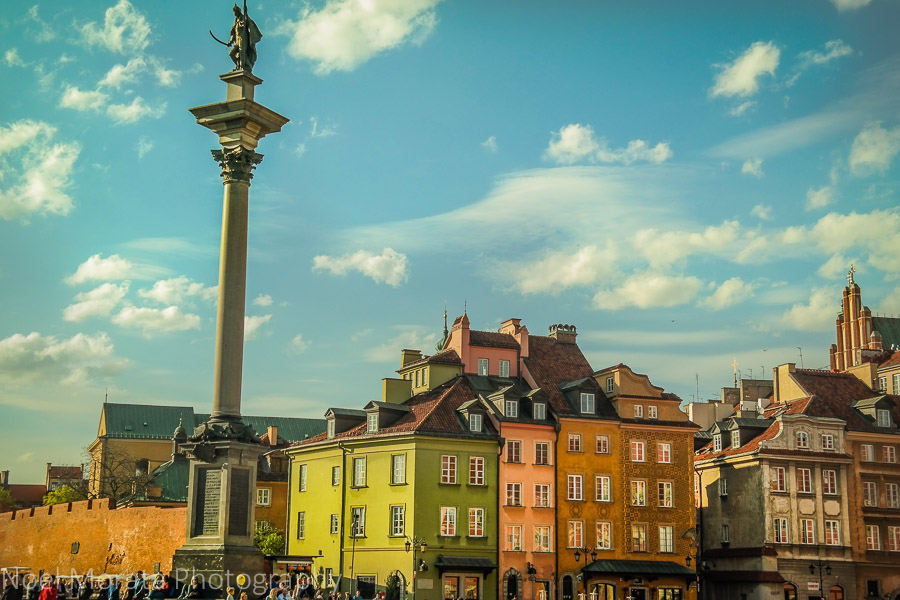
Explore the Vibrant Capital: Must-Visit Places in Warsaw, Poland(Updated 2023)
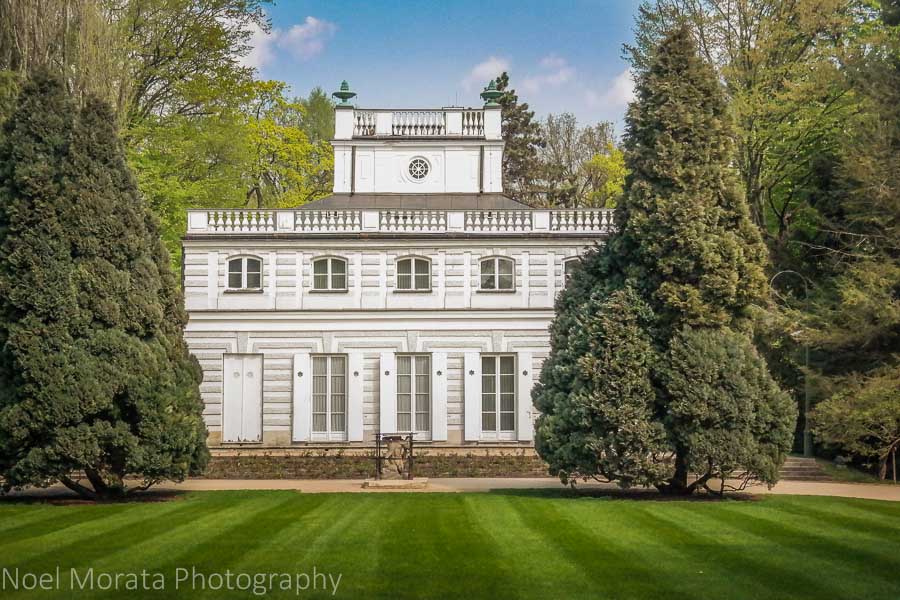
Top 20 places to visit in Warsaw, Poland
Welcome to Warsaw, the dynamic capital of Poland, where a captivating fusion of history, culture, and modernity awaits. As you enter this vibrant city, you’ll find yourself immersed in a tapestry of diverse experiences, from exploring intriguing historical landmarks to indulging in a flourishing arts and culinary scene. Warsaw, a city that has triumphed over adversity, emerged from the shadows of World War II through remarkable restoration efforts while preserving its distinctive charm and resilience.
Whether you wander through the enchanting streets of the Old Town, delve into world-class museums, or embrace the lively ambiance of bustling markets, Warsaw seamlessly blends tradition with contemporary urban life. Join us on a remarkable journey through Warsaw, where centuries-old history intertwines with the vibrancy of city living, leaving visitors inspired and eager to uncover the treasures this extraordinary destination has to offer.
There are so many fantastic things to do in Warsaw and wonderful Warsaw attractions to discover on your visit to this dynamic city in Poland. The best places to visit in Warsaw are located mostly in the historic district and easy to visit on foot while some of the outlying Warsaw attractions can be reached by uber or taxi if you are interested in seeing more of the unique spots around Warsaw not just in the central district.
Why visit Warsaw, Poland?
Visiting Warsaw, the capital of Poland, offers a diverse and enriching experience with a blend of history, culture, and modernity. Here are compelling reasons to visit Warsaw:
Historical Significance : Warsaw has a rich and tumultuous history. It witnessed the rise and fall of empires, the devastation of World War II, and the subsequent rebuilding of the city. Explore historical sites like the Warsaw Uprising Museum, which honors the city’s resilience.
Old Town Charm : Warsaw’s Old Town (Stare Miasto) is a UNESCO World Heritage Site. Stroll through its cobbled streets, admire colorful Renaissance buildings, and visit the Royal Castle. It’s a glimpse into Poland’s royal past.
Vibrant Culture : Warsaw is a cultural hub with numerous theaters, art galleries, and music venues. The city hosts international festivals, including the Warsaw Film Festival and the Chopin International Piano Competition.
Museums Galore : The city boasts a wide range of museums catering to various interests. Besides the Warsaw Uprising Museum, visit the POLIN Museum of the History of Polish Jews, the Museum of Modern Art, and the Fryderyk Chopin Museum.
Green Spaces : Warsaw offers plenty of green spaces to relax in. Łazienki Park, often called the Royal Baths Park, is a stunning park featuring a palace, a lake, and beautiful gardens. It’s perfect for a leisurely stroll.
Culinary Delights : Polish cuisine is hearty and flavorful. Savor pierogi (dumplings), kielbasa (sausage), and barszcz (beet soup). Try traditional dishes in local milk bars or dine in upscale restaurants.
Lively Nightlife : Warsaw’s nightlife scene is vibrant and diverse. Explore the bars and clubs in the Praga district, enjoy live music in jazz clubs, or experience the thriving electronic music scene.
Chopin’s Legacy : Warsaw is the hometown of the renowned composer Frédéric Chopin. Explore his legacy at the Chopin Museum and attend piano concerts featuring his compositions.
Shopping : Warsaw offers excellent shopping opportunities, from high-end boutiques in Nowy Świat Street to local markets like Hala Gwardii for unique finds and souvenirs.
Accessibility : Warsaw serves as a transportation hub, making it a convenient gateway to explore other Polish cities like Krakow, Gdańsk, and Wrocław.
Friendly Locals : The people of Warsaw are known for their hospitality and friendliness. You’ll find locals eager to share their culture and traditions with visitors.
Modern Architecture : While Warsaw honors its historical heritage, it also boasts modern architecture, including the Złota 44 skyscraper and the Warsaw Spire. The city’s skyline is evolving.
Affordability : Compared to many Western European capitals, Warsaw offers affordable accommodations, dining, and entertainment options.
Diverse Experiences : Warsaw caters to a wide range of interests, whether you’re interested in history, art, music, or simply enjoying a vibrant city atmosphere.
Visiting Warsaw provides a chance to delve into Poland’s complex history, experience its vibrant culture, and witness its dynamic transformation into a modern European capital. Whether you’re drawn to historical sites or contemporary experiences, Warsaw has much to offer to travelers.
The Best places to visit in Warsaw, Poland
Warsaw, Poland is such a cosmopolitan and urban city with lots of character, fascinating old neighborhoods mixed in with new attractions and architecture to explore these fantastic places in Warsaw. I found a visit to the capital of Poland quite inspiring and worthwhile, even though the city was completely demolished by the Nazis during World War 2. The industrious Poles have rebuilt the entire historic center, brick by brick, including some of the outlying neighborhoods of the city. With painstaking detail and hard earned work, they have rebuilt the city to up its glorious past, and have been awarded a Unesco World Heritage certification for all their efforts. It is a beautiful and cosmopolitan city and here are my top 20 places to visit in Warsaw, Poland .
Warsaw Poland FAQ
The best time to visit warsaw, poland.
Probably the best time to visit Warsaw is during their peak season from June to August when average temperatures range from the mid 60s to mid 70s during the day time. Visiting the shoulder season in spring to May or fall after September is also pleasant with temperatures ranging in the 40s to 60s. When you travel the shoulder season here in Warsaw, everything is cost effective from hotels, tours and activities being more cost competitive across the city.
Is Warsaw worth seeing?
One of the most historic cities in Poland, Warsaw was bombed during World War ll but with meticulous reconstruction of its historic city center using old materials and built to exact standards, the old town of Warsaw still received a certification as a Unesco World Heritage site with this beautiful reconstruction of the city center and many other historic sites of the city.
How many days should you take for visiting Warsaw?
Taking two days to visit Warsaw is the perfect amount of time to explore all the highlights of the city including the Old city center, beautiful parks and landscapes and important museums and other attractions. It’s fun to try the local food specialties and hang out in the many popular spots where locals also congregate.
Best ways to get to Warsaw, Poland
To reach Warsaw, Poland, you have several transportation options available:
By Air: Warsaw is served by two major airports: Warsaw Chopin Airport (WAW) and Warsaw Modlin Airport (WMI). These airports are well-connected to international destinations. From the airports, you can take a taxi, use public transportation, or arrange for a private transfer to reach your desired location within the city.
By Train: Warsaw has excellent rail connections with various European cities. The central train station in Warsaw, Warszawa Centralna, is a major transportation hub with frequent train services. You can check the schedules and book tickets in advance through the official website of Polish State Railways (PKP Intercity) or other reputable train booking platforms.
By Bus: Warsaw has an extensive network of bus connections, including international routes. Many bus companies operate services to and from Warsaw, offering affordable and convenient travel options. You can book bus tickets online or directly at the bus stations.
By Car: If you prefer driving, Warsaw is well-connected to neighboring countries and other Polish cities via highways and well-maintained roads. However, be aware of traffic regulations and parking restrictions within the city.
Once you arrive in Warsaw, the city has an efficient public transportation system consisting of buses, trams, and metro lines. You can purchase tickets at ticket machines or kiosks located at stations or use contactless payment methods on board. Taxis are also readily available, but it’s advisable to use reputable taxi companies or book through ride-hailing apps.
The best 20 places to visit in Warsaw’s cool neighborhoods and attractions
Just outside of the city center, the city is filled with vibrant neighborhoods, large green belts and beautiful parks, plenty of shopping/trendy places for locals and tourists to enjoy the day-to-day scenes in the city. Warsaw is really is a beautiful city and worth visiting when traveling through Poland, and there is plenty of places in Warsaw, fun activities and attractions to keep you busy and entertained while exploring the capital.

Palace Square in Old town
1. Palace Square in Old town
One of the cool Warsaw attractions to visit is Palace Square in the Old Town. Located in the heart of the central district and fronting the royal city palace, Palace square also known as Plac Zamkowy . Filled with outdoor cafes, fountains and shops, the square is a fantastic area to just soak in the atmosphere and enjoy people watching or even trying out some local dishes from the area.
Here’s a fascinating tour of the Palace and grounds in Warsaw
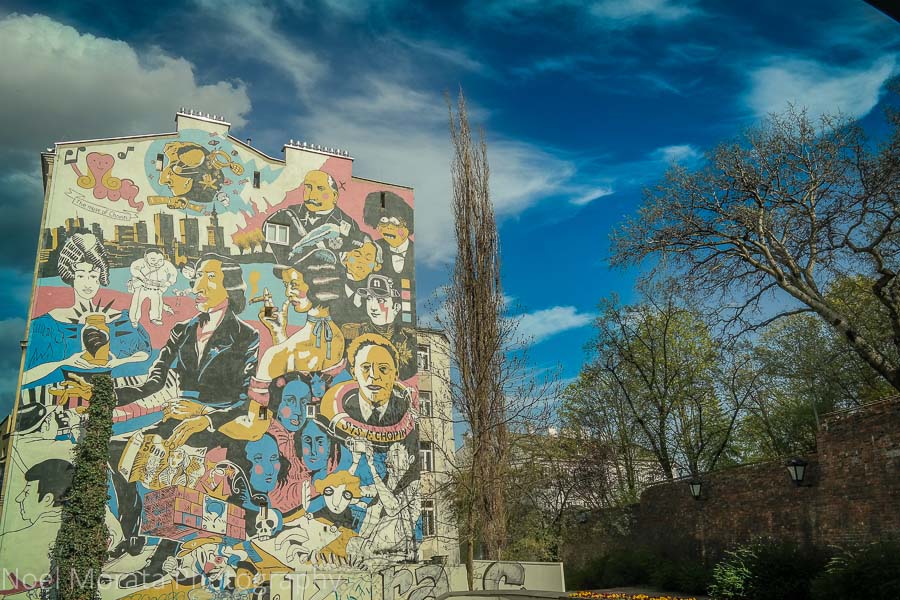
Street art in central Warsaw
2. Street art in the city
You’ll find street art popping up in so many areas especially on a large scale format. You will find lots of building sized street art (not graffiti) throughout the city and especially around the university area and shopping promenades in the city. If your interested in street art, you can pick up a visit Visit Warsaw map which shows a walking tour of some of the most popular and even prominent street art in the city that is a fun way to explore the city on foot.
Check out the Street art scene in Warsaw
3. The Warsaw Neon Museum
A cool place to visit in Warsaw is the Neon Museum. This is a fun and colorful place to visit and check out many of the historic and old neon memorabilia that have been preserved in this museum. You can check out many of the old Soviet signs that were all over the city and later stored in this large factory and eventually converted into a neon museum. You can check out the Warsaw Neon museum website here for more details.
Enjoy this fun and unique neon museum in Warsaw below
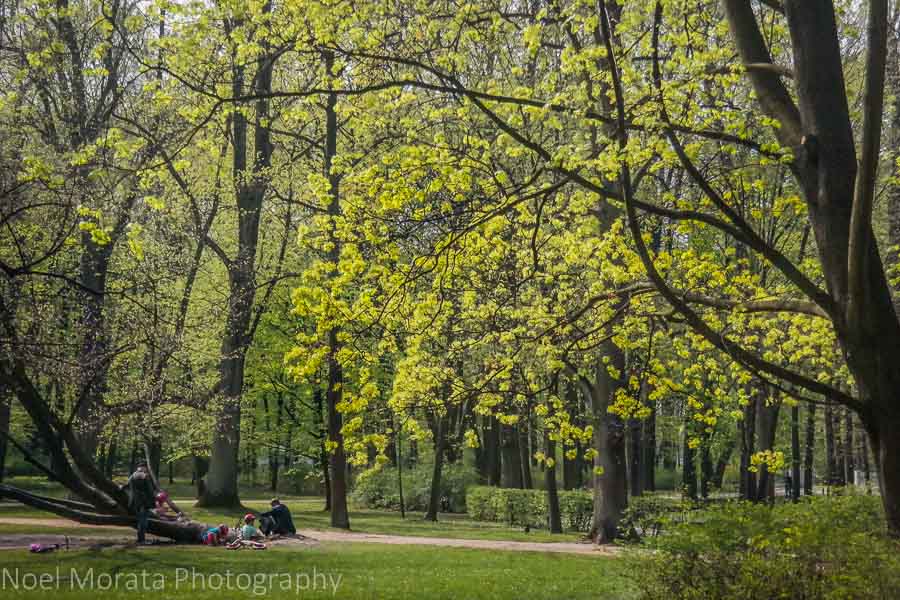
Top 20 places to visit including the parks of Warsaw
4. Visit some of the gorgeous parks in Warsaw
Warsaw has so many cool parks to hang out in the city including Lazienki park where you can take some sweet swan boats all around the large lake fronting the summer palace. Closer to the center of the city are the Saxon gardens with beautiful fountains, statues and gorgeous blooming gardens to explore and photograph.
Here’s a view of the Saxon gardens in the historic district and worth a visit or just a rest
5. Hala Mirowska
This is a very popular, local market located in a beautiful historic building. The Hala Mirowska is an old world style marketplace is where you can shop for quality meats, fish, specialty Polish products and various fresh produce at very affordable prices. There are many flower vendors, delicatessen and dessert shops that make this a fun place to explore and try out some of the specialties from the area. To find out more about the Hala Mirowska, you can visit their website here.
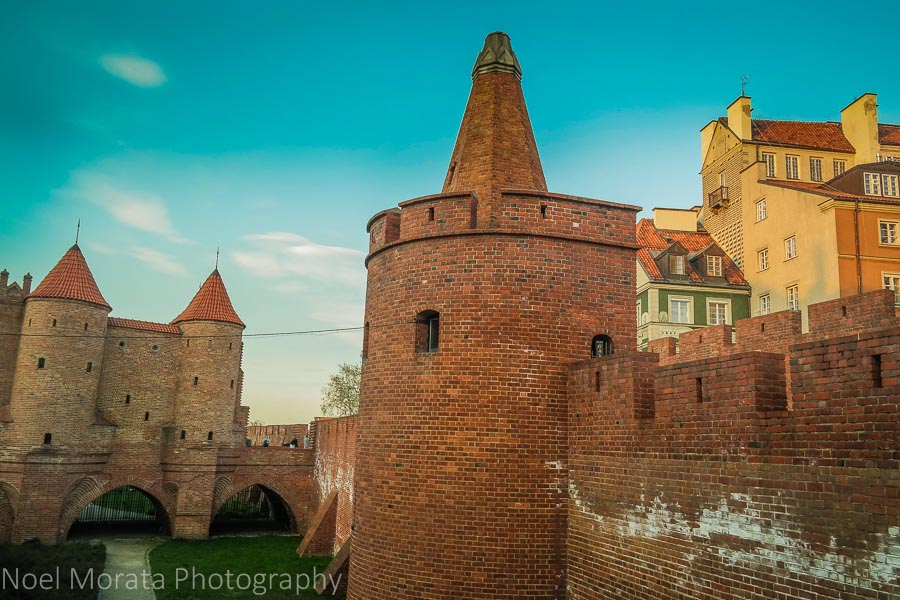
The Barbikan in the old Town of Warsaw
6. Hang out at the Barbikan
A historic area when you visit Warsaw is the old Barbikan. The Barbikan are the remains of the old city ramparts and towers – they represent the remaining relics of the historic fortifications that once encircled Warsaw. You can actually walk through many of the ramparts around the Barbikan and enjoy views outside and into the old town itself.
Here’s a tour of the Barbikan and rampart areas in Warsaw
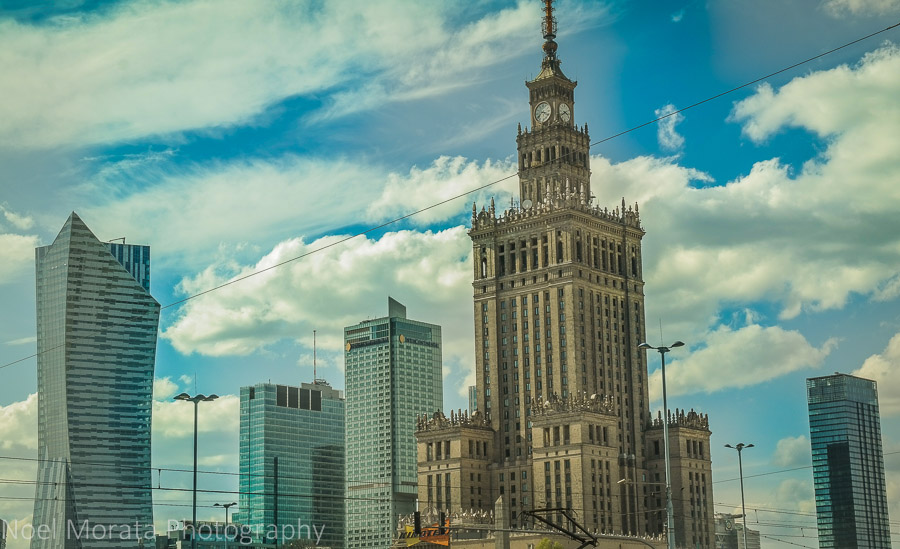
Palace of Culture and Science which is the tallest building in Central Warsaw
7. Palace of Culture and Science in downtown Warsaw
When you visit Warsaw, you’ll see the impressive Palace of Culture and Science dominating the downtown district. A gift to the city from Stalin, the Palace of Culture and Science is now a multi purpose center with cinemas, museums, exhibition centers, book shops and conference halls. Also you can take an escalator to the 30th floor for panoramic views of the entire city center and beyond for 20 PLN.
** you can check out the Palace of Culture and Science and vistas here for more information and entry.
You can get to the top for views above of the city
8. Warsaw Rising Museum
One of the things to do in Warsaw is visit museums and the Warsaw Rising Museum is one of the most popular. A must see attraction in the city, this museum is one of the most popular museums in Poland which chronicles the various time frames of Warsaw’s past and specifically before and after World War 2 when Germany invaded Poland and eventually destroyed over 90 percent of the city.
9. Tomb of the Unknown soldier at Freedom Square
Grob Nieznanego Zolnierza , just inside freedom square is located the tomb of the unknown soldier – it is in the center with a simple covered pavilion with two guards quietly standing guard. A very contemplative space, the beautiful baroque fountain and park behind it are lovely to explore with all the colorful annual flower beds in the Saxon gardens .
10. Warsaw’s Fryderyk Chopin Museum
Located in a stately Neo Classic building opposite of the university, the Chopin museum is dedicated to Warsaw’s famous composer. The museum has collections of his autographs, musical scores, photographs and personal items from his life with details about his time in Warsaw and of course listen to some of his famous compositions.
** you can check out the Fryderyk Chopin Museum here f or more information and entry.
Or experience this unique Chopin concert including a drink here for an exceptional Chopin experience to this city he loved.
Here’s a visit to the Fryderyk Chopin Museum below
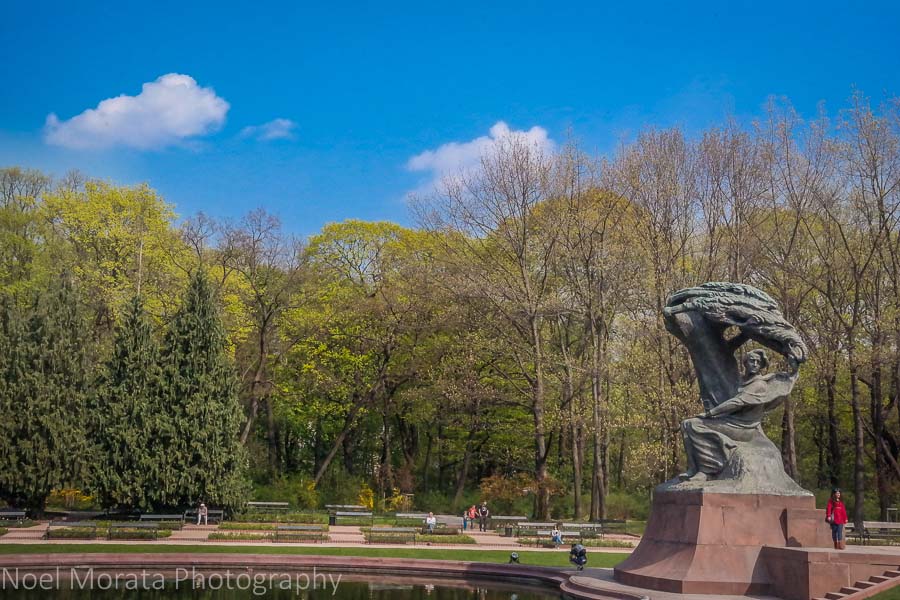
Touring Warsaw at Lazienki park and the Chopin memorial
11. Chopin monument at Lazienka park
At the entrance to Lazienka park , the large bronze statue fronting a small pond with colorful annual flowers is a quiet place to relax and even take in some free classical music on the weekends. From the monument, you can climb down a set of stairs to explore the rest of the expansive natural park below including the thermal spa and the summer Lazienka palace and some of the other landmarks.
**Check out this unique Chopin tour around Warsaw here for more inspiration and a fun guided tour.
12. Visit the Warsaw palace at Plac Zamkowy
Located centrally at Plac Zamkowy – the royal palace was completely ruined and rebuilt by the Nazis, the replica was painstakingly recreated to exact standards. All the rooms were decorated in the typical Baroque style that was very popular during the timeframe the city was built. The palace is now a museum where you can visit most of the royal chambers and other assembly rooms on an open tour or with a docent. For more information and details on a visit, you can check out their website here .
13. Warsaw’s m ulti media fountain park
A cool Warsaw attraction is the multi media fountain park. Located on the outskirts of the old town and fronting the Vistula River. You can enjoy a multi media presentation in the evenings with a water fountain and laser light extravaganza accompanied by popular artists like Lady Gaga and transitioning to famous composers like Chopin. You can check out the schedule of water performances here .
Here’s a fun highlight experience of the Multi-Media fountain below
14. Copernicus Museum
For those interested in Science and technology, this museum has many interesting exhibits and even some experiments that you can conduct on your own. You can check out more information on their website and events here .
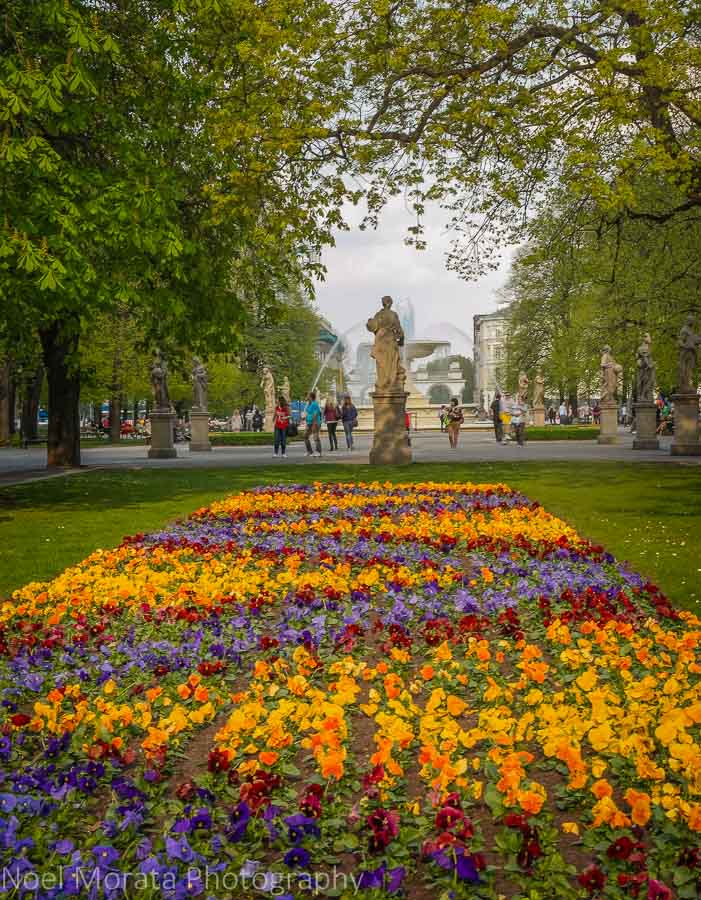
Saxon gardens in Central Warsaw, Poland
15. Saxon Gardens in the central district
One of Warsaw’s beautiful places to visit outdoors is the Saxon Gardens . Just behind the tomb of the unknown solider, this large park in the center of the city and close to the old town is a nice respite to enjoy the many beautiful gardens, statues and fountains within the park. You can also visit the tomb of the unknown soldier just in the front of the park area in an open air cement pavilion.
16. Frederic Chopin birthplace
Zelazowa Wola – which consists of his home and gardens is located at the edge of the Kampinos Forest and is a perfect getaway from the city and enjoy the area and his music being piped along the many lanes throughout the gardens
17. Warsaw Gestapo headquarters museum
A relatively small museum in a grand classical style building that was the former Gestapo headquarters. You will find the interrogation cells in the cellar and can watch some movies that document the experience and atrocities made by the Nazis when they occupied Warsaw. It’s a very somber but important part of the cities past and the messages on the cell walls tell that story well.

Jewish ghetto memorial in Central Warsaw, Poland
18. Jewish Ghetto Memorial and Jewish Museum
Fronting the Jewish museum and near the center of town is a large monument surrounded by concrete block apartments in the ghetto. The monument skillfully captures the heroic, perseverance and tragedy of the Polish Jews imprisoned in the ghetto and later deported to concentration camps. In the center of the ghetto is the contemporary Warsaw Jewish Museum which features a multi-media narrative of the Jewish community in Warsaw and celebrating over 1,000 years of existence up to the Holocaust and beyond.
Here’s a visit to the Jewish Museum and interiors below
19. Powazki Cemetery
One of the places to visit near Warsaw is Powazki Cemetery. The largest cemetery in Poland, it houses many beautiful memorials and famous Polish dignitaries and personalities. The main memorial wall by the entrance documents many of the famous people who are buried here. The expansive grounds are divided into two large sections – one primarily for Catholics, and the other for Jewish graves.
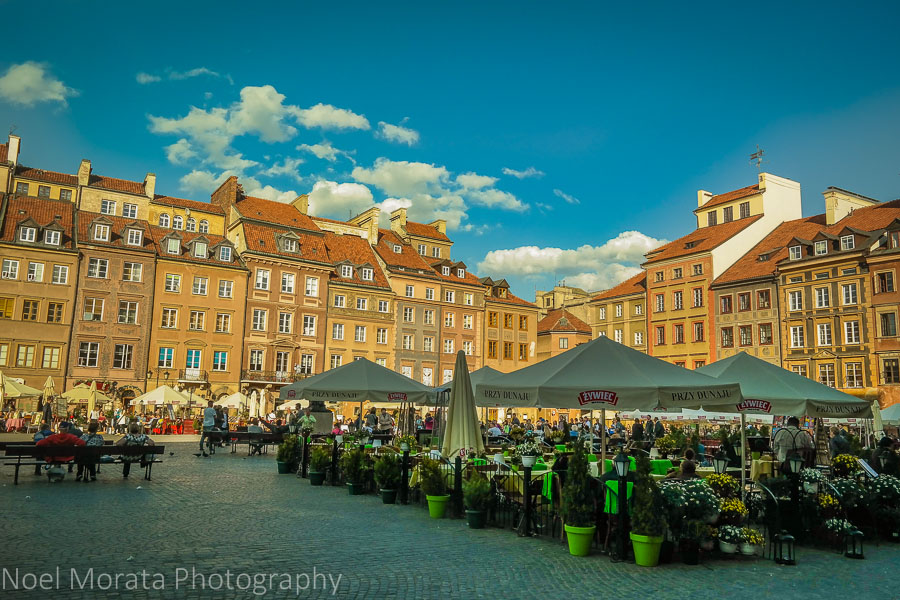
Old town square with the statue of Syrena the mermaid
20. Warsaw’s Old town square
Lunch or leisurely drinks in any of the outdoor cafes and bars surrounding this square is a fun way to enjoy the day even late into the evening. There are many performers, musicians and even Hello Kitty and Sponge Bob were walking around the square for visitors to take pictures with.
Here’s a quick video tour visiting the Old town square of Warsaw below.
How to get around Warsaw, Poland
Getting around Warsaw, the capital of Poland, is relatively straightforward, thanks to its well-developed transportation network. Here are some ways to navigate the city:
Public Transport : Warsaw has an efficient public transportation system, including buses, trams, and a metro. You can purchase tickets at ticket machines, kiosks, or through mobile apps. Options include single-ride tickets, day passes, and longer-term travel cards. The metro is especially useful for traveling quickly between different parts of the city.
Warsaw Metro : The Warsaw Metro consists of two lines: M1 and M2. It’s an efficient way to travel within the city, with frequent service during the day. Metro stations are marked with a large ‘M’ sign.
Buses and Trams : Buses and trams cover the entire city, making them convenient for reaching destinations not served by the metro. Bus and tram stops are well-marked, and schedules are available online and at stops.
Veturilo Bike Rental : Warsaw has a bike-sharing system called Veturilo, with bike stations located throughout the city. It’s a great way to explore the city’s parks and bike-friendly neighborhoods.
Taxi : Taxis are readily available in Warsaw, and they are generally safe and reliable. Look for licensed taxis with a company logo and make sure the driver uses the meter. Ride-sharing services like Uber and Bolt are also available.
Walking : Many of Warsaw’s attractions are within walking distance of each other, especially in the historic Old Town. Exploring on foot allows you to discover hidden gems and enjoy the city’s vibrant atmosphere.
River Transport : You can take a river tram on the Vistula River for a unique perspective of the city. These trams operate during the warmer months and offer a relaxing way to see Warsaw from the water.
Suburban Trains (SKM) : Suburban trains, known as SKM, connect Warsaw with nearby towns and suburbs. They are useful for day trips to places like Zegrze Lake or Grodzisk Mazowiecki.
Car Rentals : While not always necessary for getting around Warsaw itself, renting a car may be convenient if you plan to explore the surrounding regions or take day trips to places like Wilanów Palace or the Kampinos National Park. Be aware that traffic and parking can be challenging in the city center.
More insider tips to visiting Warsaw
Here’s some insider Tips for an Unforgettable Visit to Warsaw
Embrace Public Transportation: Warsaw has an efficient and well-connected public transportation system. Opt for using trams and buses to get around the city easily and affordably. Consider purchasing a travel card or pass for unlimited rides during your stay.
Discover Warsaw’s History: Warsaw is steeped in history, so make sure to explore its significant landmarks. Visit the Warsaw Uprising Museum, the POLIN Museum of the History of Polish Jews, and the Warsaw Old Town to learn about the city’s past and the resilience of its people.
Sample Polish Cuisine: Warsaw is a culinary delight, and trying traditional Polish dishes is a must. Indulge in pierogi (dumplings), żurek (sour rye soup), bigos (hunter’s stew), and Polish sausages. Explore local markets like Hala Mirowska or Hala Gwardii for a genuine foodie experience.
Enjoy Parks and Green Spaces: Warsaw is known for its beautiful parks and gardens. Take a stroll through Łazienki Park, visit the Royal Łazienki Palace, and enjoy the serene surroundings. For a more offbeat experience, explore Park Skaryszewski or the rooftop garden at the University of Warsaw Library.
Venture Beyond the City Center: While the city center offers much to see, venture out to explore Warsaw’s diverse neighborhoods. Head to Praga district for its artistic vibe and vibrant street art scene. Discover Mokotów’s charming streets or visit Wilanów Palace for a glimpse into Polish royalty.
Experience Warsaw’s Vibrant Nightlife: Warsaw has a dynamic nightlife scene with numerous bars, clubs, and live music venues. Head to Nowy Świat or Pawilony for a variety of bars and pubs. For live music and concerts, check out venues like Stodoła or Palladium.
Take Advantage of Free Walking Tours: Joining a free walking tour is an excellent way to explore Warsaw with a knowledgeable guide. These tours often cover key attractions and provide insights into the city’s history and culture. Remember to tip your guide as they work on a donation basis.
Learn Basic Polish Phrases: While many locals speak English, learning a few basic Polish phrases can go a long way in connecting with the locals and showing appreciation for their culture. Greet with “Dzień dobry” (Good day), say “Dziękuję” (Thank you), or ask for directions with “Przepraszam, jak dojść do…?” (Excuse me, how do I get to…?).
By following these insider tips, you’ll enhance your visit to Warsaw and gain a deeper understanding of the city’s rich history, culture, and vibrant atmosphere. Enjoy your time exploring the captivating capital!
More unique experiences to do around Warsaw area
There’s so many more unique and fun things you can do on a tour experience in visiting Warsaw below.
Visit Auschwitz Birkenau tour
Visit the Polish Vodka Museum and 3 tastings
Experience a Retro bus tour of the dark side Warsaw
Best areas to stay in Warsaw
If you are visiting Warsaw and all these fantastic Warsaw attractions, it is ideal to be in the city center and around the historic district so you can easily walk around the popular things to see in Warsaw and in walking distance. Check out these popular hotels in the area here you can stay at in Warsaw and some of the other top picks below.
Air Hotel – good value with comfortable clean and modern rooms, close to shopping center and free shuttles to town.
Polonia Palace Hotel – In the city center in a classic building, comfortable, clean, great breakfast service, spacious rooms and very friendly front desk service.
PURO Warsaw Centrum – located in the city center with artistic touches, modern style and comfortable rooms with spacious beds, excellent service and friendly staff.
Check out these well rated Trip Advisor hotels and inns here for current prices, reviews and availability.
Here’s what to eat in Warsaw
If you are craving traditional Polish food, street food or delicious restaurants to check out, try some of these local favorite foodie experiences below.
Pierogi: These dumplings are a beloved Polish specialty and come with a variety of fillings such as potato and cheese, meat, cabbage and mushroom, or sweet options like fruit or cheese. Pierogi are typically boiled and then served with butter, sour cream, or fried onions.
Żurek: This traditional Polish soup is made from fermented rye flour and often includes ingredients like sausage, potatoes, and hard-boiled eggs. It has a distinctive sour flavor and is often served in a bread bowl, making it a hearty and comforting dish.
Bigos: Known as hunter’s stew, bigos is a flavorful and hearty dish made with sauerkraut, various cuts of meat (such as pork, beef, or sausage), mushrooms, onions, and spices. It’s slow-cooked to develop complex flavors and is often enjoyed with a side of bread or potatoes.
Kielbasa: Polish sausage, or kielbasa, is a staple of Polish cuisine. It comes in various types, such as kielbasa wiejska (smoked sausage) or kielbasa krakowska (Krakow sausage). Served grilled or boiled, it’s a flavorful and satisfying option often enjoyed with mustard and sauerkraut.
Placki ziemniaczane: These are Polish-style potato pancakes that are crispy on the outside and soft on the inside. They are typically served with sour cream or applesauce and make for a tasty appetizer or side dish.
Sernik: Polish cheesecake, known as sernik, is a popular dessert in Warsaw. It has a dense and creamy texture, often made with farmer’s cheese (twaróg) and flavored with vanilla, lemon zest, or raisins. It’s a delightful treat for those with a sweet tooth.
Makowiec: This poppy seed roll is a traditional Polish pastry enjoyed during festive occasions. It consists of a sweet yeast dough filled with a mixture of ground poppy seeds, honey, nuts, and dried fruits. Makowiec is often served sliced, and its rich and aromatic flavors make it a true delight.
These are just a few examples of the delicious local foods to try in Warsaw. Exploring the city’s culinary scene will introduce you to a wide range of flavors and traditional dishes that showcase the rich and diverse Polish cuisine. Enjoy your culinary adventures in Warsaw!
Where and what to eat in Warsaw
Street foods in Warsaw
Where to go for brunch, snacks and dinner in Warsaw
If you enjoy this, please pin it!
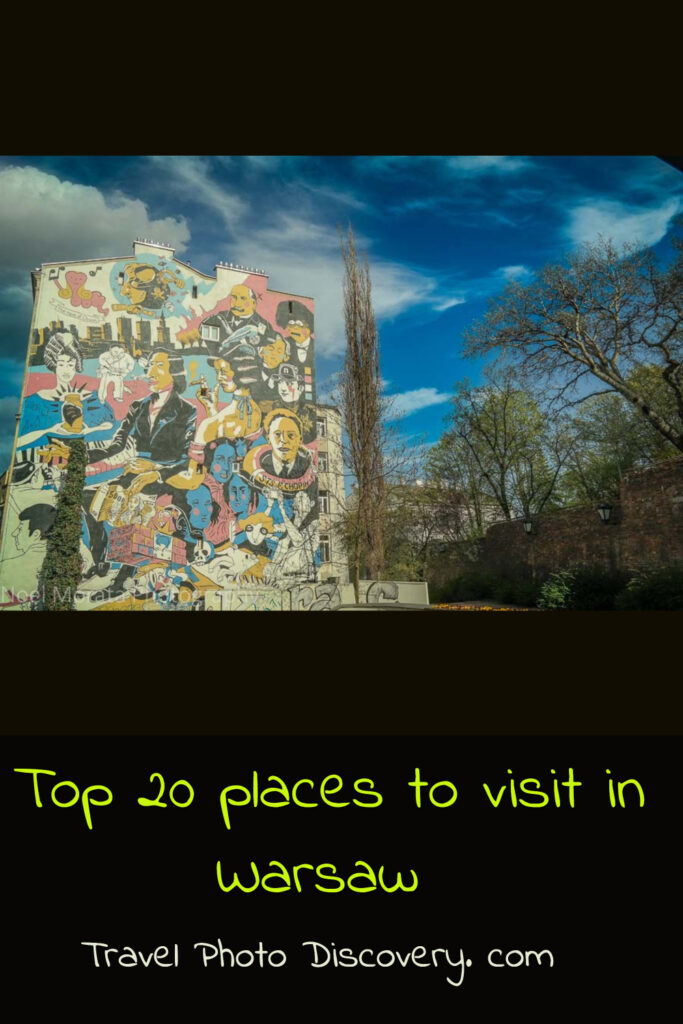
Weather and best times to visit Warsaw
Warsaw experiences a continental climate with distinct seasons. The best time to visit Warsaw depends on your preferences for weather and activities:
1. **Spring (April to June):** Spring is a lovely time to visit as the city comes alive with blossoming trees and flowers. The weather is mild, with temperatures ranging from 10°C to 20°C (50°F to 68°F). It’s an excellent time for sightseeing and outdoor activities, and you’ll encounter fewer tourists compared to summer.
2. **Summer (June to August):** Summer is the peak tourist season in Warsaw. The weather is warm to hot, with temperatures averaging between 20°C and 30°C (68°F to 86°F). This is the best time for outdoor festivals, concerts, and exploring parks and gardens. Be prepared for larger crowds and higher prices.
3. **Autumn (September to November):** Early autumn is a pleasant time to visit, with mild temperatures ranging from 10°C to 20°C (50°F to 68°F). The city’s parks showcase beautiful fall foliage, and it’s a great time for cultural events and museums. As autumn progresses, temperatures cool, and you can experience crisp weather and fewer tourists.
4. **Winter (December to February):** Winter in Warsaw can be cold, with temperatures often dropping below freezing. Snow is common, making it a picturesque time to visit if you enjoy winter activities and holiday markets. The city is less crowded, and you can experience a quieter, more intimate side of Warsaw.
In summary, the best time to visit Warsaw for pleasant weather and fewer crowds is during spring and early autumn. If you prefer warm weather and are excited about outdoor events and festivals, summer is a vibrant time to explore the city. Winter offers a unique charm and is ideal for those who enjoy winter activities and a cozy, festive atmosphere.
Further places to visit in Poland
A first impression of Krakow, Poland
Touring Warsaw
Touring Krakaw at night
Krakow Highlights in one day
Conclusion on Top 20 places to visit in Warsaw
Visiting Warsaw, Poland promises an extraordinary experience that seamlessly blends history, culture, and vibrant urban life. From the captivating streets of the Old Town to the poignant reminders of the city’s resilience, Warsaw invites you to explore its diverse attractions and immerse yourself in its rich heritage.
As you stroll through the charming neighborhoods, indulge in traditional cuisine, and discover the fascinating museums, Warsaw’s unique character will leave a lasting impression. The city’s efficient public transportation system ensures convenient access to its many treasures, while friendly locals and a warm atmosphere create a welcoming environment for visitors.
So you can see that there are plenty of things to do and explore in Warsaw. I hope you enjoyed this post on my Top 20 places to visit in Warsaw . If you like it, can you please share the post with any of the social media buttons located around the post. Thank you so much and I hope you have a fantastic visit to Warsaw, Poland.
Disclosure – some of the links above are to affiliate sites that are either reviews or recommendations if you book helps to keep our site running. We appreciate your supporting our website meanwhile
Sharing is caring!
24 Comments
Beautiful photos and very nice recommendations – you made me want to go to Warsaw again:) I am actually planning on going there, possibly in few weeks. I think that Warsaw is incredible place, and there are so many amazing places, that it is impossible to get bored. Last time my friends have organized a reunion, and we went to a really great bar called Bubbles in the Old Town. We had a delicious dinner with champagne degustation. It was an unforgettable evening in a really unique atmosphere.
Great list, perfect for any traveller:) I have been to Warsaw few times and I love discovering new places every time I go there. Last time my boyfriend took me on a date to a restaurant in Mokotow. It was called the Akademia. I loved it in here. The atmosphere was very romantic and cozy, while their food was also incredibly delicious. I would love to go to Warsaw again soon, and I will for sure visit this restaurant too!
Great article! I love Warsaw and I try to visit it at least few times a year, especially that I have many friends living there. I love the Old Town, it is so beautiful and I always find there new places that I haven’t seen yet. I also love to try different restaurants every time I visit Warsaw. Last time my friend took me to New Orleans – I was not really sure, because I heard that it is a night club. It appeared that they also have a restaurant and what is more, a great one! They serve food from all over the world and everything I tried was delicious. You can even ask them to make you a dish that thay don’t have in menu! Amazing place, with delicious food and great atmosphere, i will definitely visit them again:)
Hi, thanks for a great tips, I will definitely use them on my next trip to Poland:) Warsaw has also great night clubs. I have friends in Warsaw and we always go clubbing when I visit them 🙂 My personal favourite is New Orleans, because it is more elegant and not as crowded as others. They have great atmosphere and really amazing and luxury atmosphere
Thank you very much for the list. It made me excited for my upcoming trip.
Great list! The Palace Square looks like such a quaint town. Thanks for sharing!
There’s no end to the nooks and crannies to discover all over Europe. Such great history. No.20 is the best. There’s something about the public square in European cities. Just hanging out with an afternoon drink, people watching. Nothing like it in the US.
We loved Warsaw when we stayed for a long weekend a few years back and were lucky enough to have a view of the Palace of Science and Culture from our room in the hotel over the road. Never got tired of that place, although I know the locals weren’t so happy about the gift from Stalin. It looks like it comes straight from Gotham city!
I’m really annoyed with myself reading through this post. You know when you take really bad advice from people who have been somewhere and tell you not to bother? I was told Krakow was great and beautiful (I visited and agree) but to miss out Warsaw because it was an ugly concrete city. Then I see your photos and all of the great places and things to do. I definitely need to visit one day now. Thanks for showing me this side of Warsaw
I always spent my half an hour to read this blog’s posts every day along with a mug of coffee.
Looks like I would be able to spend more than a week there 🙂
So much to see – looks like the perfect place to see on foot in the spring or early summer
I think I will just follow you around the world Noel, you see and share some beautiful places and Warsaw is no exception.
I love everything about Poland. Wish I could come back to see Warsaw this time.
What an interesting and eclectic city. I love the photo with the flowers, and the city with the old and modern buildings. The street art is so intricate and colorful. I have never been to Poland, but I hope to someday. Some of my family history traces back to this country.
Some great options in Warsaw here. I like the look of the street art and would enjoy walking around looking at that and a bit of time people watching in the old town square over a cuppa would definitely be needed afterwards.
I’ve never thought of visiting Warsaw but it looks like a lovely city and very interesting too. Thanks for putting it on my radar.
Ah! I’ve been eyeing Poland for a while now so your post here is very handy! I appreciate all the tips and I hope to visit them soon in the future!
I like the fact that the older building from Stalin is still higher than the modern office blocks! Great ideas for if I ever get to Warsaw!
Great list! I always love checking out street art and I can imagine that Warsaw would have some great art! Would love to check out the neon museum too–we visited the one in Las Vegas and had a great time!
I’ve had so many people recommend a trip to Warsaw recently and I have to say that I wasn’t sure – but your post makes me realise just how much there is to do. Brilliant stuff and very appealing.
Great sharing. I do have a special interest for Poland since my wife is from there. Warsaw has great examples of monuments and architecture and I personally find it quite a pleasant city.
A lot of places to visit in this city. Thanks for all your recommendations.
Noel, this is such good timing, I’m planning a trip to Poland this summer and looking for recommendations. I’m pinning this to my planning Poland board and will be checking everything out properly in due course Thank you for writing this! I can’t wait to explore such an important part of Europe. #TPThursday
Trackbacks/Pingbacks
- Tourism in Poland- What you should know before your trip - Tourism Teacher - […] aspect of the city and having plenty of things to do there – for instance, there are more than…
- 30 Best Day Trips From Prague - Europe Up Close - […] palace at Plac Zamkowy.But if you want to stay a little longer, check out more of these wonderful places…
Submit a Comment Cancel reply
Your email address will not be published. Required fields are marked *
This site uses Akismet to reduce spam. Learn how your comment data is processed .
Hi, I'm Noel, a writer and photographer based in San Francisco and Hawaii. I write about delicious food and wine indulgences, thoughtful luxury, and adventure travel. I share camera tips and techniques while exploring new and unusual places around the world. My site explores culture and history, art and architecture, world heritage sites, exotic locals, along with nature tours and natural landscapes worldwide. Quite a mixed bag of curiosities and quirky interests, just like myself.
Posts by category

IMAGES
VIDEO
COMMENTS
2023. 3. POLIN Muzeum Historii Żydów Polskich. 4,253. Speciality Museums. The POLIN Museum of the History of Polish Jews is the first and only museum dedicated to restoring the memory of the civilization created by Polish Jews in the course of a millennium.Museum's building faces the Monument to the Ghetto Heroes in Warsaw.
To see it, take the Royal Route, which threads through royal properties like Łazienki Park, a little world of palaces and pavilions in the middle of the city. Let's explore the best things to do in Warsaw: 1. Old Town. Source: fotorince / shutterstock. Old Town, Warsaw.
Holly Johnson|Alissa Grisler November 10, 2023. Ranking of the top 9 things to do in Warsaw. Travelers favorites include #1 Old Town (Stare Miasto), #2 Lazienki Królewskie Museum (Muzeum Lazienki ...
5. Wilanow Palace. Nestled in the Wilanów district of Warsaw resides one of the country's most significant historical buildings - Wilanów Palace. Commissioned by King John III Sobieski in the late 17th century, the palace served as a royal residence and embodied the splendor of Poland's golden age.
One of the best examples of Polish Baroque architecture in Warsaw, the Wilanów Palace used to be the summer residence of King Jan III Sobieski, before being turned into the first Polish museum in 1805. The palace is lavishly decorated and is surrounded by magnificent Italianate gardens. 8. Warsaw Fotoplastikon.
Łódź. Discover the best attractions in Warsaw including Wilanów Palace, Palace of Culture & Science, and Royal Castle.
You can eat a meal in one of the numerous restaurants that serve up anything from Italian to Hawaiian cuisine or buy fresh produce and prepare dinner at home. With martinis for just £3.50 it ...
Top Things to Do in Warsaw - Warsaw Must-See Attractions. Things to Do in Warsaw. Explore popular experiences. See what other travellers like to do, based on ratings and number of bookings. See All. Nightlife (6) City Tours (65) Speciality Museums (47) Dining Experiences (10) Walking Tours (151)
Top 10. Warsaw is a city full of attractions. You will find the atmospheric Old Town, magnificent royal palaces, museums that tell the history of Warsaw and Poland, and the bustling boulevards on the Vistula. Discover the capital's biggest attractions. Must see in Warsaw - Old Town, Royal Łazienki Museum, Wilanów, Warsaw Rising Museum ...
Visit the Warsaw Uprising Museum. By Kami from My Wanderlust. Warsaw Uprising Museum is one of the most interesting museums in Warsaw and a must-visit. It's dedicated to the 1944 Warsaw Uprising, a tragic 63-day event during WWII. It was one of the most important events in the history of Warsaw when the local people tried to fight the Nazi ...
The Warsaw Uprising Museum is a must-visit destination for anyone interested in history, politics, or social justice. SEE TICKETS. 8. Stop by St. Anne's Church. St. Anne's Church is a stunning Baroque church located in the heart of Warsaw's Old Town. Built in the 18th century, St. Anne's Church has survived war and reconstruction to remain one ...
2023. 3. POLIN Muzeum Historii Żydów Polskich. 4,253. Speciality Museums. The POLIN Museum of the History of Polish Jews is the first and only museum dedicated to restoring the memory of the civilization created by Polish Jews in the course of a millennium.Museum's building faces the Monument to the Ghetto Heroes in Warsaw.
Old Town. Ironically only about 70 years old, Warsaw's Old Town is a UNESCO World Heritage Site and the perfect place to stay when you're visiting for the first time. Places to visit: Get a history lesson at the Royal Castle. Try some culture at the Adam Mickiewicz Museum Of Literature.
Visit the Royal Castle. Warsaw's Royal Castle is situated in the Old Town on the beautiful Castle Square. It was a residence of the Polish royalty between the 16th and 18th centuries. The castle was completely destroyed by the German army during World War II and, because of the Communist regime, it was only reconstructed in the 1980s, but it ...
Exploring the Unmissable and best attractions in warsaw. 1. Unlock the Secrets of Warsaw's Renowned Chopin Museum Chopin Museum . The Chopin Museum is a museum in Warsaw, Poland dedicated to the life and works of the famous Polish composer and pianist, Frédéric Chopin. The museum is located in the Ostrogski Palace, which is a historic 17th-century mansion that has been renovated and ...
The historic Powązki Cemetery is a must-see for visitors wanting to pay their respects while taking in elaborate Polish tombstone architecture and art. 17. University of Warsaw Library Roof Garden. The University of Warsaw Library Roof Garden is in Warsaw, Poland, at Dobra 56/66, 00-312 Warsaw.
2023. 3. POLIN Muzeum Historii Żydów Polskich. 4,252. Speciality Museums. The POLIN Museum of the History of Polish Jews is the first and only museum dedicated to restoring the memory of the civilization created by Polish Jews in the course of a millennium.Museum's building faces the Monument to the Ghetto Heroes in Warsaw.
Other monuments, such as the chilling child-sized statue commemorating the children who fought and died in the uprising, located on Podwale Street, are also definitely worth visiting. Plac Krasińskich, Warsaw, Poland. 5. National Museum in Warsaw.
10 Best Things to Do in Warsaw. Stroll Around the Old Town Market Square. Check Out St. John's Archcathedral. Go Up St. Anne's Church Observation Deck For the Sunset. Learn the Tragic History of Warsaw at Warsaw Uprising Museum. Visit the Royal Castle of Warsaw. Enjoy the Scenery at Lazienki Park.
15. Saxon Gardens in the central district. One of Warsaw's beautiful places to visit outdoors is the Saxon Gardens. Just behind the tomb of the unknown solider, this large park in the center of the city and close to the old town is a nice respite to enjoy the many beautiful gardens, statues and fountains within the park.
Top Things to Do in Warsaw, Poland - Warsaw Must-See Attractions. Things to Do in Warsaw. Explore popular experiences. See what other travellers like to do, based on ratings and number of bookings. See All. Nightlife (6) City Tours (65) Shopping Malls (28) Dining Experiences (10)